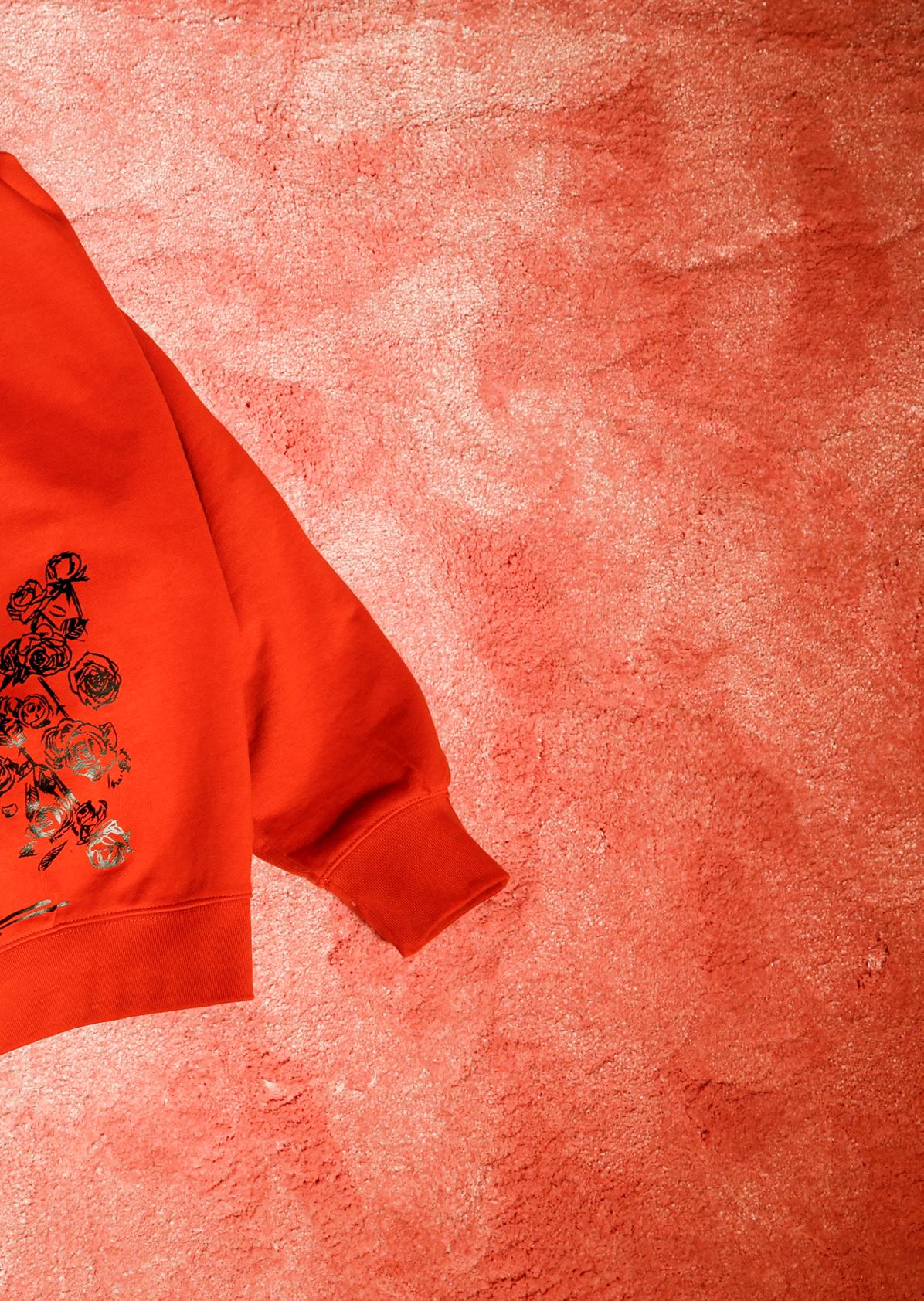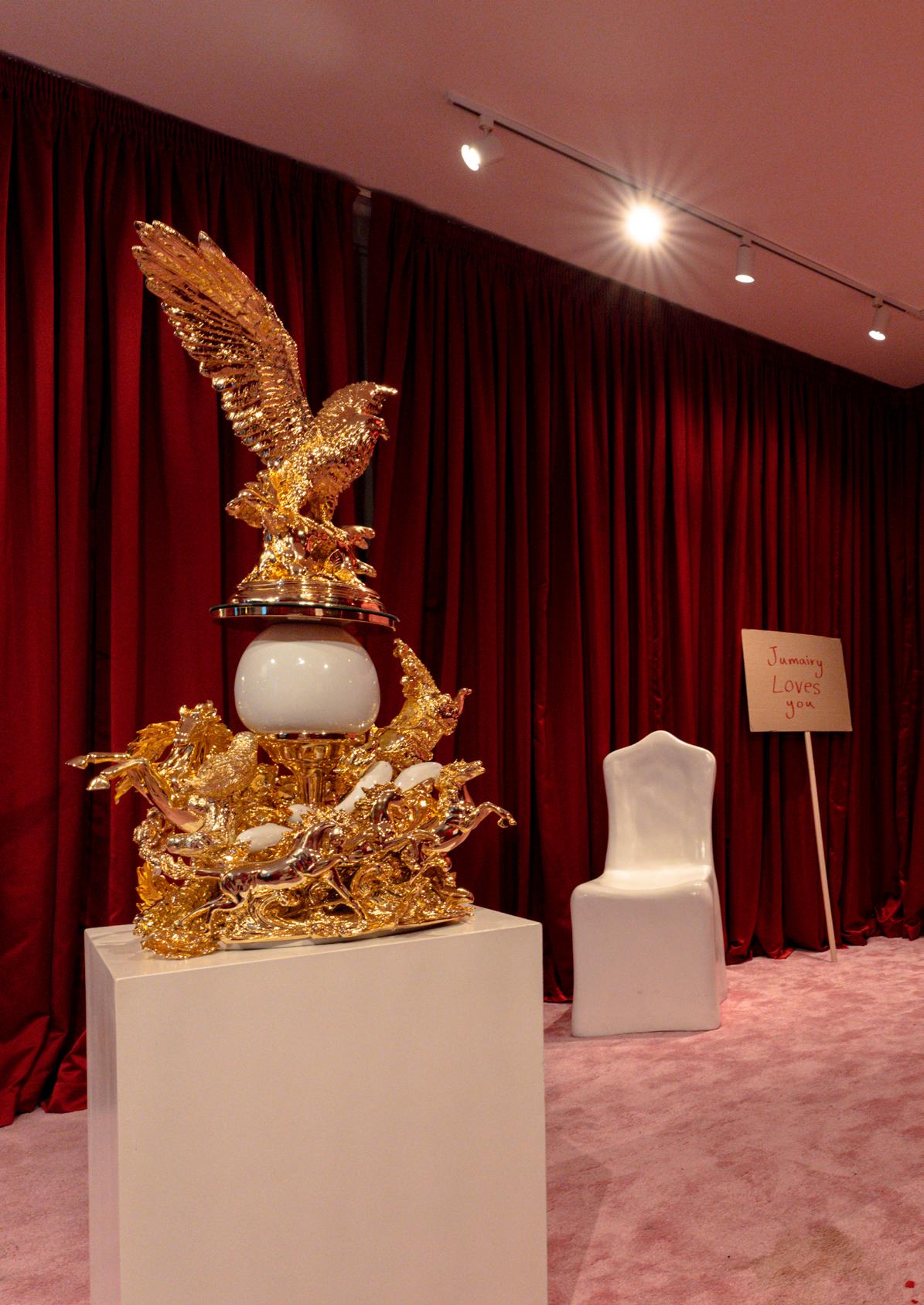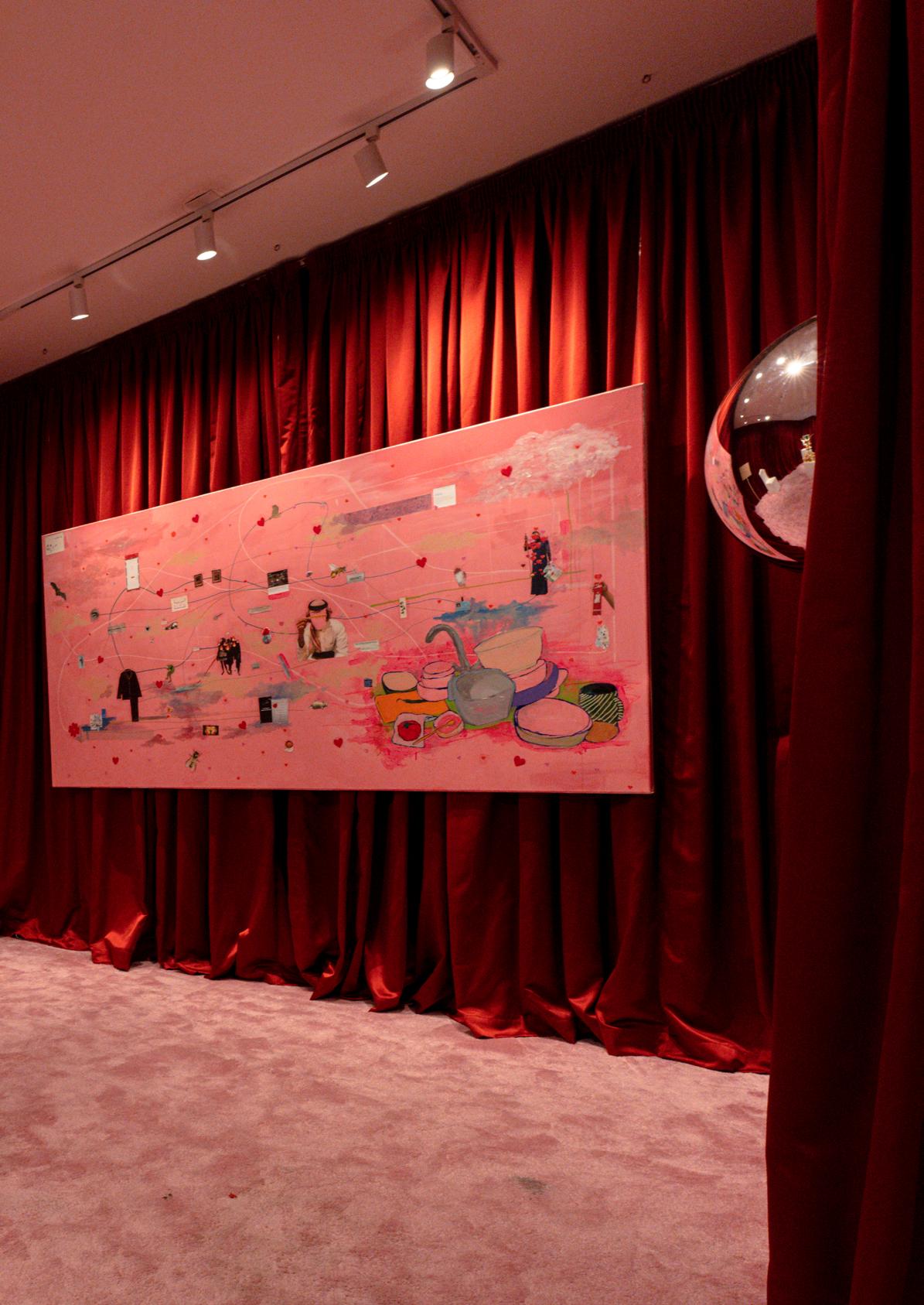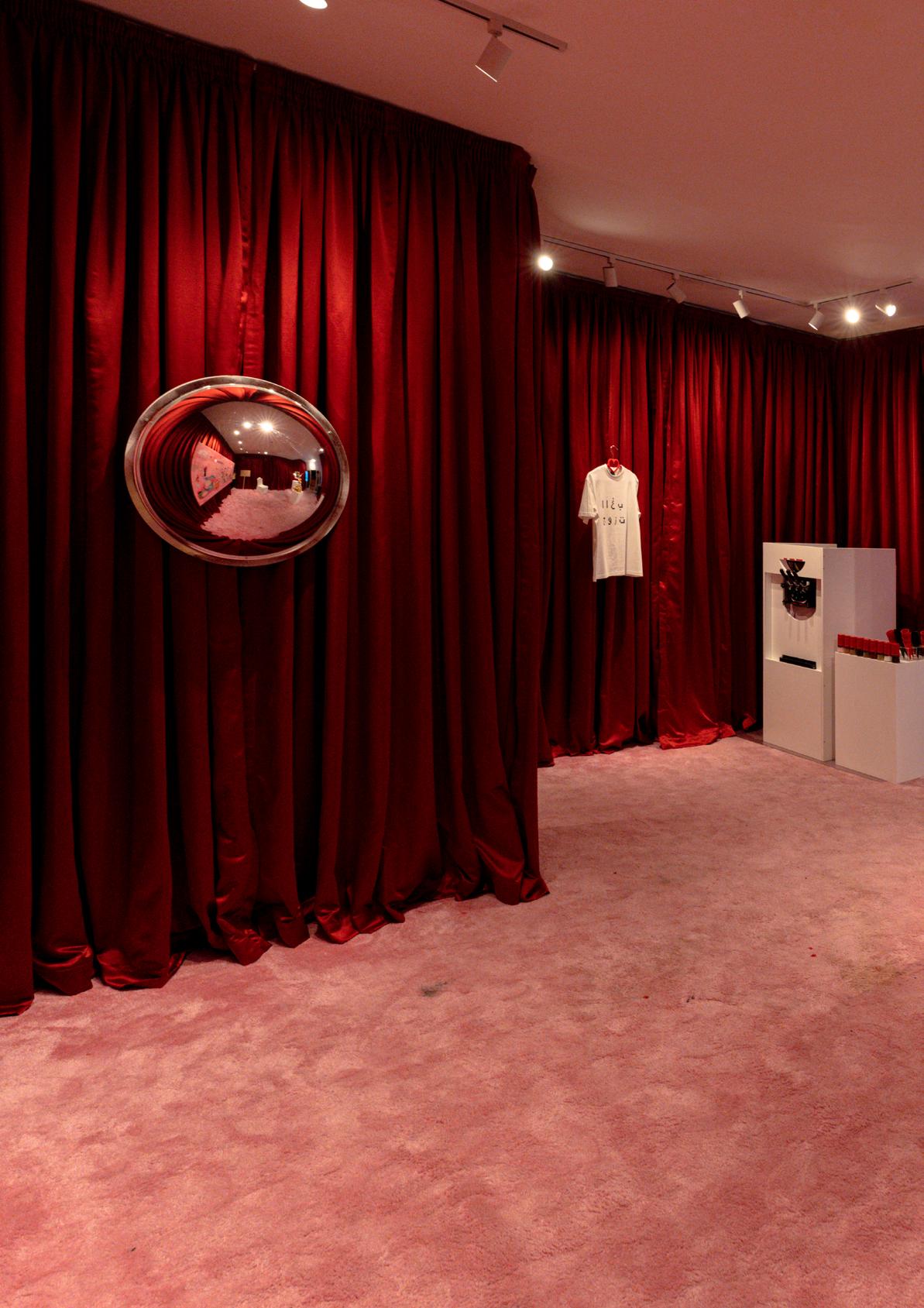
Special thanks to Océane Sailly (Hunna Gallery), HRH Prince Saud bin Bader and Athr Gallery for loaning artwork
Thanks to Amir, Noor and their teams for fabricating the artwork and the exhibition design
Thanks to Maan Algarzae
Thanks to Afnan Alrowais, Eyad Tawfeeq, Lenh Alghamdi and Sultan Nasser
Thanks to Mohammed Anaizan and Marc Matta
Thank you to Maha Alsudairy and Alanoud Alsudairy for their emotional support
The visual identity, marketing campaign and photography is all developed in-house by
Alaa Tarabzouni & Fahad bin Naif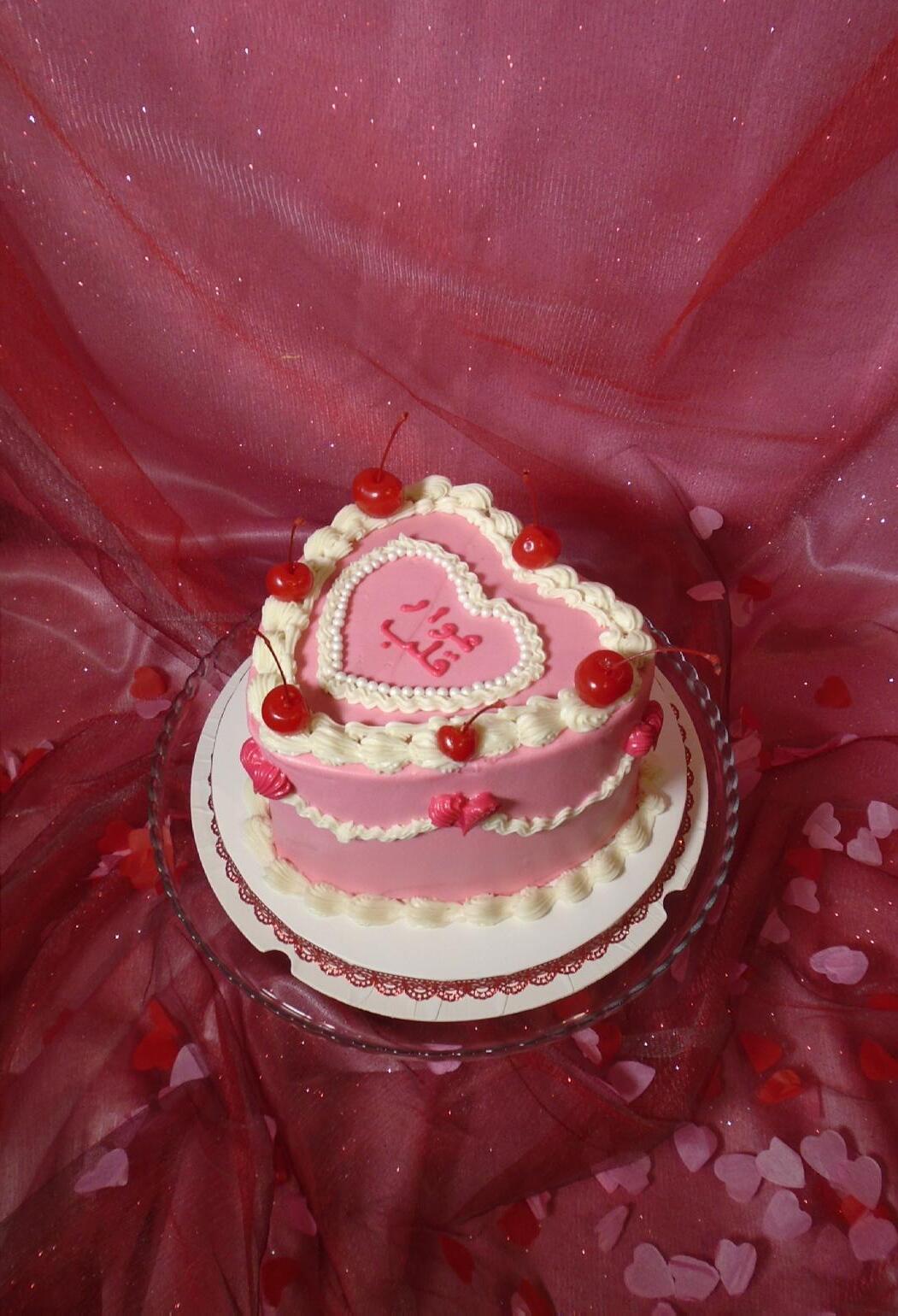

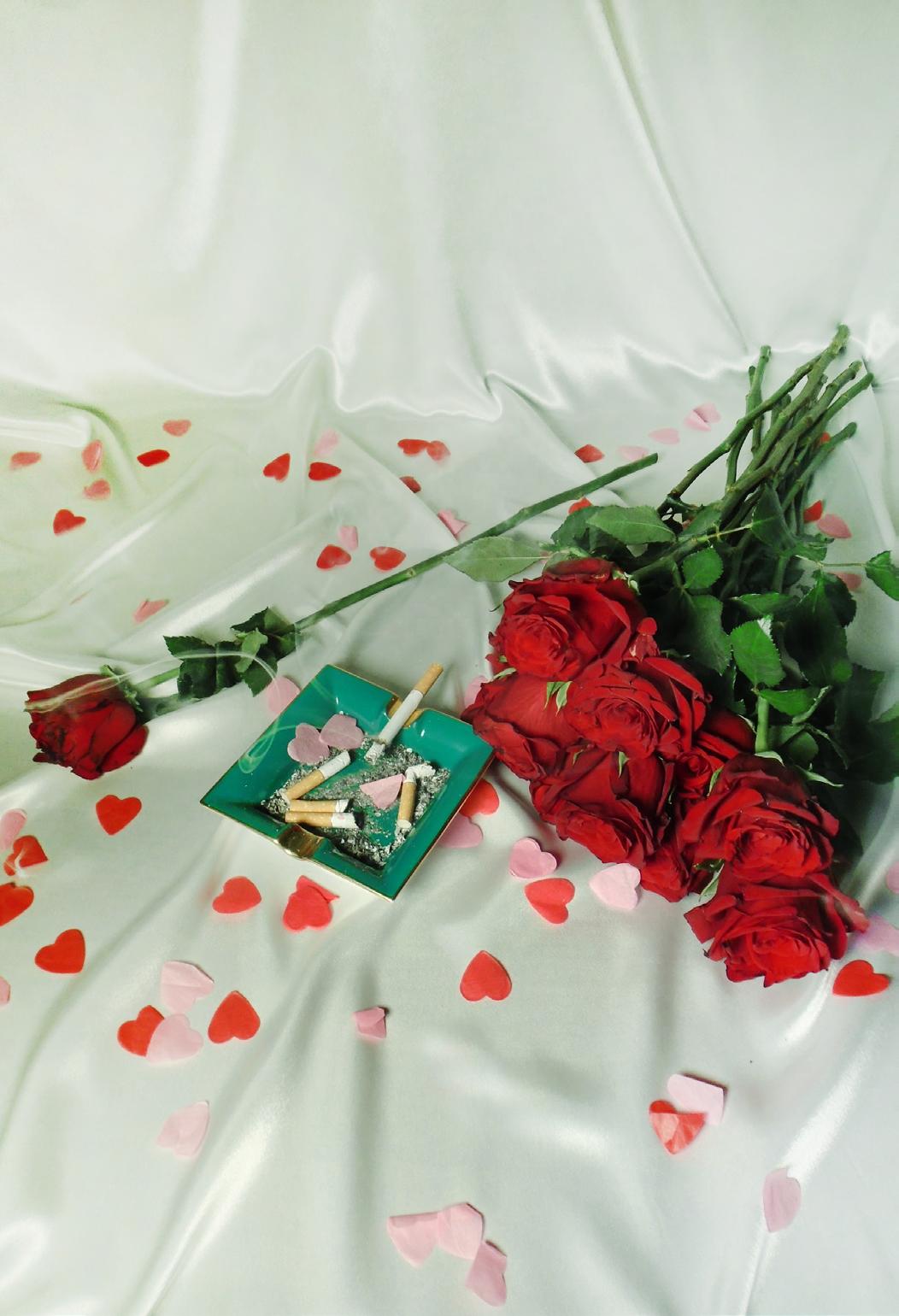
Broken heart syndrome1 is commonly described as a physical pain in the chest, heart or stomach area, which is due to the emotional stress caused by a traumatic breakup or the death of a loved one. In Heartache the artists were asked to explore how heartbreak consumes us and how it could be manifested physically. Due to the highly personal nature of heartbreaks, the varied responses of the participating artists to the brief offers an insight into the solitary nature of this feeling yet solace and comfort in the reality of the unavoidable and collective nature of it.
The explorations in the show transcend the strictly romantic notions of heartbreak, through their works the artists broadened the spectrum of this understanding through the truly nuanced interpretations of heartbreak that range from; commentary on the abundance of choices of possible partners or lack thereof, to missed encounters. Really probing the sometimes-irrational seeming facets of heartbreak such as the longing of a wasted potential. While some pieces are a look to the more agonizing investigation of loss, such as marital breakups and their consequences and the forbidden love. On the other hand, some artists chose to examine a more lighthearted take to love and heartbreak by exploring the often awkward yet endearing and always irrational sides of love such as flirting and virtual romances.
Heartache aims to highlight moments of which we are the loneliest and the most vulnerable in the solitary experience while showcasing it publicly in a group show setting to emphasize the shared reality and commonality of this feeling. The show offers a cathartic journey to explore Heartache in a vulnerable yet voyeuristic setting; making the domestic nature of the studio, being in a residential building, a crucial backdrop for the show. The familiarity of the setting encourages one to drop their guard and vigilance and to surrender to vulnerability of the collective catharsis.
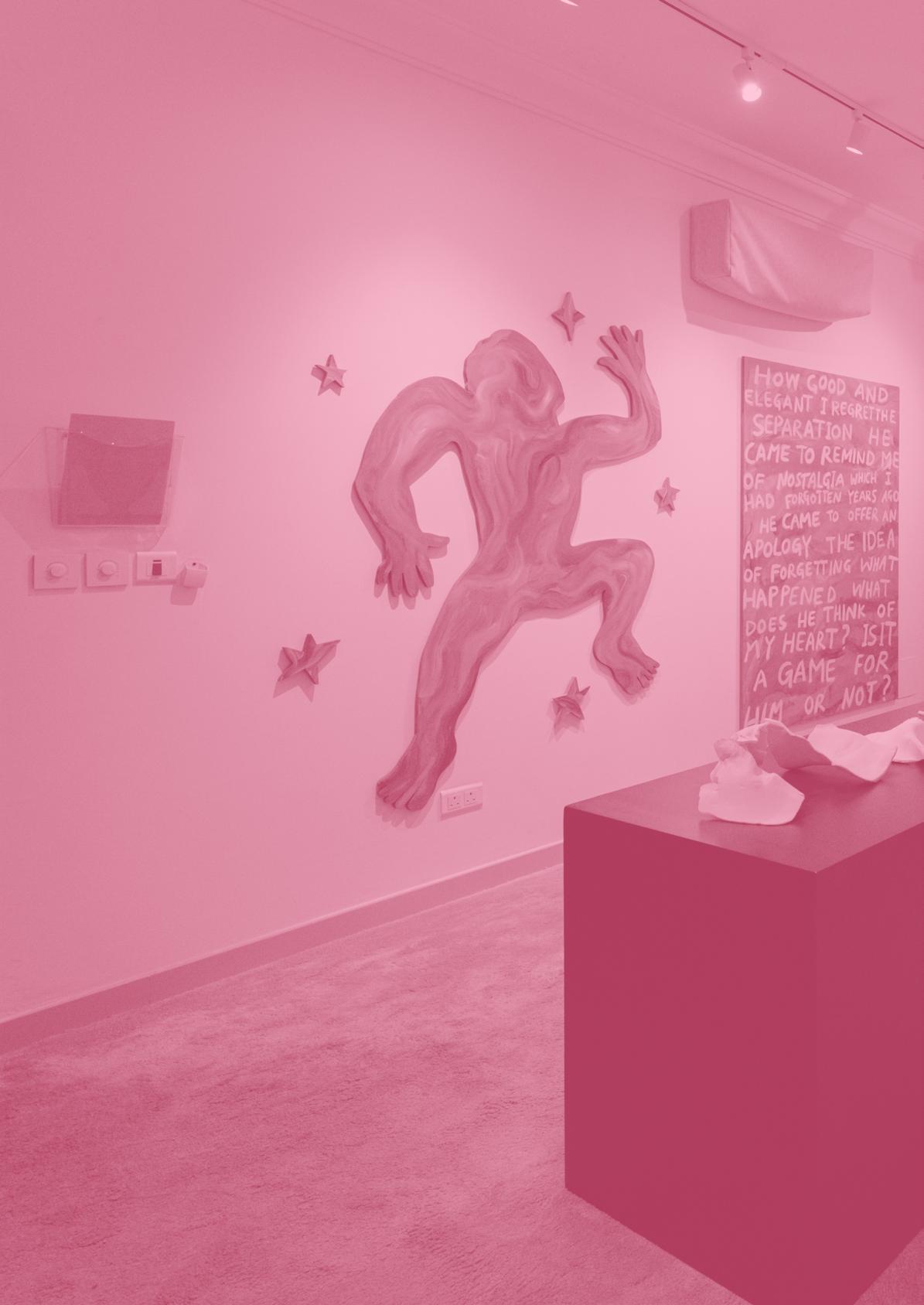

Aziz Jamal
Members Only (2023)
Ink on canvas
235 x 160cm
The wall is used as a reference in two ways; as a stand in for the futile endeavors of online dating materializing literally “hitting a wall”. As well as being a reference to walls built around your heart as a result of the bleakness of online dating. Additionally, the physical labor of the tedious task of tiling a wall is echoed in the repetitive method of printing the ink on the canvas; this is used as a way to symbolize the jaded and formulaic attitude toward online human connection.
Text supplied by artist.
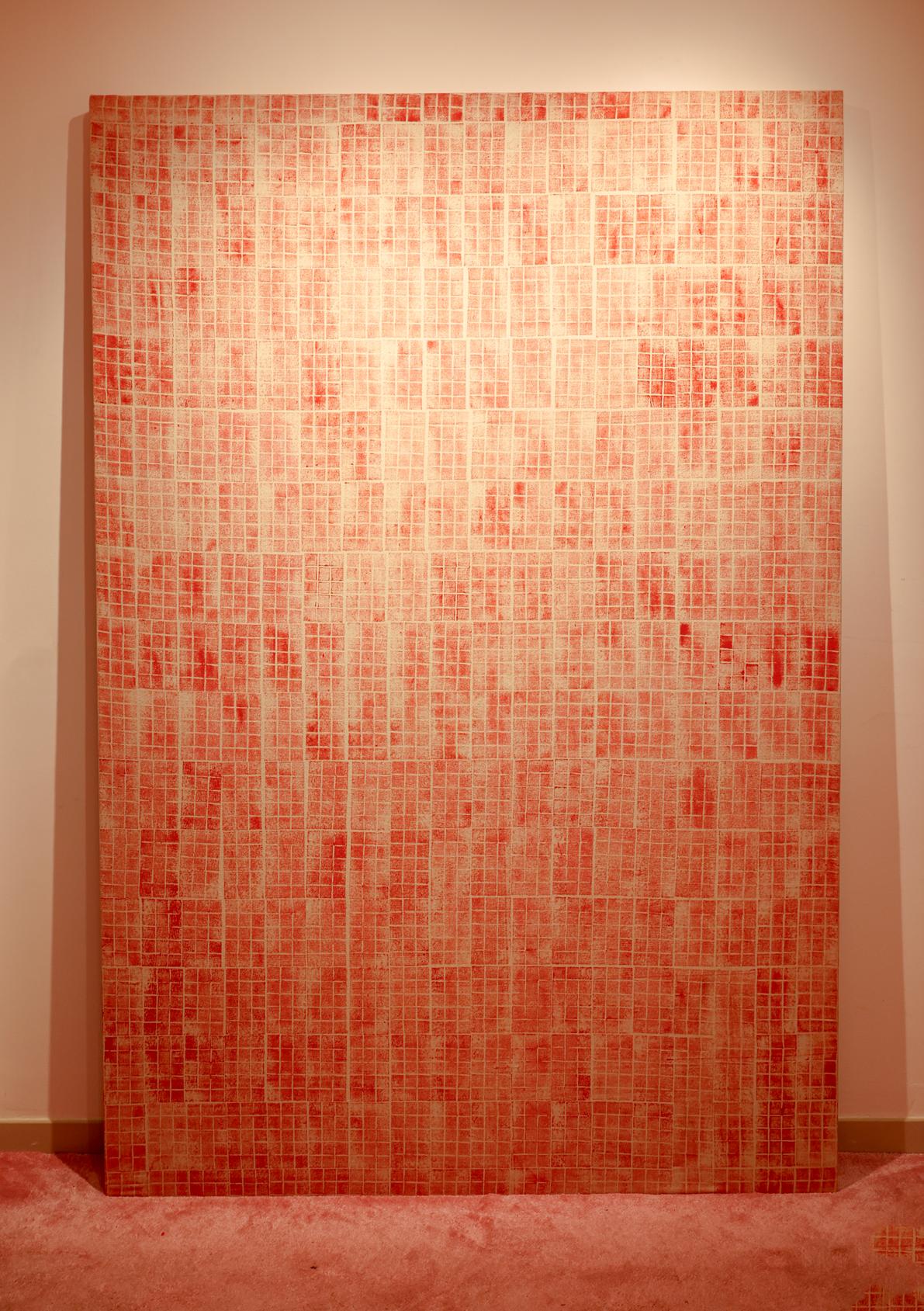
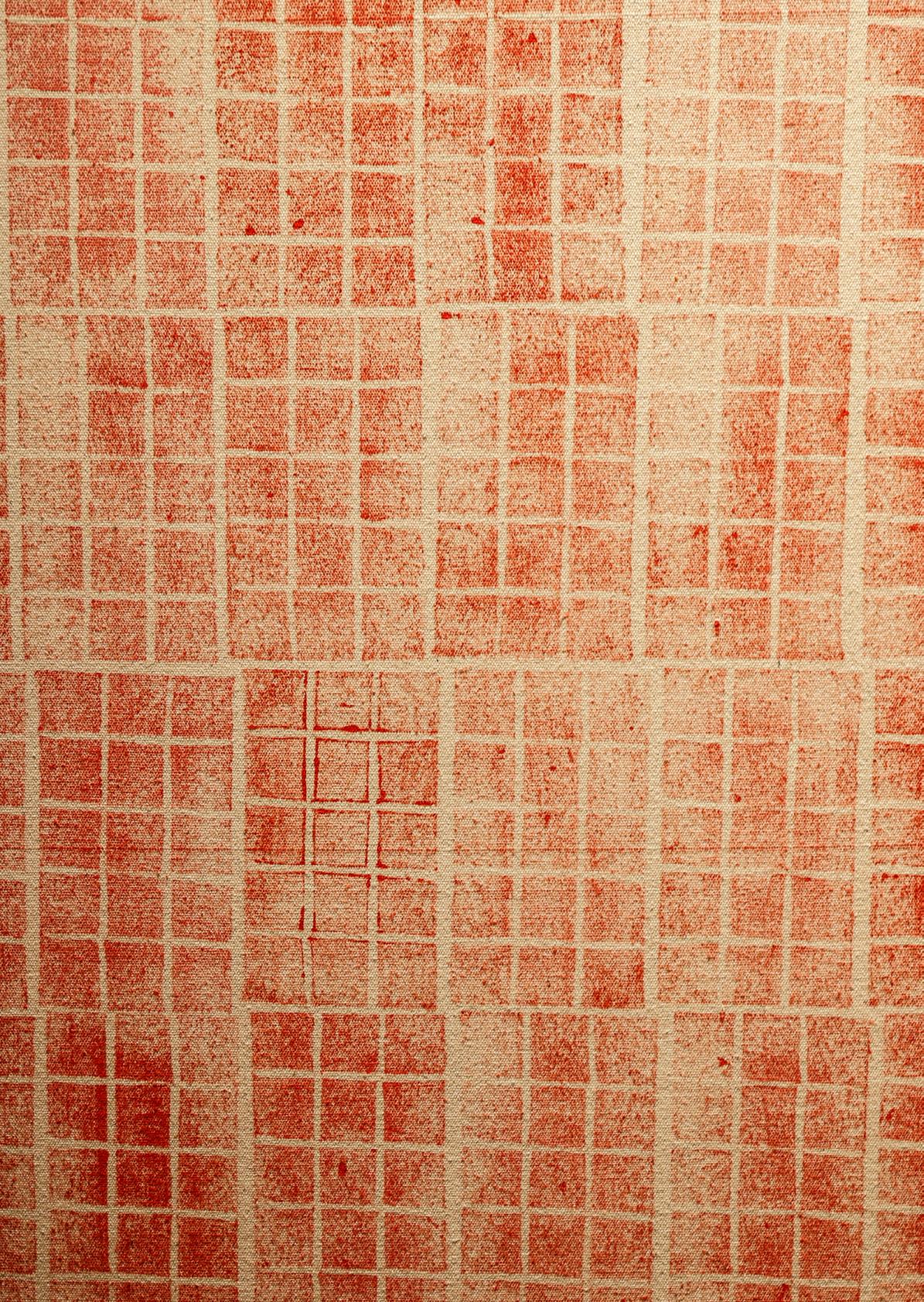

Abdelrahman Elshahed
Between the Lines (2017)
Ink on handmade Muqahar paper
65 x 50 cm
“The artworks come in the form of the ancient Arabic letters (messages) that begin with “Basmalah” and conclude with “Peace”. Art project name “Between the Lines” is inspired by the metaphor in the Arab heritage, which includes touching the hidden connotations between the written lines or the sentences of speech, especially those connotations that prefer the hint and does not give the real feelings when trying to express them. It came after many Arab writings in letters of love and poems spread around the world, such as the writings of Antar Abla, the poems of Qais Majnun Layla, and Jamil Buthaina … etc.
One of the most interesting things in this contemporary artwork is the way to express “Love” with one word only but it shows in a different way, characterized by a profound visual abundance, and abbreviates many meanings. The strange thing about the matter is that the meanings are not written, but they appear within everyone who reads the artwork after they was found strongly between the lines.”
Text Supplied by artist.
On loan from the private collection of HRH Prince Saud bin Bader
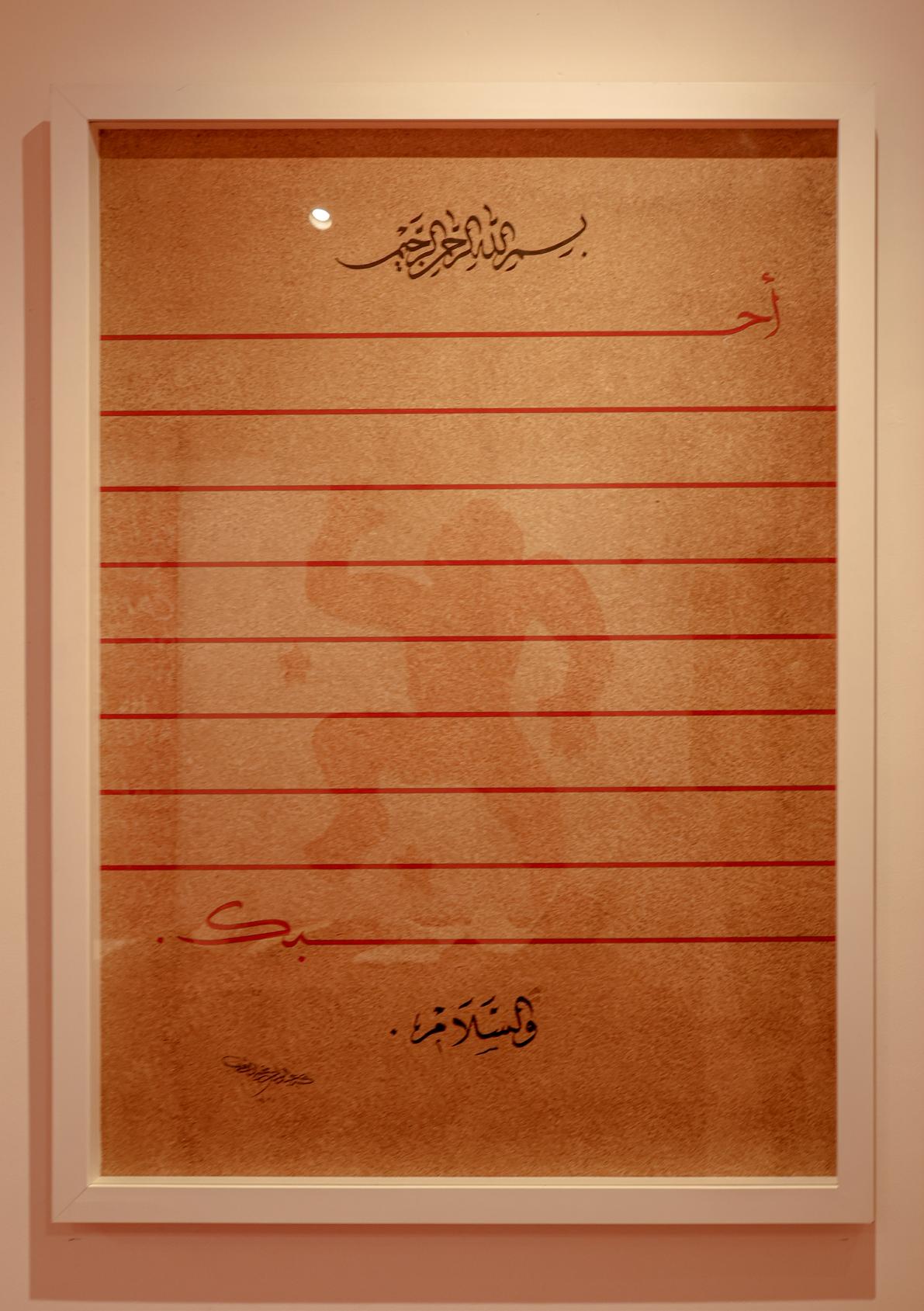

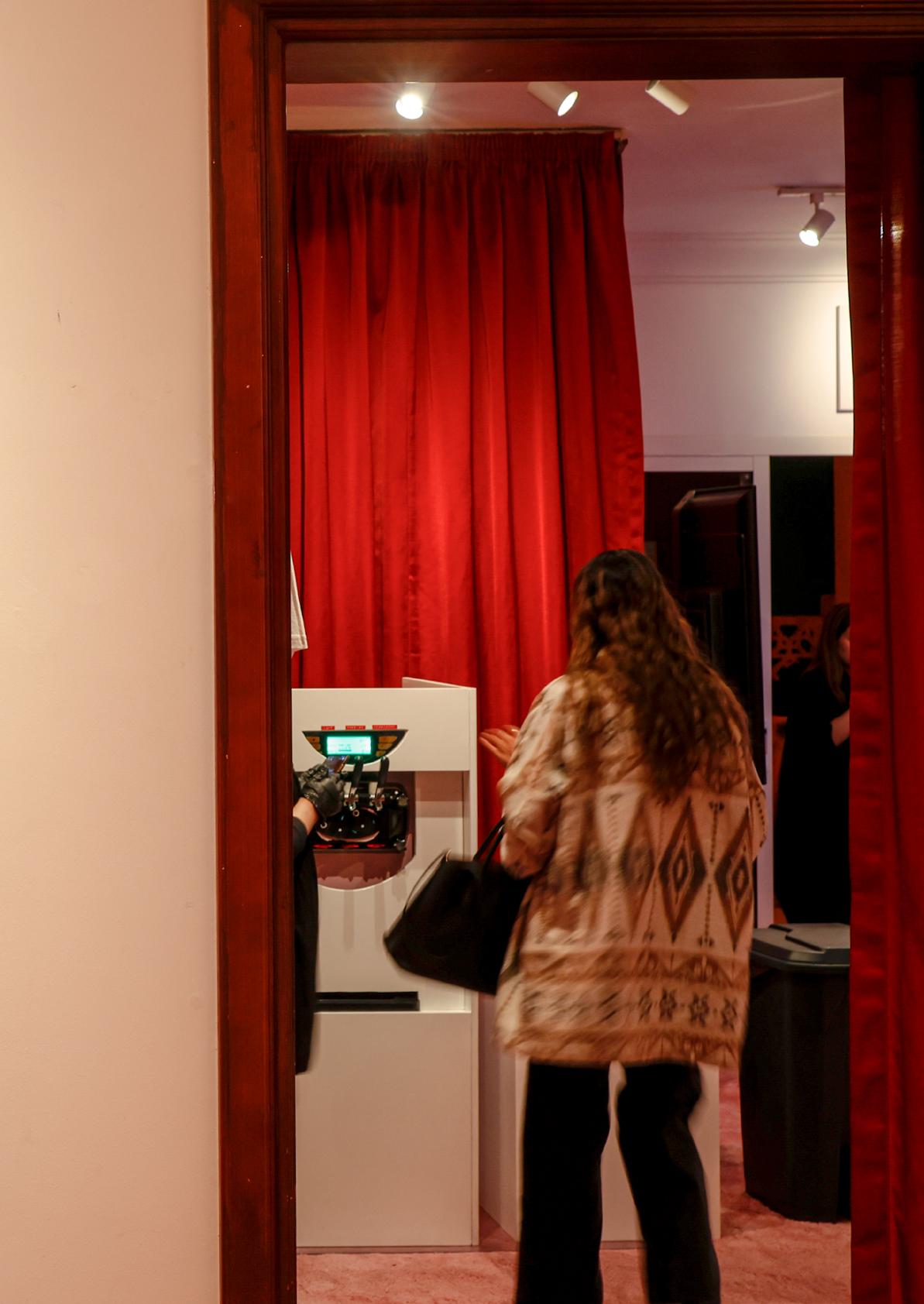
Zahra Bundakji
The Closest We’ll Ever Be (2022) Clay (Stoneware)
Various Dimensions
“The simplicity of the forms and muted tones of Bundakji’s ceramic pieces entice the viewer into wanting to learn more by inviting them into the mysterious and intimate. Bundakji uses her stoneware and porcelain clay as the medium by which she chooses to measure distance, or, arguably closeness, between two people- both physically and emotionally. Be it a handshake, a hug or a kiss, Bundakji uses the impulsive nature of the human form to mold the clay inadvertently between the two bodies where the sculpture itself becomes a hardened by-product of a captured moment that once was. Bundakji’s practice serves to capture the elusive and the ephemeral and prolong our experience of it in a physical form.”
Text an excerpt of A Little Startdust Caught Catalog, group show Curated by Jumana Ghouth.
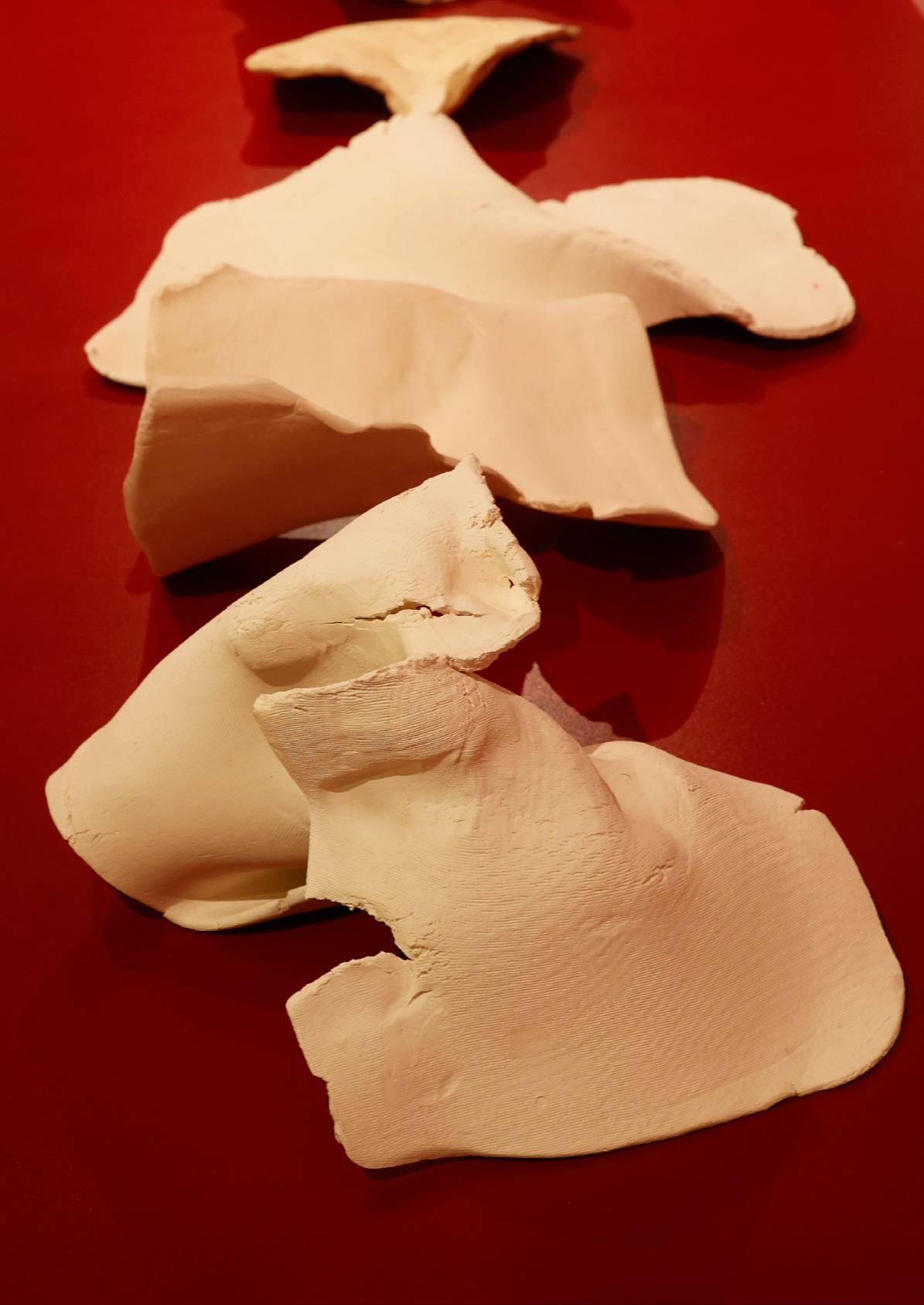
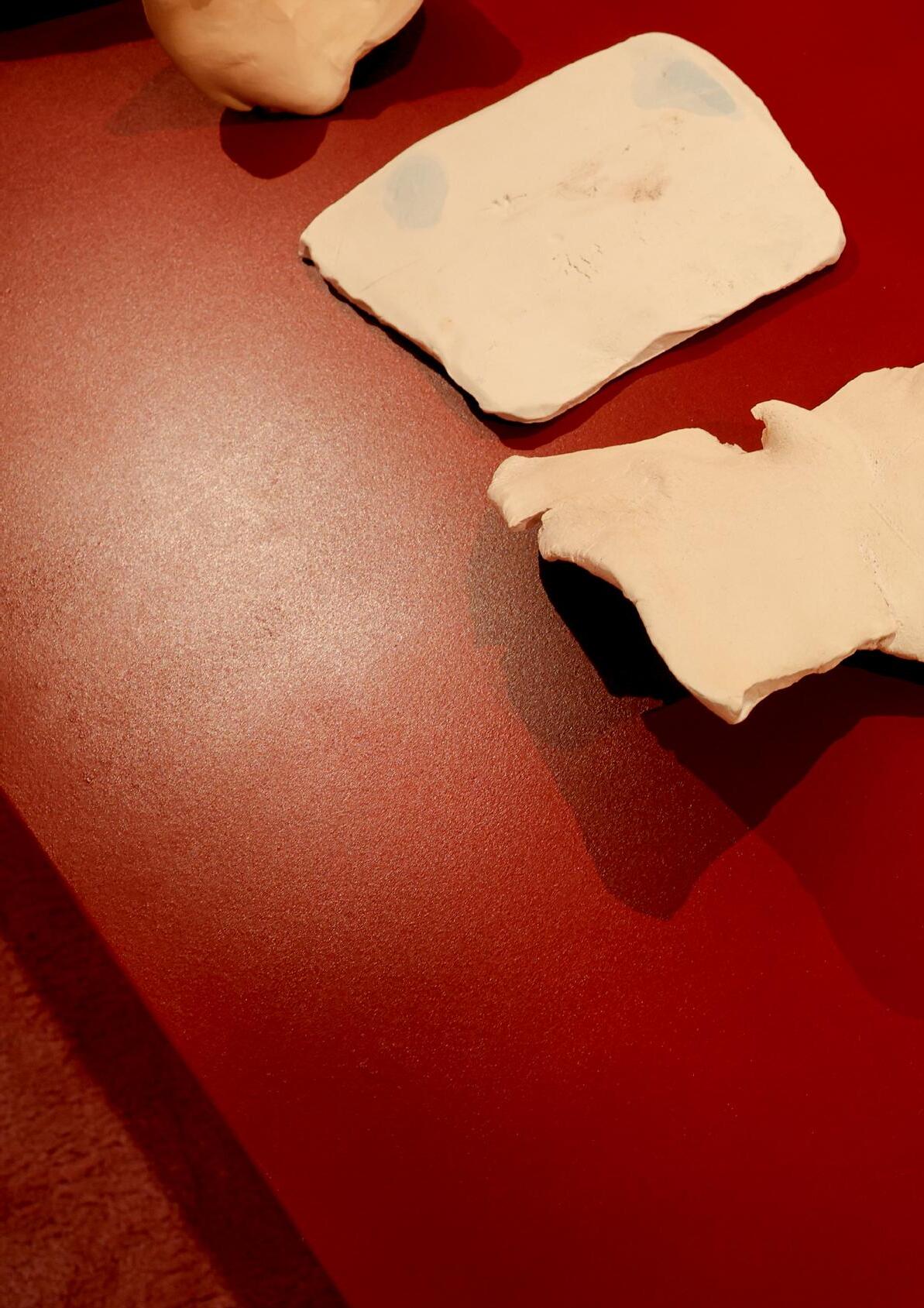
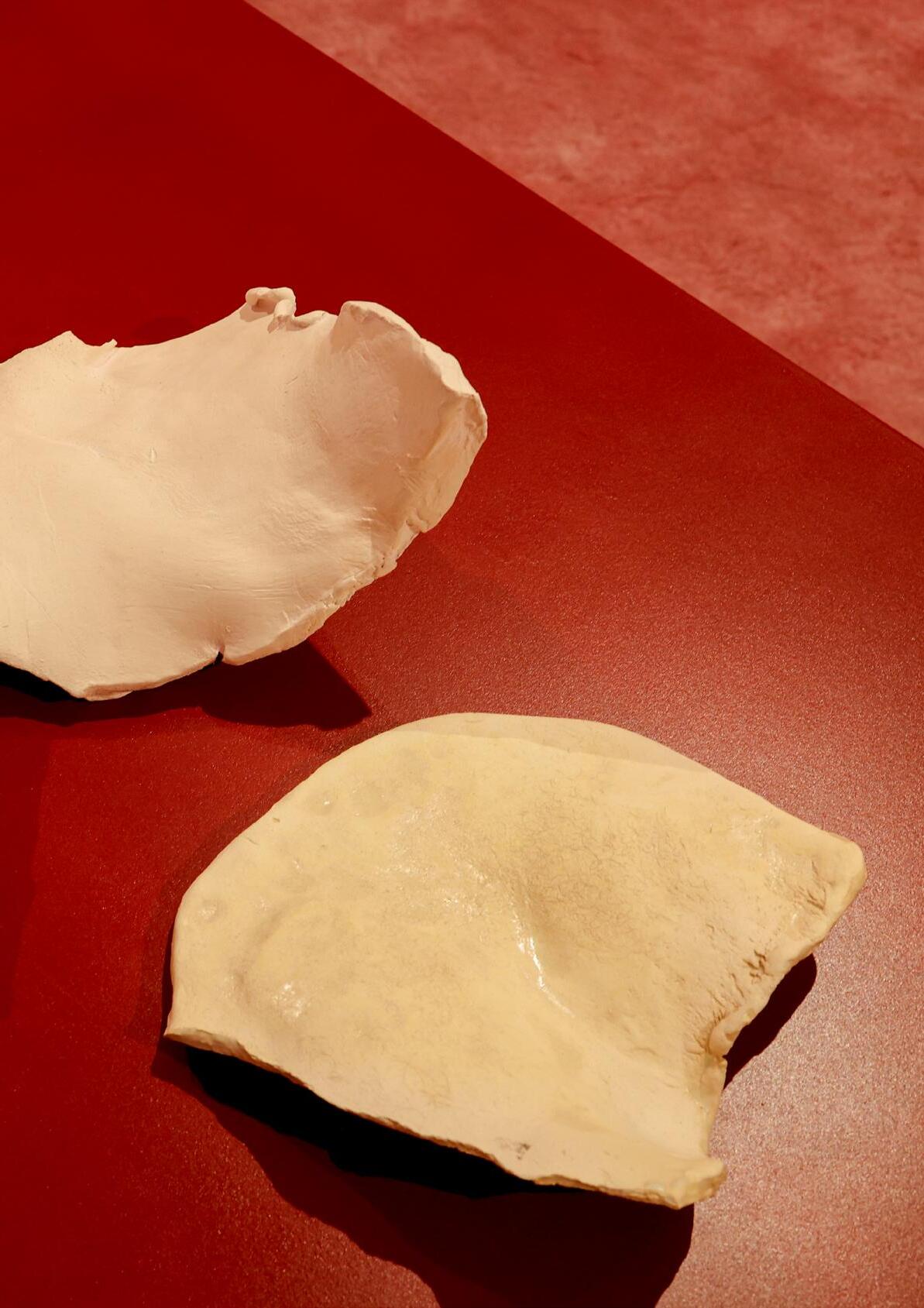
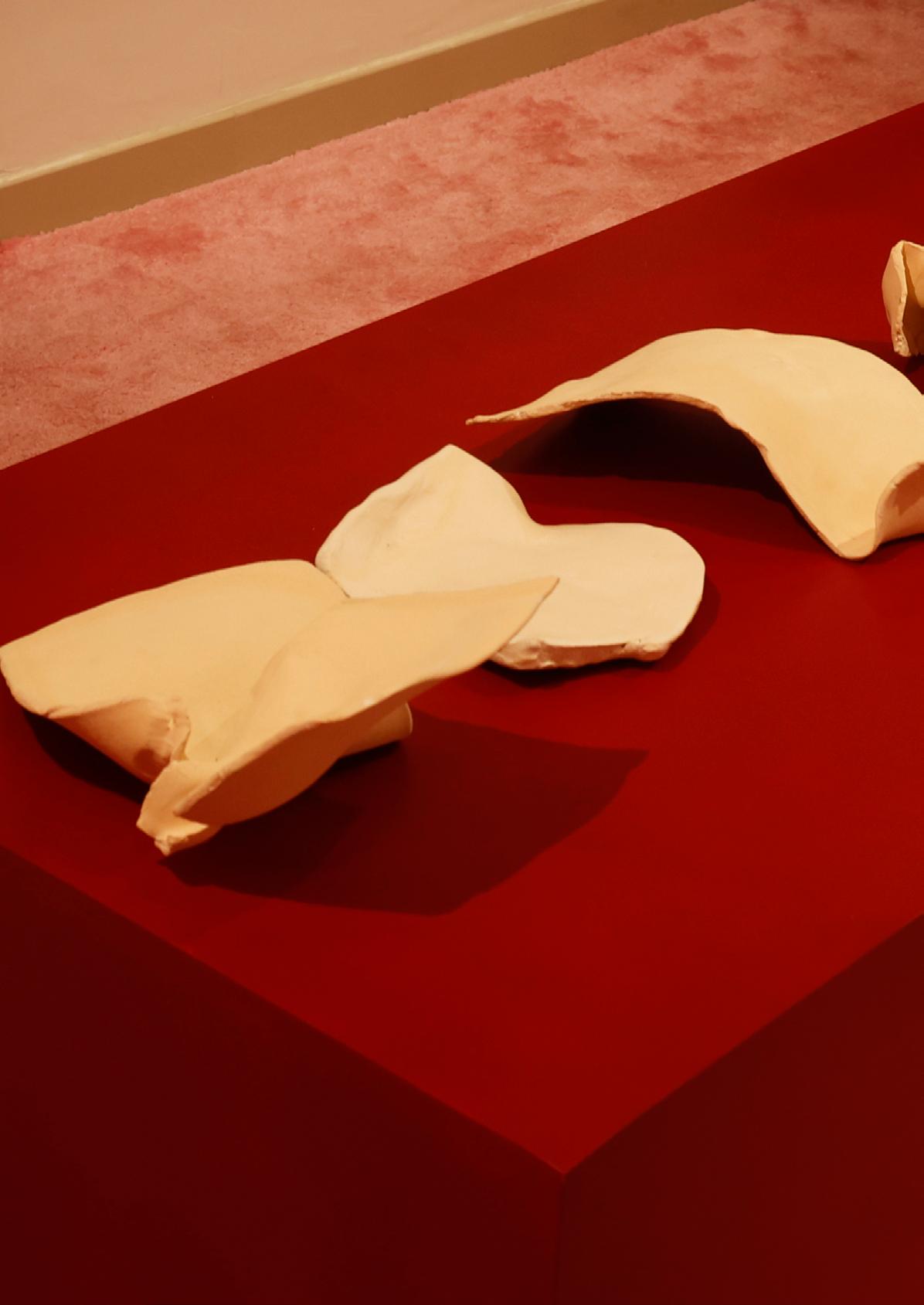
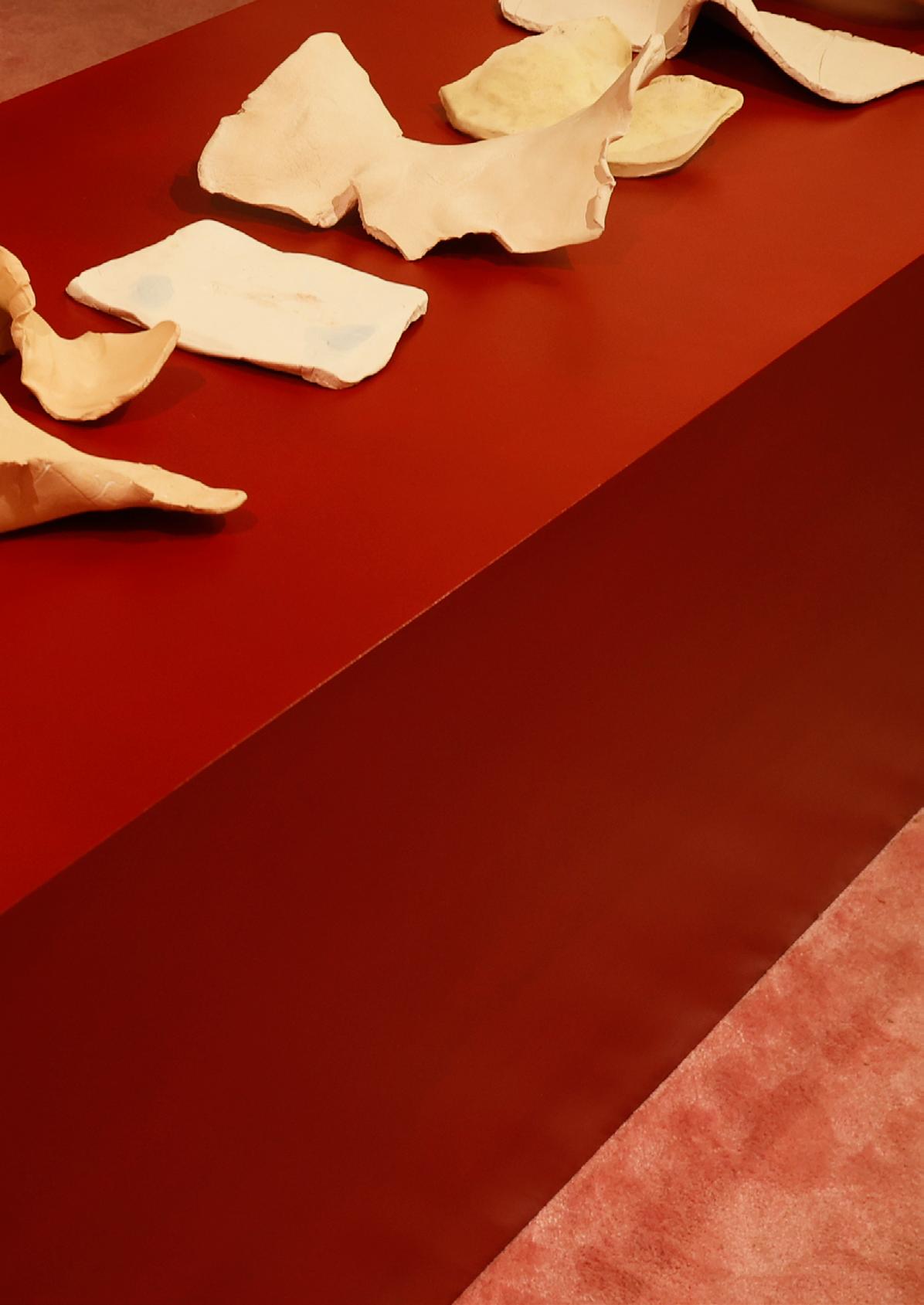
Meshaal Alzeer
تاي�امور - Gulf Romances (2023)
Acrylic paint on MDF
350 x 240 cm
In the diptych Alzeer has chosen to explore the absurdity of Khaleeji (Gulf genre) songs, that usually have an upbeat tune, but accompanied by extremely sad lyrics. These songs are played at celebratory events such as weddings, and with the silhouette of the dancing figure frozen in mid dance, as a way to ask the viewer to halt/stop at the realization. The lyrics are an unedited Google translation of popular Khaleeji song “Jani Alasmar” by legendary Saudi Female singer Etab. The artist chose to not alter the lyrics in order to further alienate the viewer from the songs and to question this unquestioned tradition of these wedding sets.
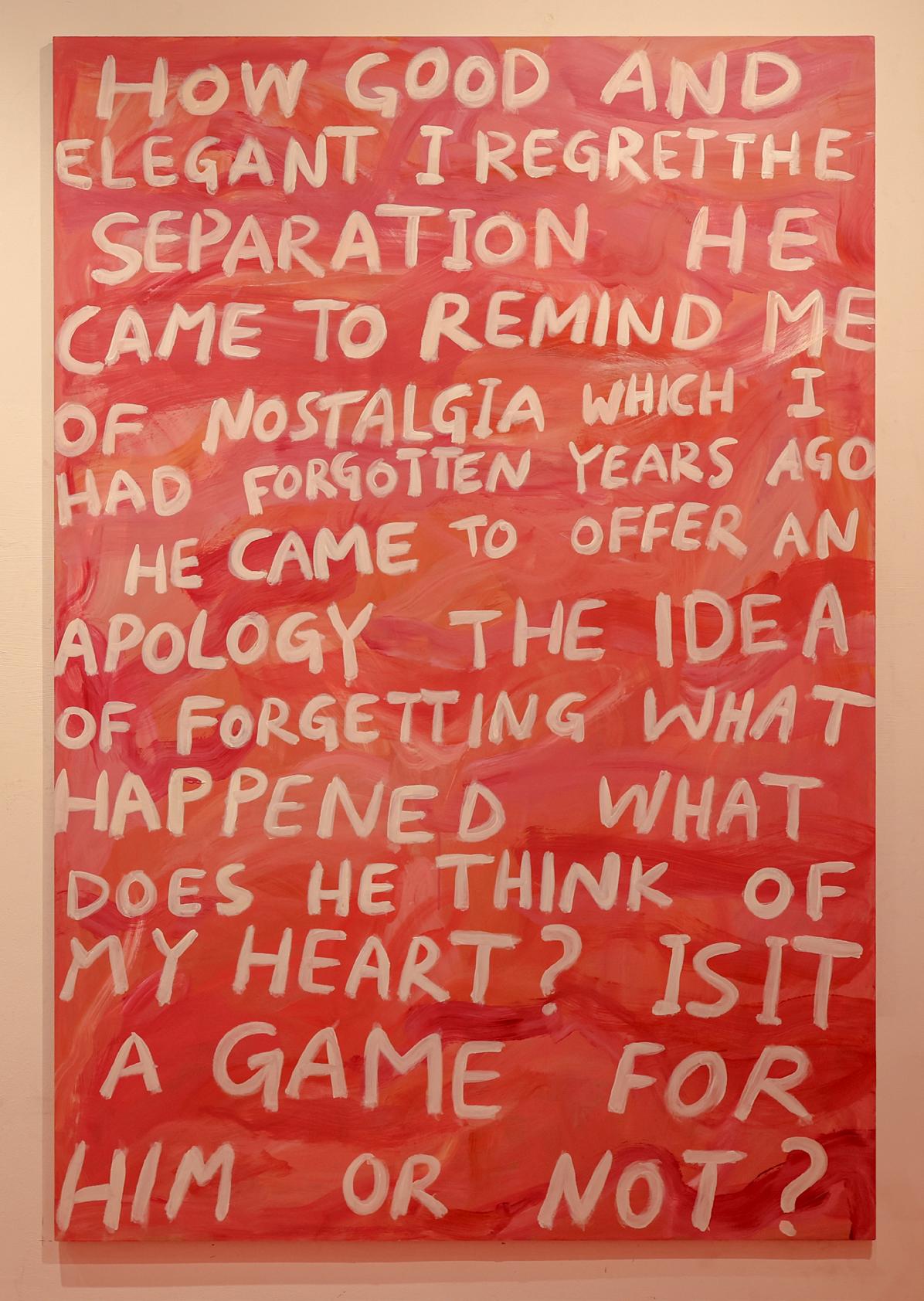

 Aidha Badr
Aidha Badr
We Are Where We Are Not (2022)
Silk Satin, cotton, Lamé
370 x 200 cm
“Immensity is the philosophical category of daydream. Since immensity moves the dreamer into the world of infinity, quiet daydreaming therefore opens immensity within our inner wold, which expands our motionlessness. Therefore, the root of immensity is within our capability of thinking vast thoughts which is rooted in our own souls, not in the universe. In the case of my grandfather’s house, which my body of work is based off of, there was so much intensity in my surroundings which enabled me to enlarge my own images of immensity.
A bright pink and red bathroom with heart decorations on every other tile, an entire wall with stuffed animals hanging by strings, transparent Mickey Mouse stickers on the window that alter the color of the sunlight as it shines through, a dining room with large wedding portraits arranged carefully along the walls of current generation and the generations past, a large glass cupboard full of porcelain dolls and various wooden toys that one could only look at, and an entire fancy living room that nobody was allowed to sit in because it was reserved for guests to demonstrate to them that we were ‘occidentalized’. My grandfather has never left this house, for him to enlarge his own images of immensity, demanded that he stay in the same city, in the same neighborhood, in the same house, looking at the same view.
Outside and inside are concepts of “being” and “non-being”. By using the terms “outside” and “inside”, one creates a concrete form of geometric reasoning that distorts perspective. But if the object is either inside or outside, and never both, it becomes complicated for one to have a concrete grasp on their memories. Previously I talked about the game I played where I pretended to be somewhere else, with someone else, this game was so vivid to the point that it distorted my own memory of childhood. In the Arabic language there’s a term لا�, Yoqal, it is used to distinguish hearsay from first-hand experience. So if I say with absolute certainty, that I was somewhere, with someone, at some point, and I have a much more vivid memory of that imagined time than I do of dreaming of being somewhere else, with someone else, childhood can be very lonely.”
Text Supplied by artist.
On loan from Hunna Art gallery
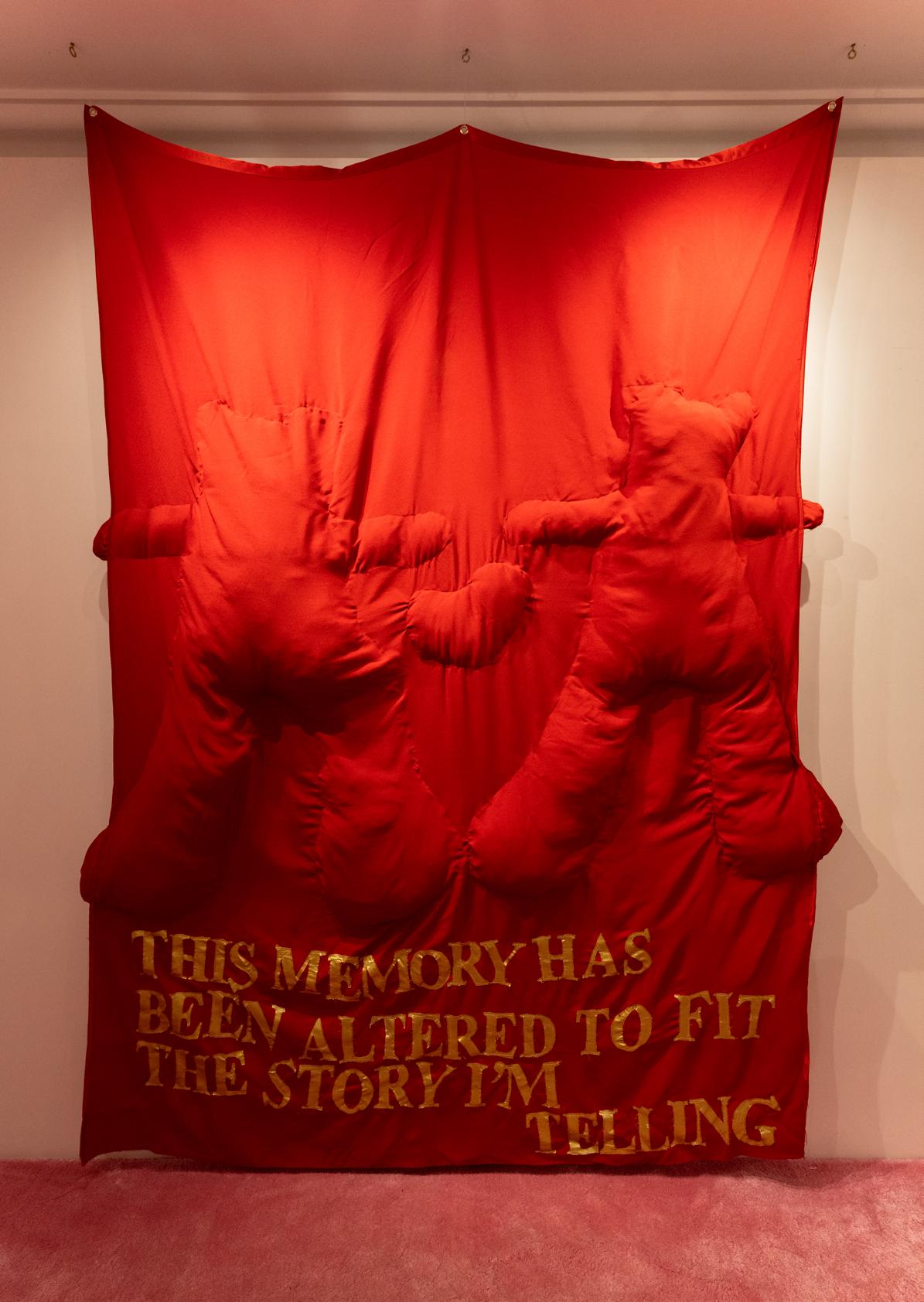
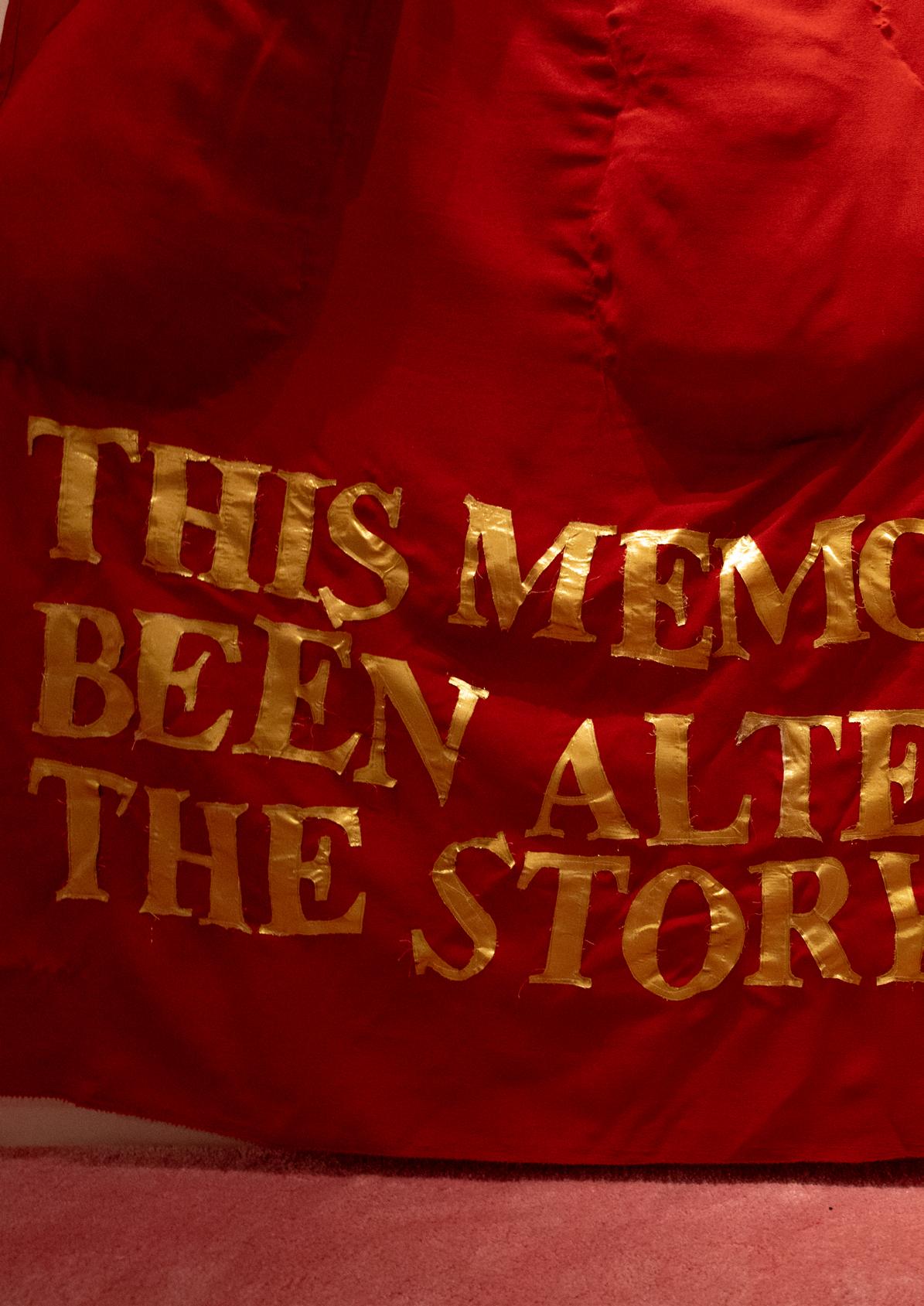
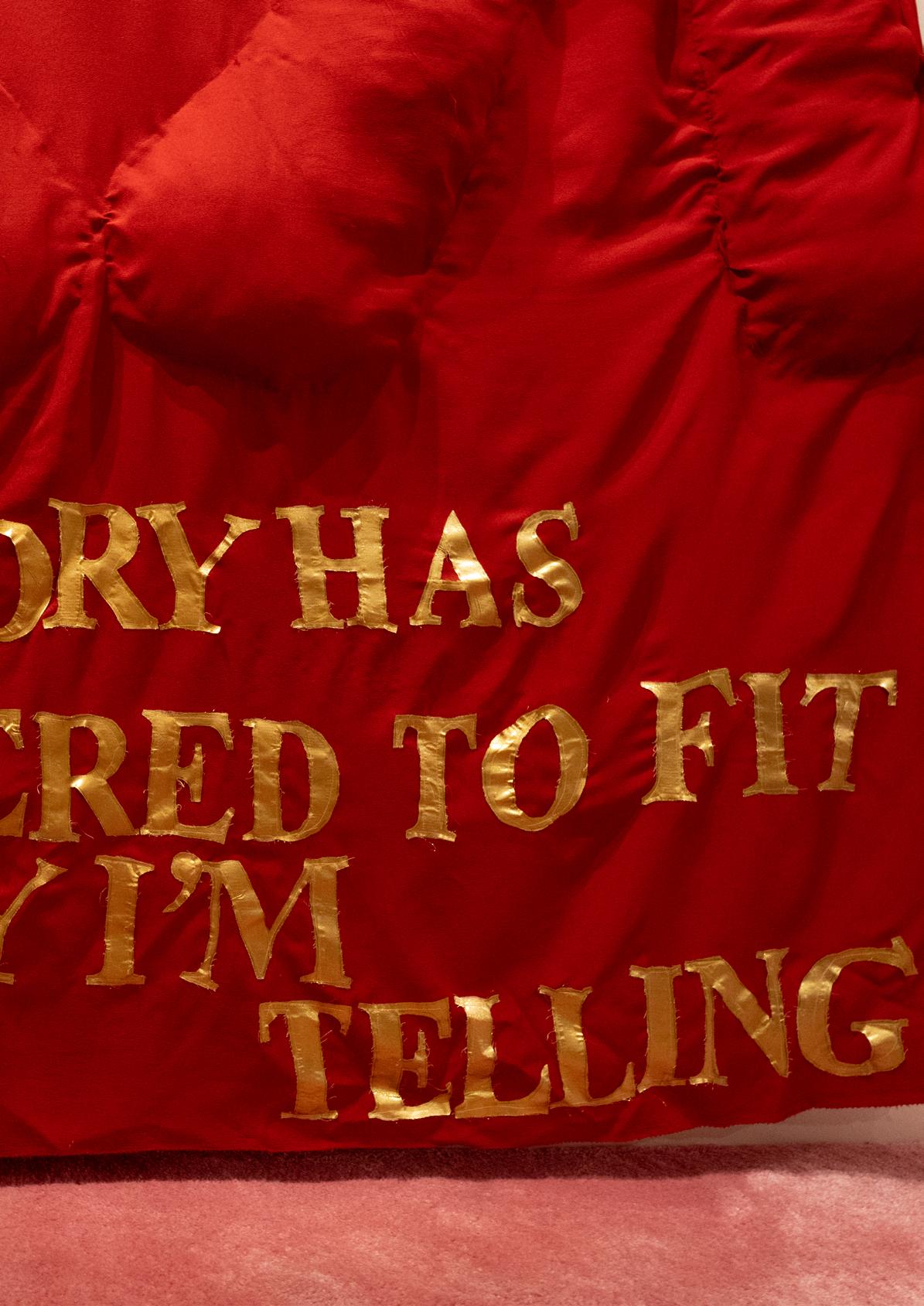
Madhawi AlGwaiz
12:01 (2023)
Acrylic paint on stretched canvas
122 x 76 cm
In a scene which is an aftermath of a party; sadness, loneliness and emptiness are depicted in Madhawi’s still life painting, which is purposefully devoid of any people. Capturing melancholy and the sadness after the passing of a fleeting moment that was highly anticipated is at the core of her exploration in 12:01. There is a heavy reliance on symbolism and on how meaning and importance are projected on inanimate objects. The viewer is faced with the harsh realization ad feeling of ‘going back to reality’ right after a celebratory moment.
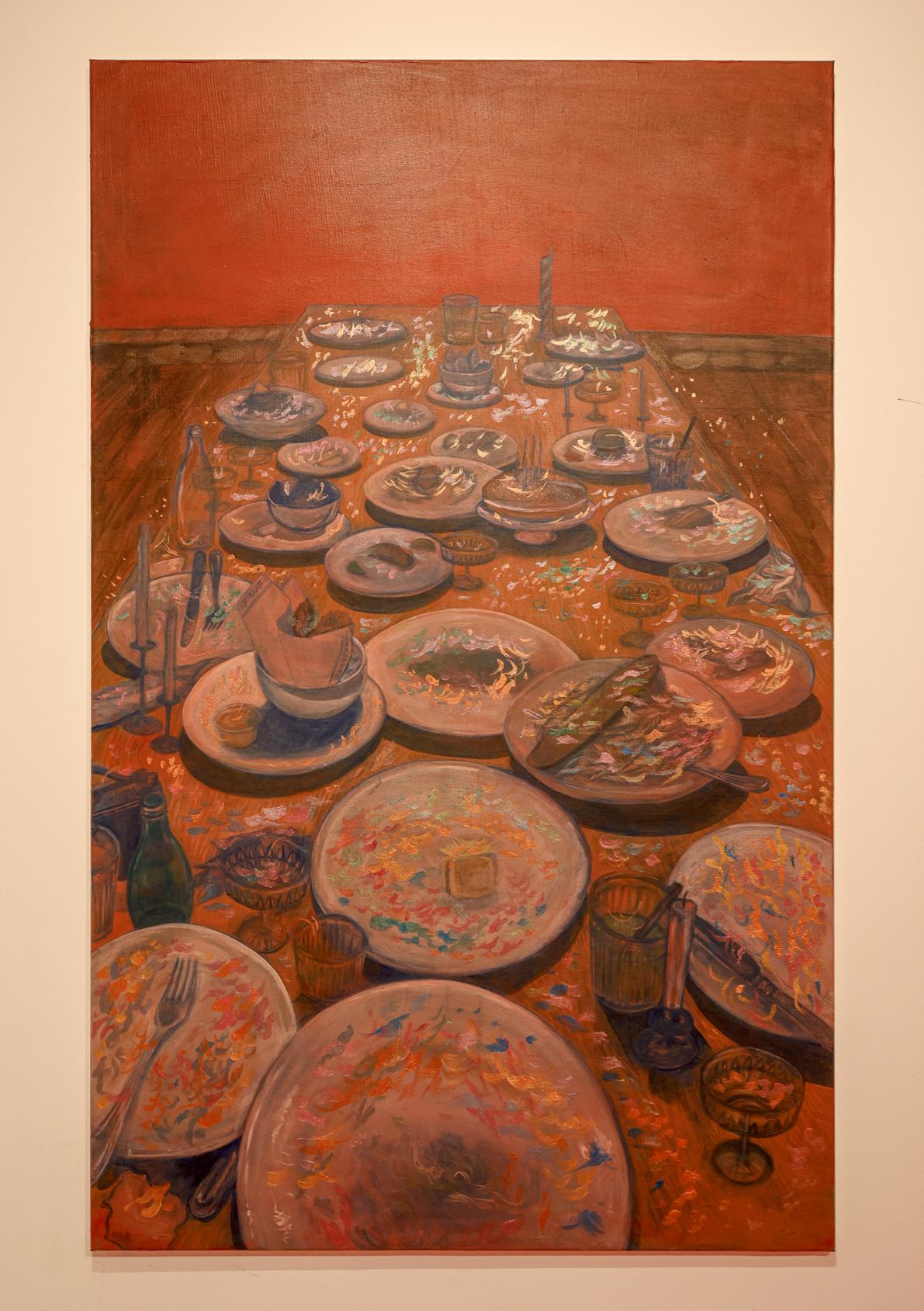
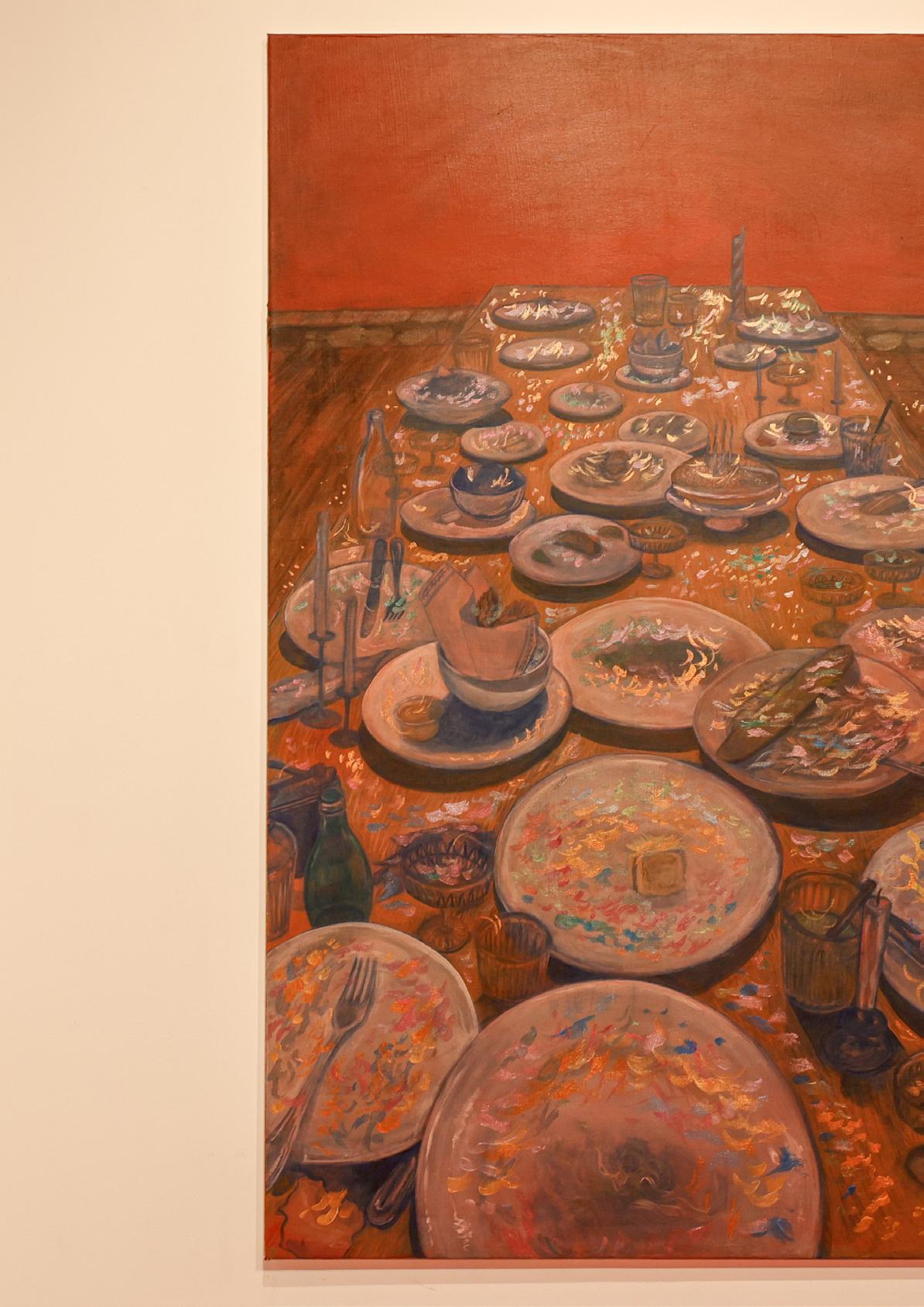

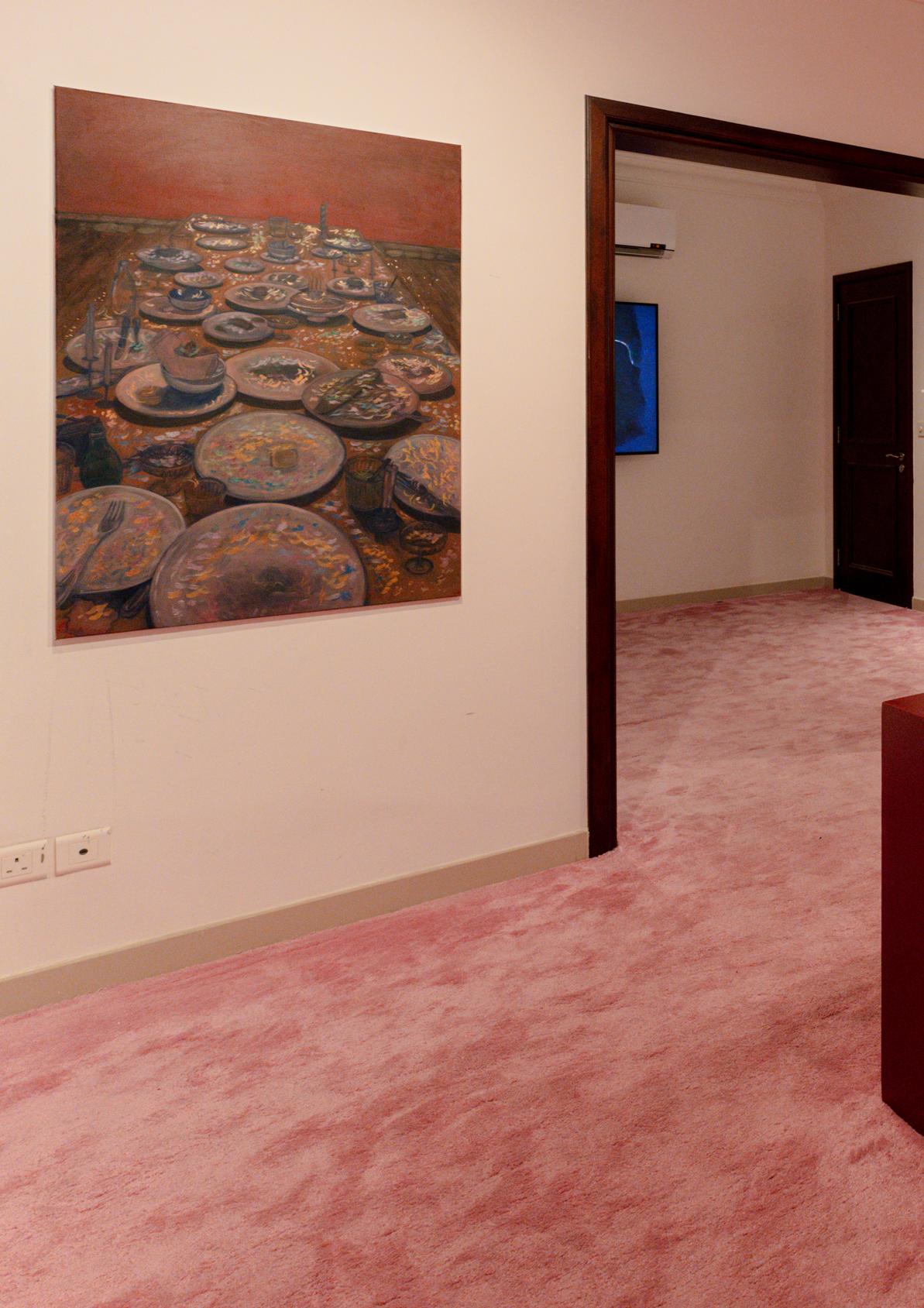

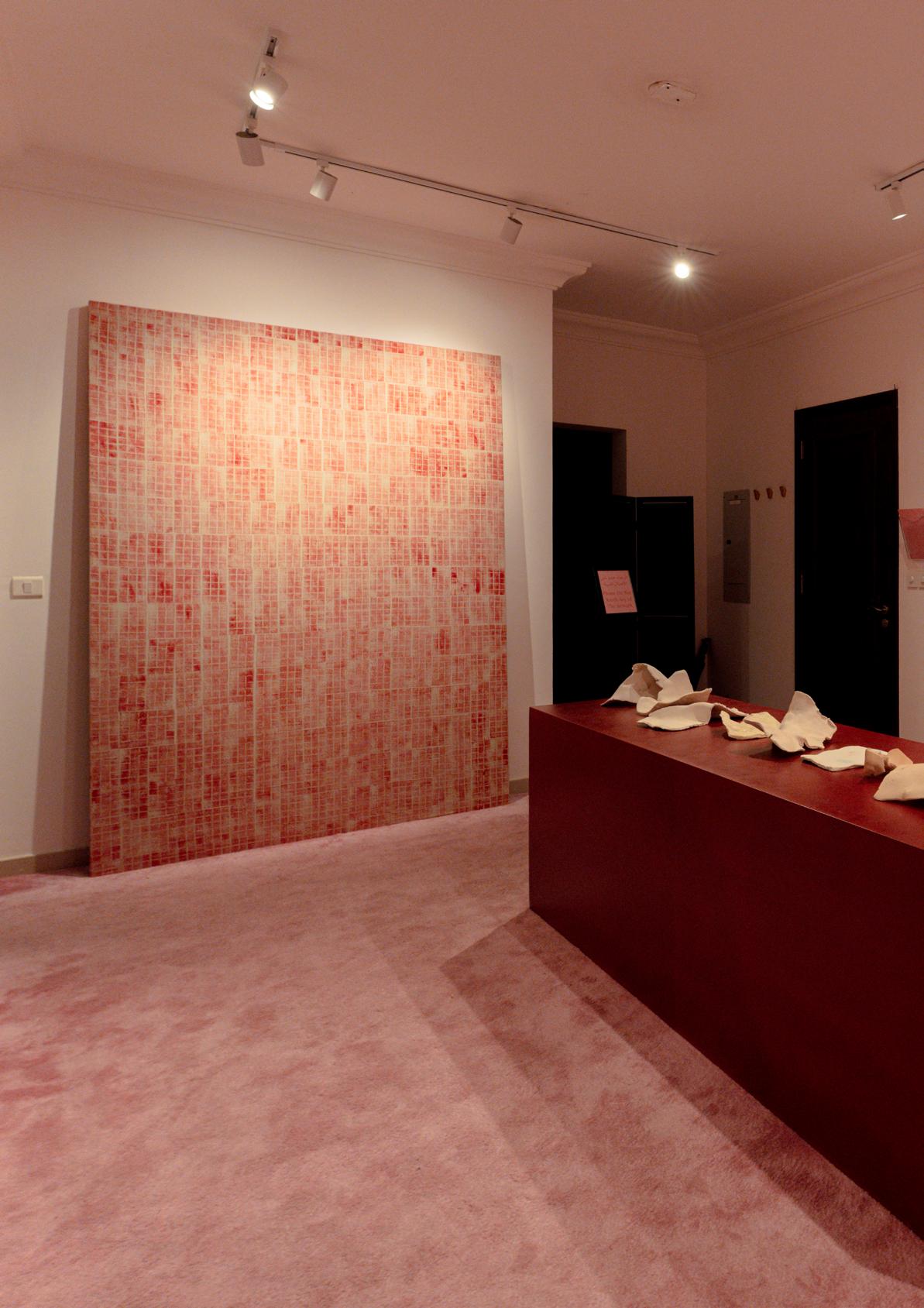
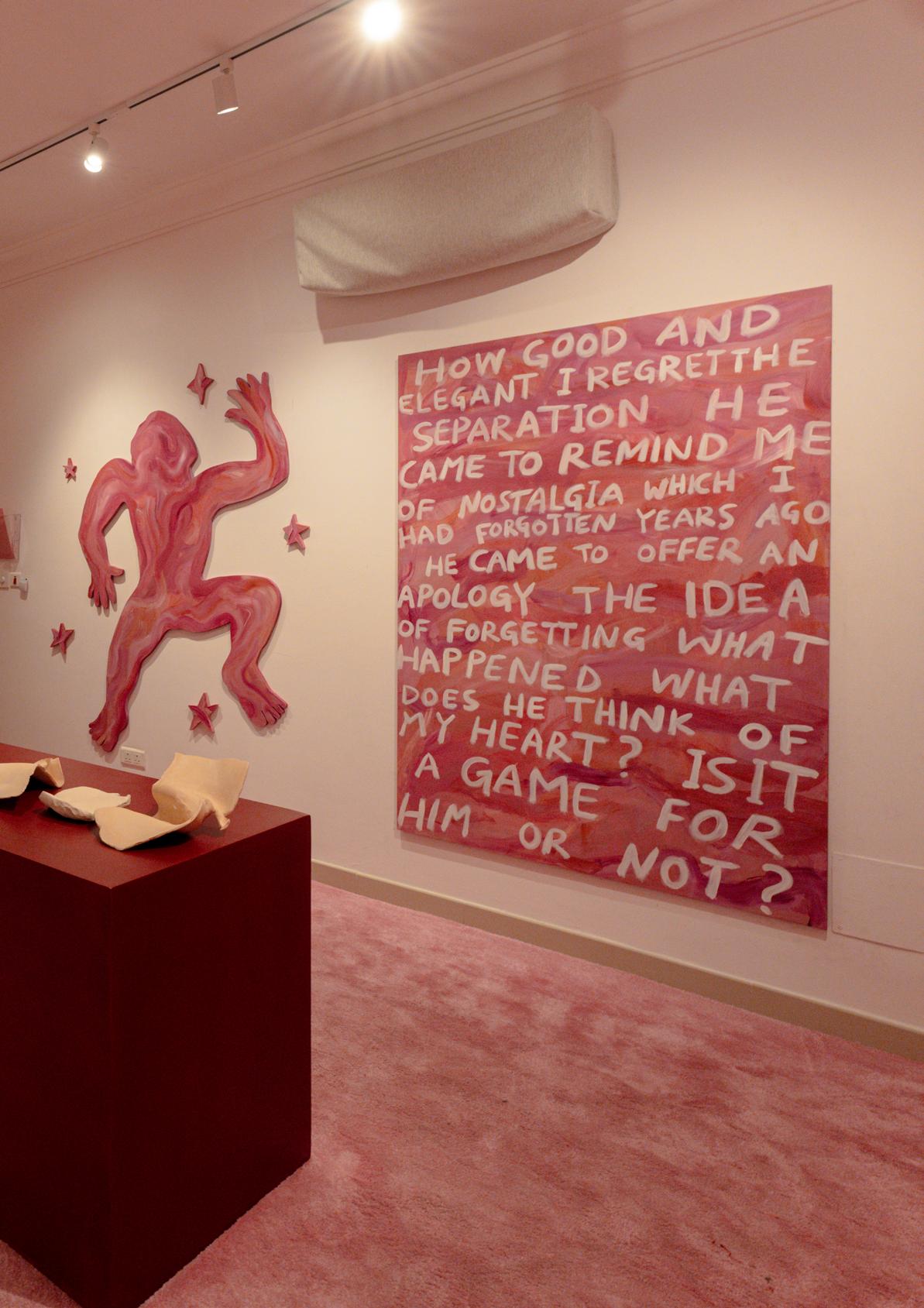

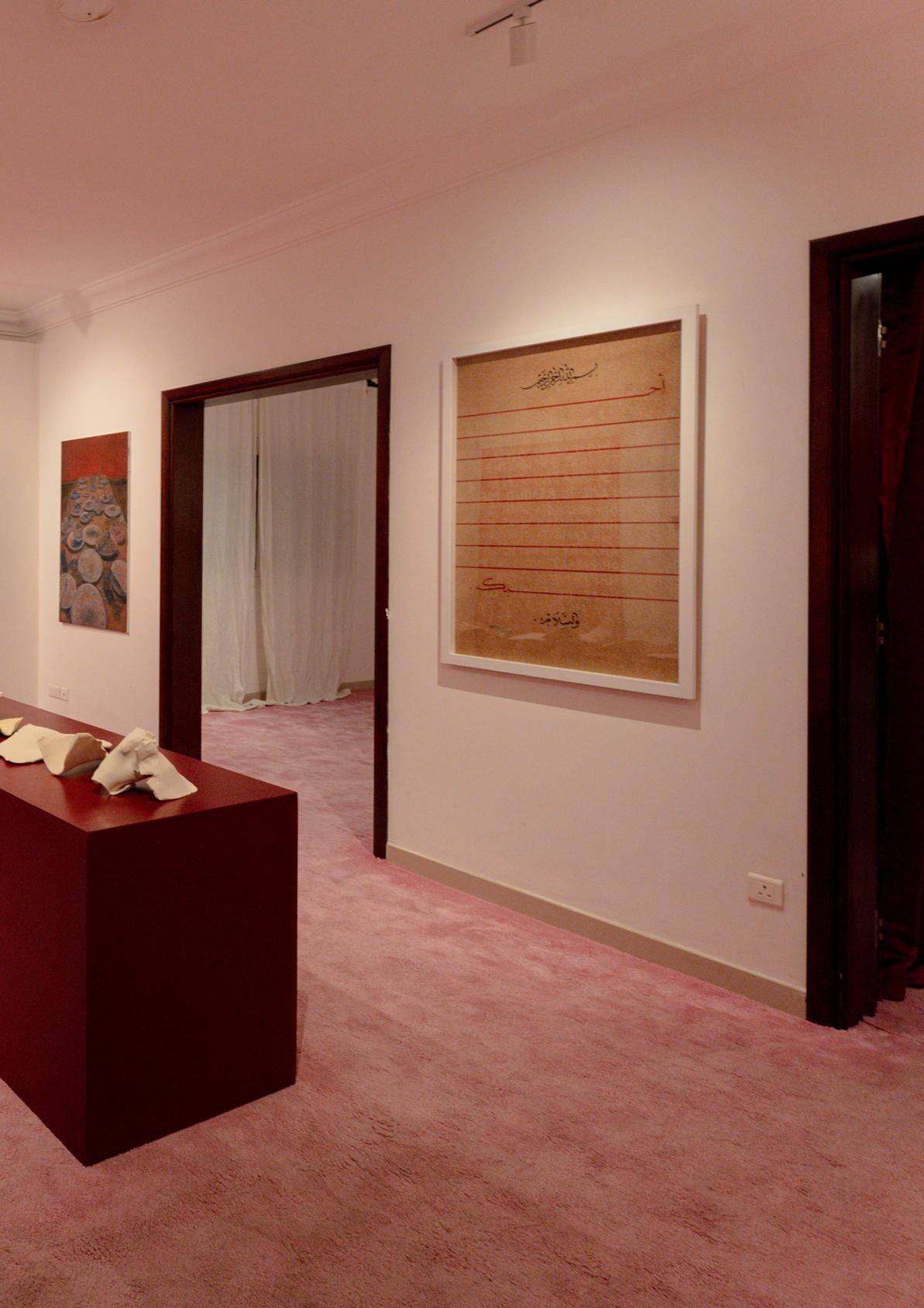

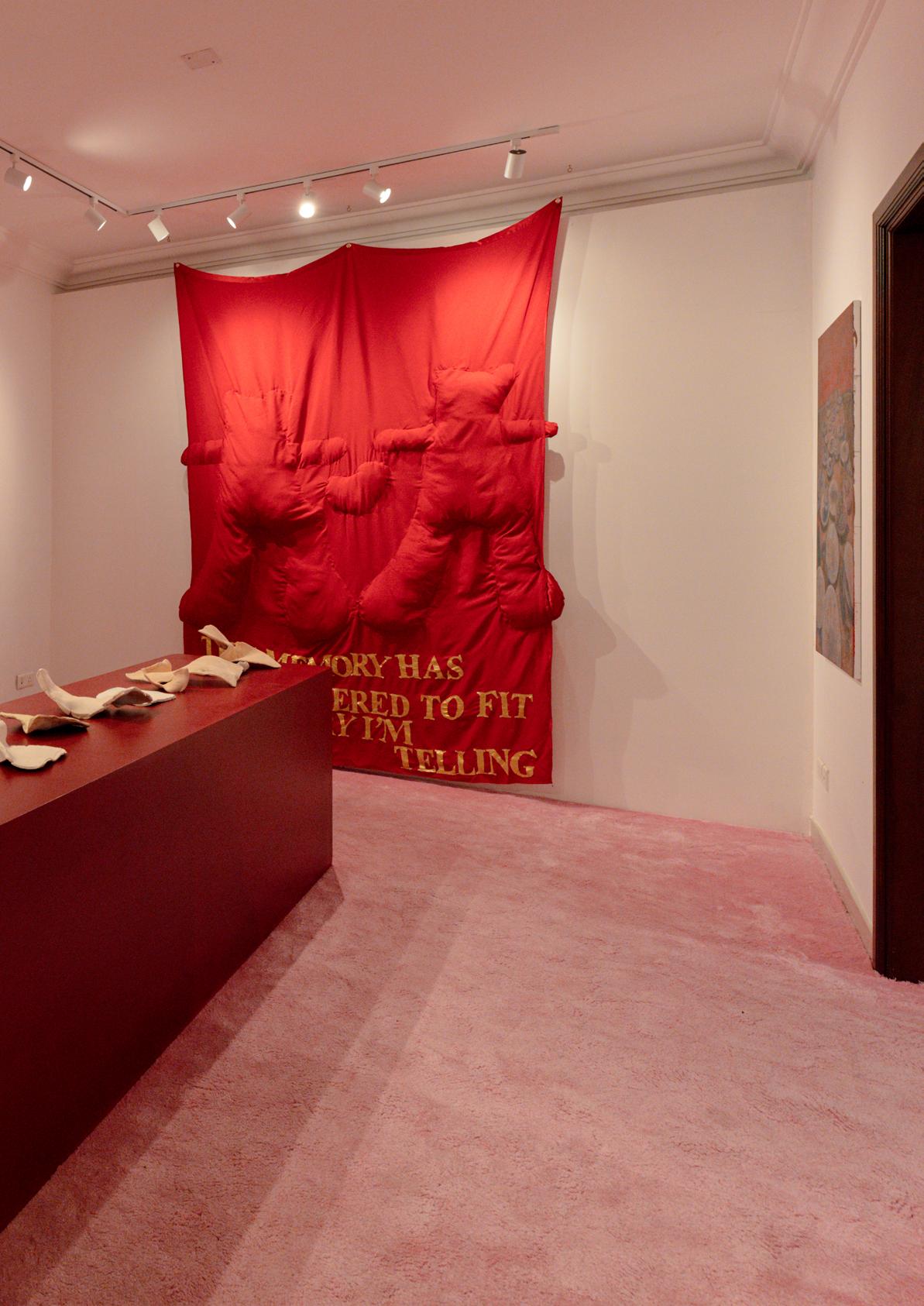
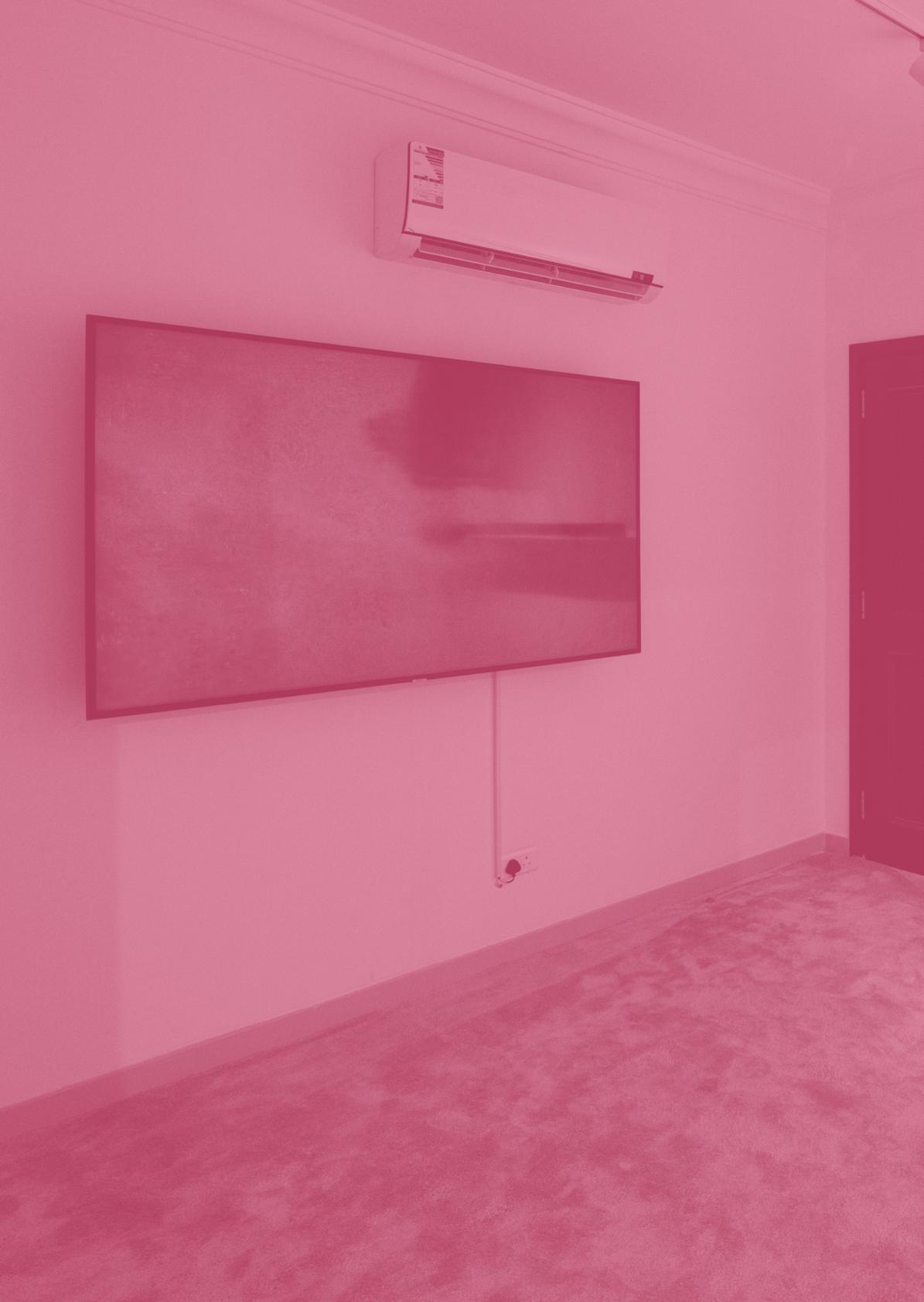
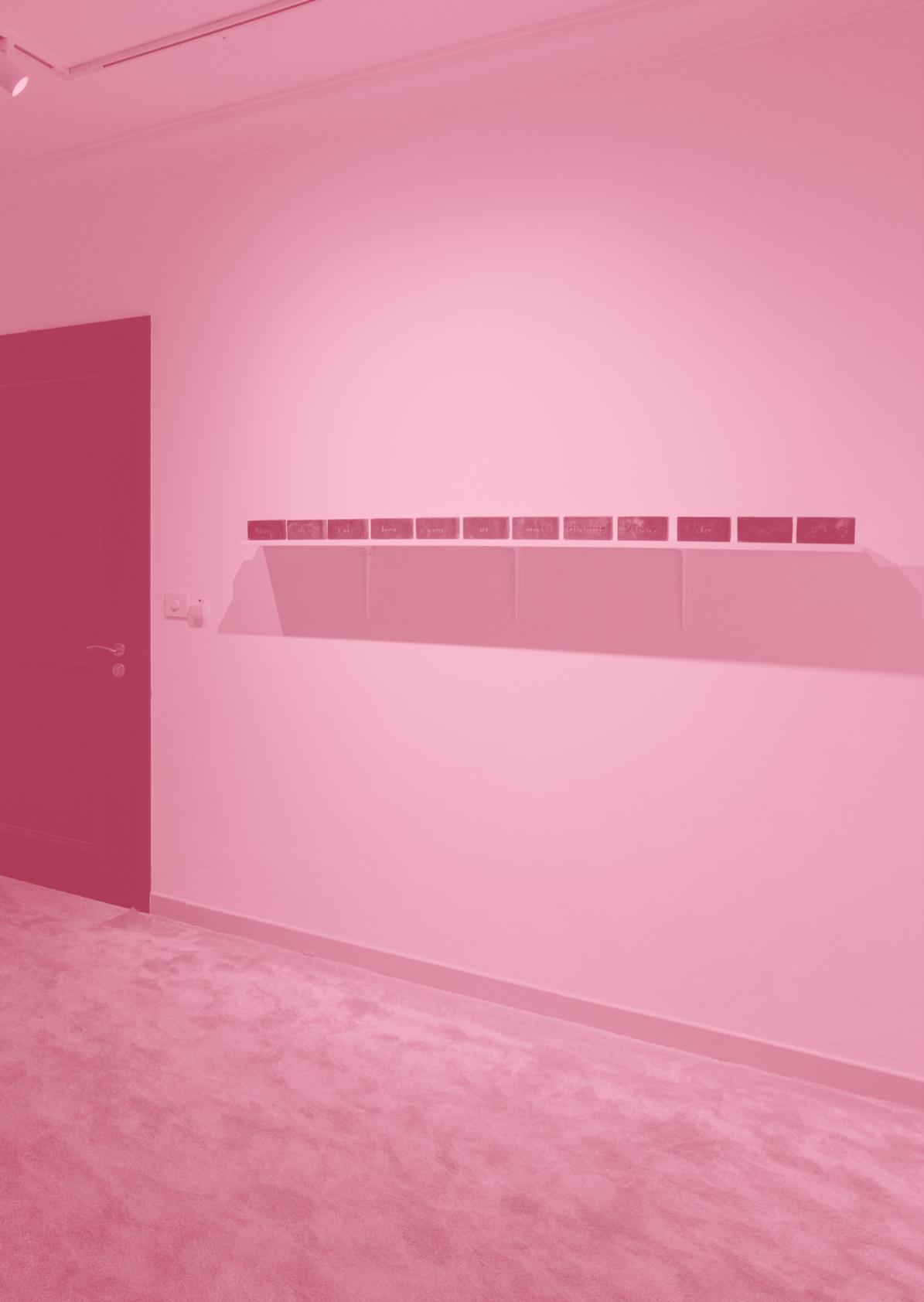
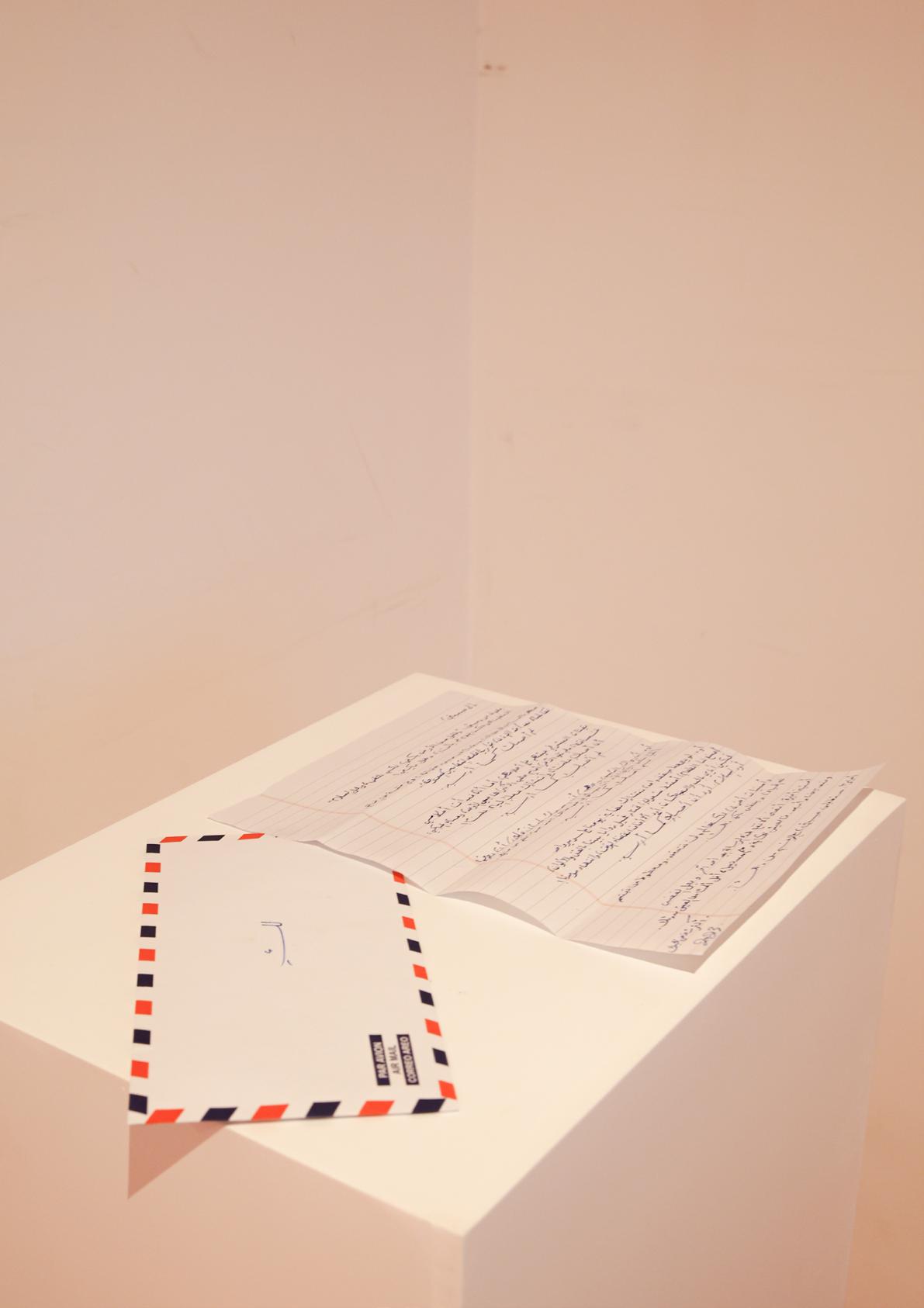
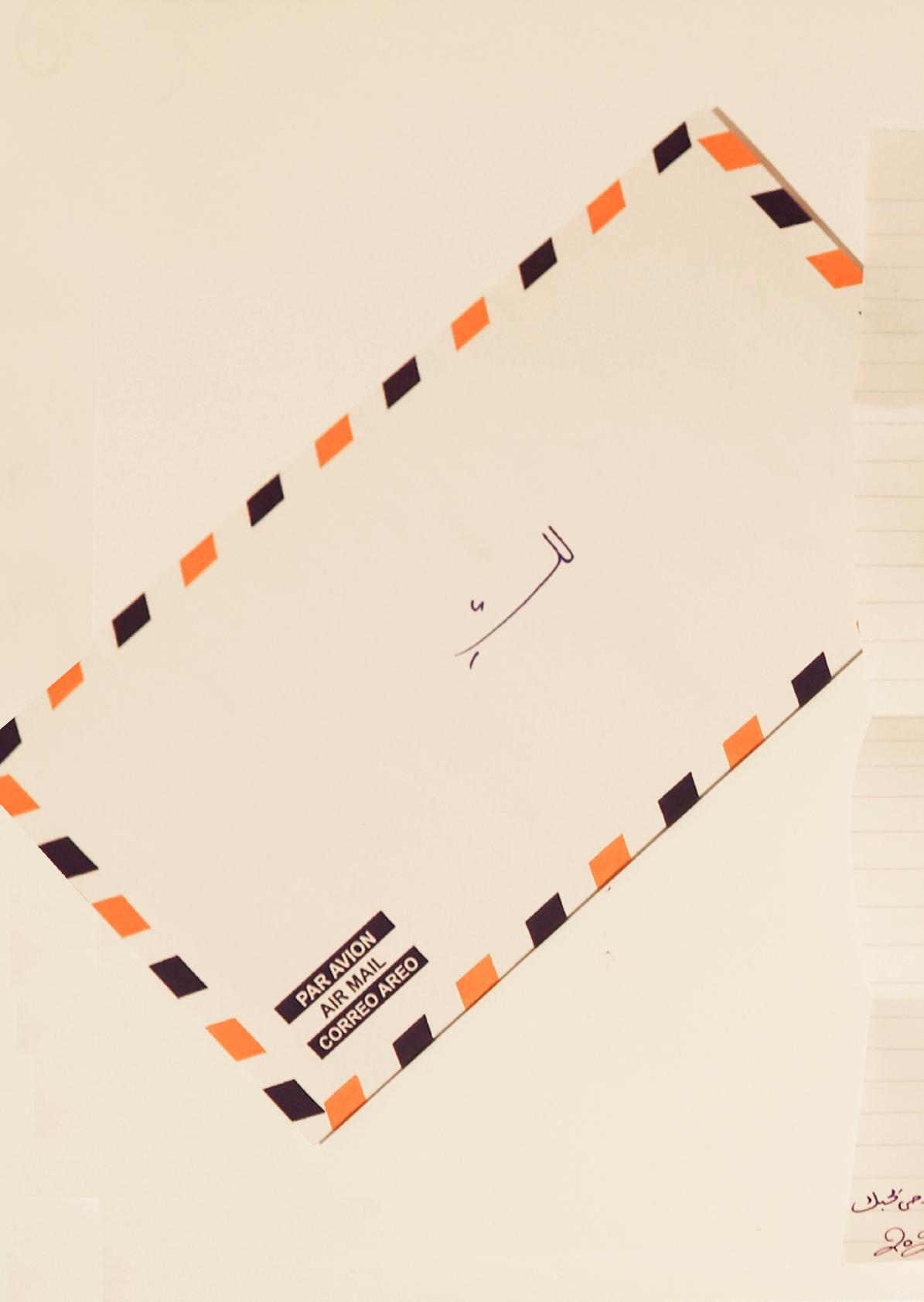
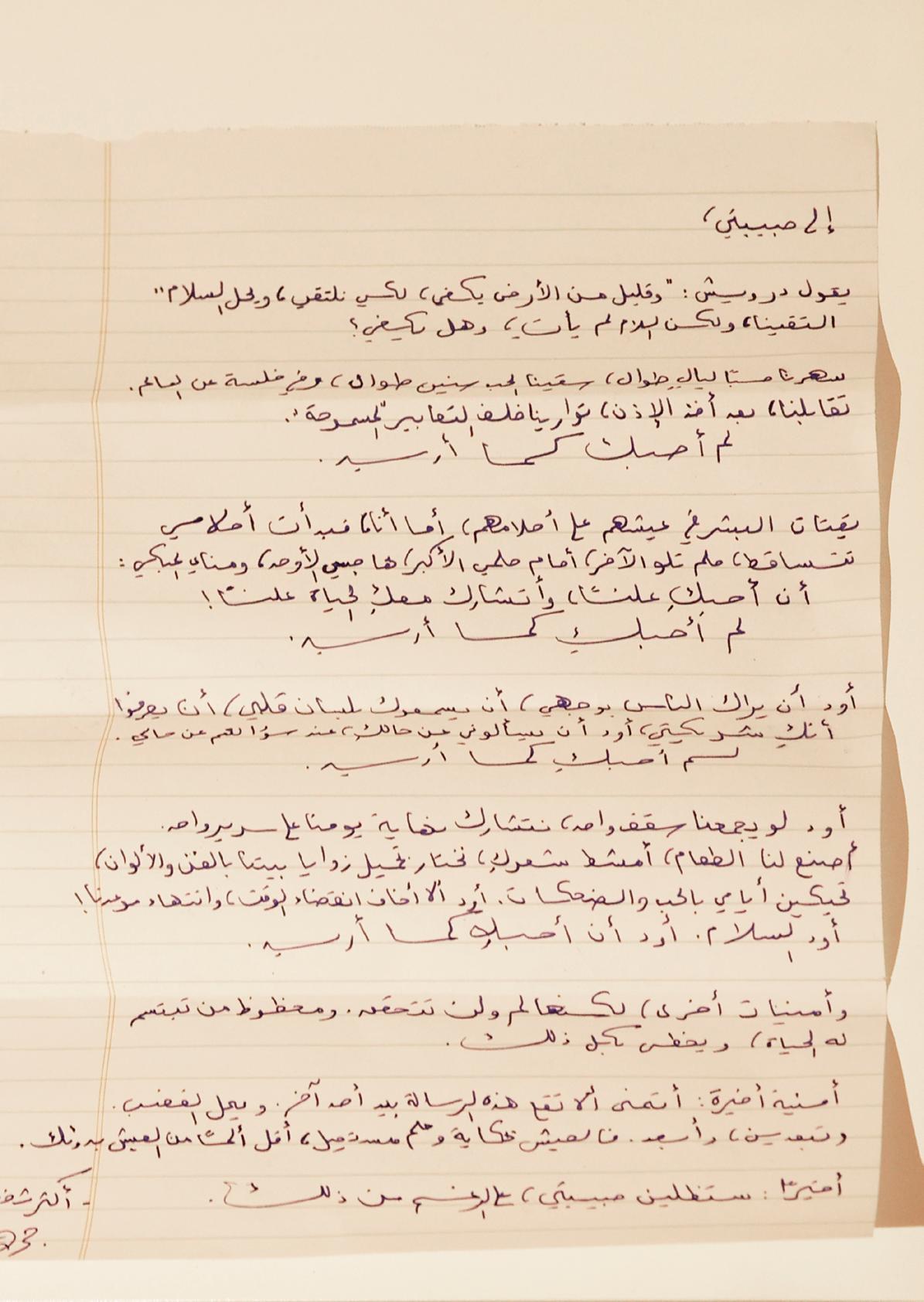 Sara Abdu
Sara Abdu
Now That I Have Lost You in My Dreams Where Do We Meet? (2021)
Sidir and Camphor
12 soap bars: 7 x 12 x 5 cm (each)
The first negotiation with memory is presented as a quiet but solid refusal the finality of memories, the absolute truth and encompassed in the inevitability of death. In her work, Now That I Have Lost You in My Dreams Where Do We Meet? Abdu memorializes dreamscapes in solid soap structures inspired by the ritual of perfuming their body within the Islamic funeral tradition. The precarity of sleep - its in-between life and deathness - folded in a dreamscape, manifests for Abdu a particular window into the psyche, and offers the transient entry for the departed; an invitation to the stripped-down self, comma threaded with memories of the past. Fleeting encounters with past loved ones and dreamscapes brought into focus the final encounter with a tangible body, in which a preoccupation with masking bodily odors, a ritual for the living, became a site for poetic intervention, and perhaps a plea. Abdu mixes camphor and sidir used within the Islamic funeral ritual, to create soap bars; drawing attention to her own relationship with perfuming the body; masking all markers of decay. She imprints on the surface of the soaps a plea, Now That I Have Lost You in My Dreams Where Do We Meet? An attempt to negotiate with death and its ending of all memories the fine threads that connect these different realms are represented through the divine nature of dreams and the abstract nature of memories the works craft a space for memories to occur outside the terrestrial and the body but instead to occur in the intangible and beyond.
Excerpt from curatorial text for Sara Abdu solo show at ATHR Gallery by curated by Maryam Bilal. Courtesy of ATHR Gallery.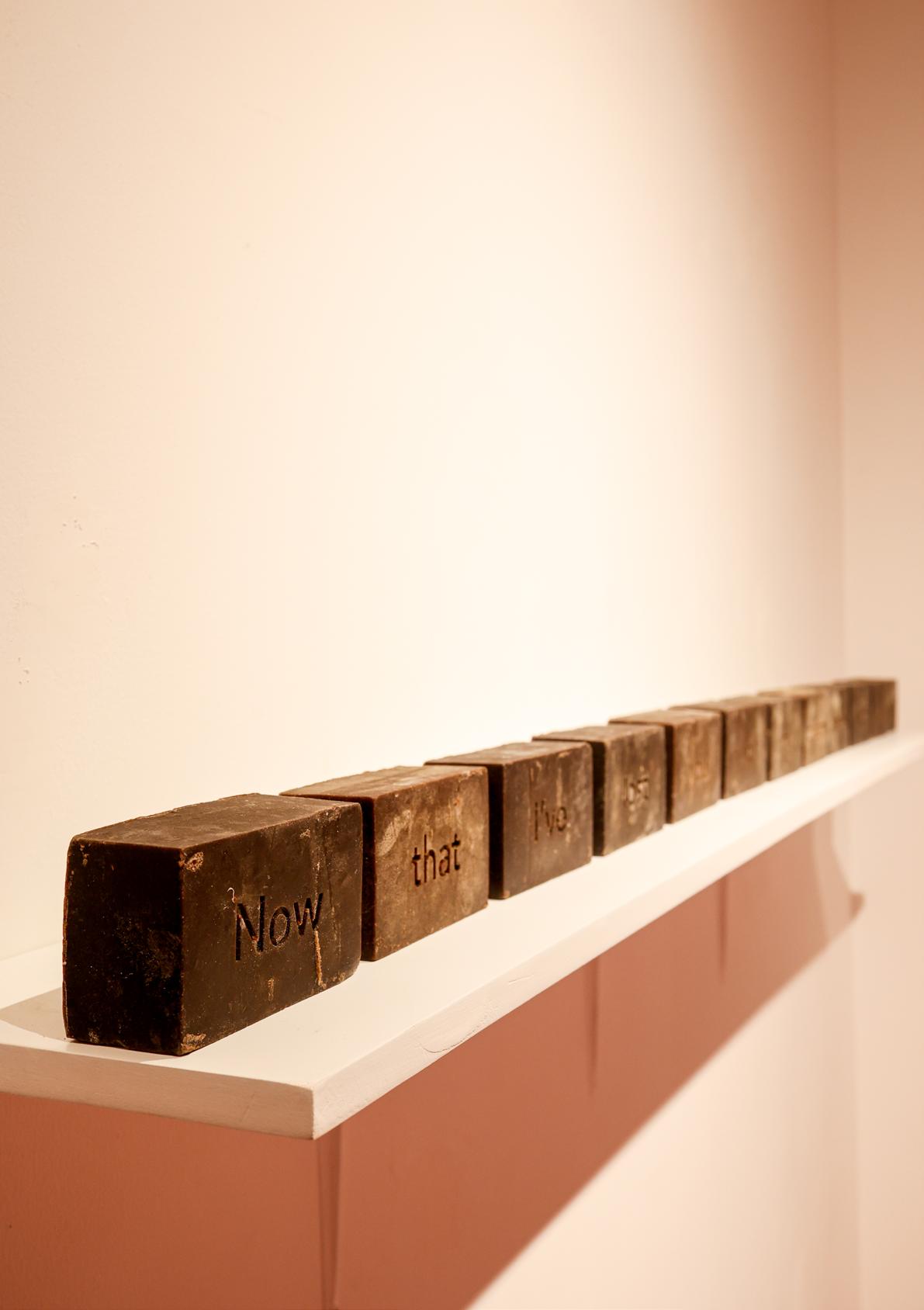
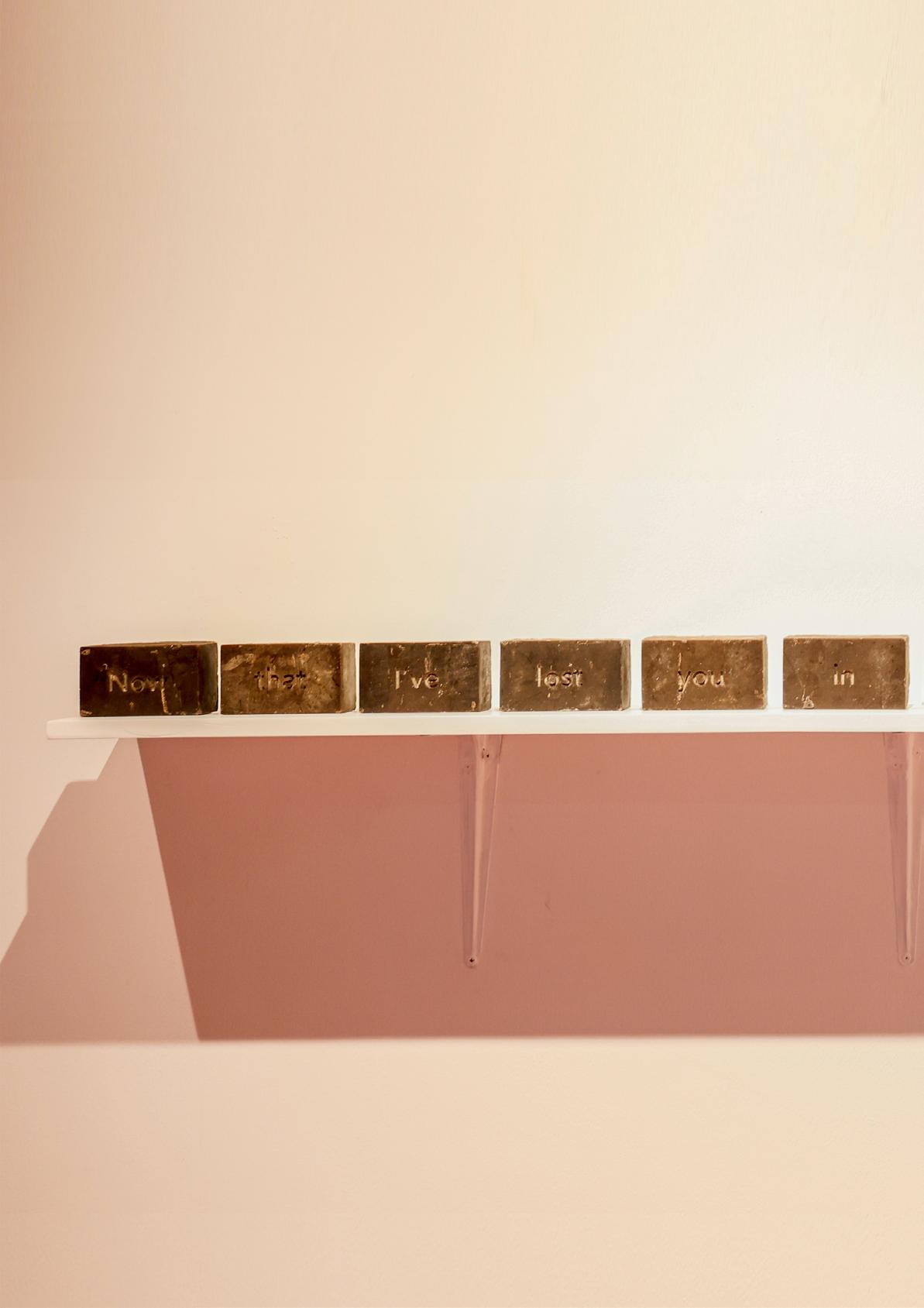
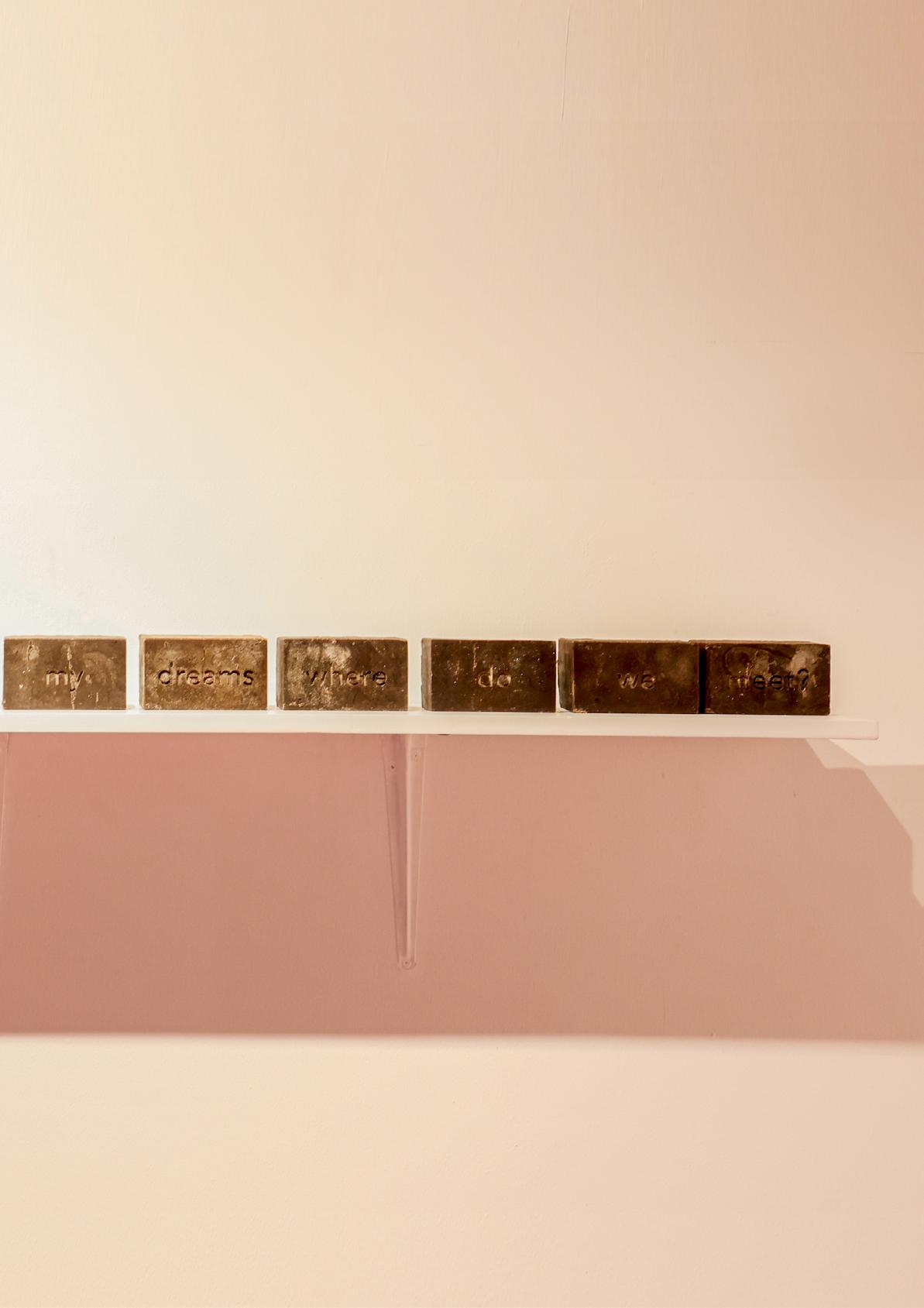
Anhar Salem
Cheese (2017)
Single Channel Video (16:19)
3:34 mins
The predominant audio of the video work is a melody that Anhar made up, even though she isn’t particularly musical or play any instruments. The tune came to her after she thought that her partner had cut her off, after he was visiting her in Jeddah from the Eastern Province. The footage of the horizon from the car window are clips that Vladimir had shared from his almost 13-hour drive to Jeddah. Film is an important part of Anhar and Vladimir’s relationship; they had watched 657 movies together as a way to connect despite their long-distance relationship. The still from the film Romamor, directed by Joseph Morder, shows briefly in Cheese and was a critical movie for the pair at the time Anhar made the video and is a big influence on this piece. The sharing of these clips between the two was a way for them to transcend distance and to bridge between them, even if virtually. Anhar considers the film as a visual poem dedicated to Vladimir and named it Cheese because she endearingly wanted to name after something he loved.
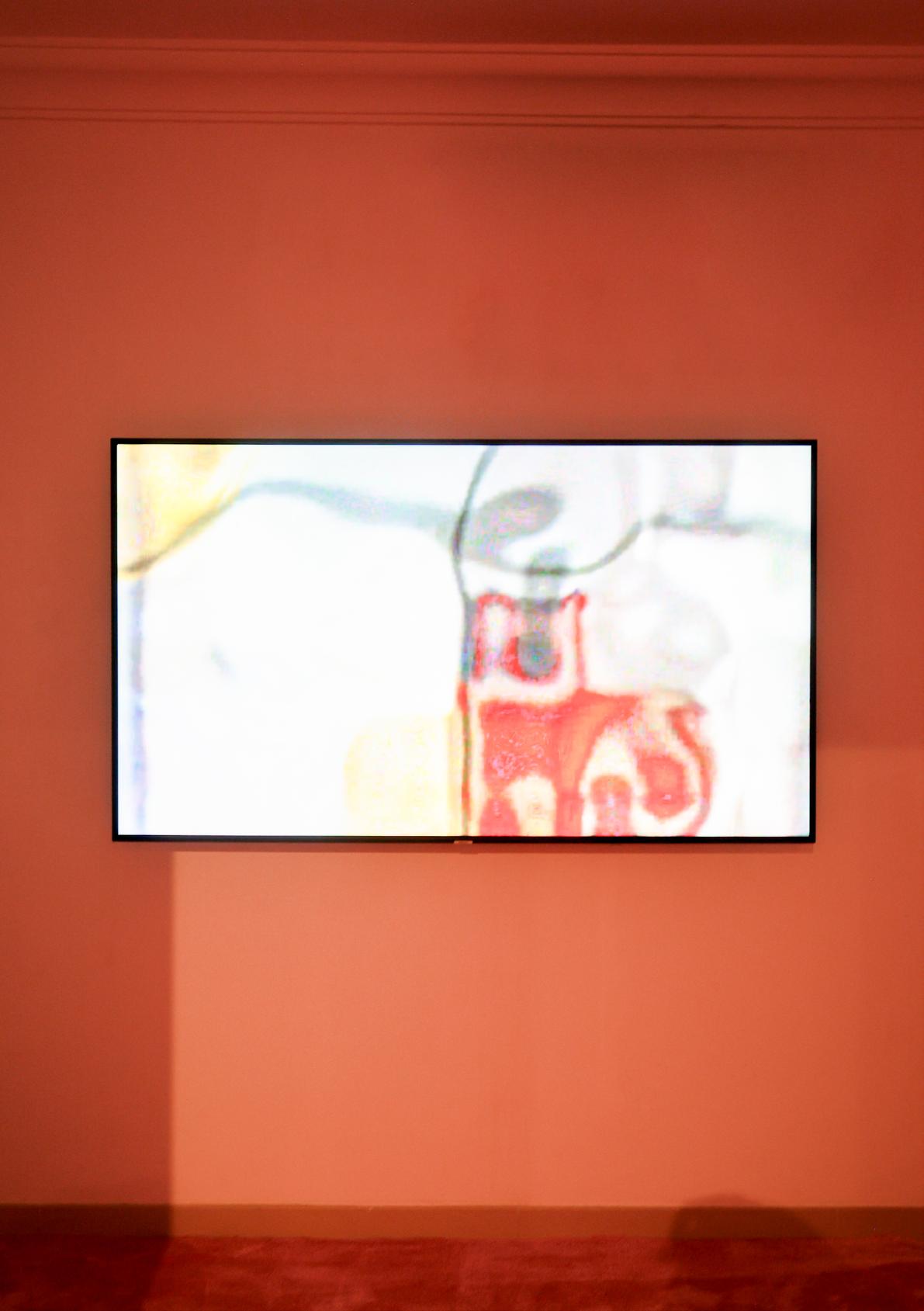
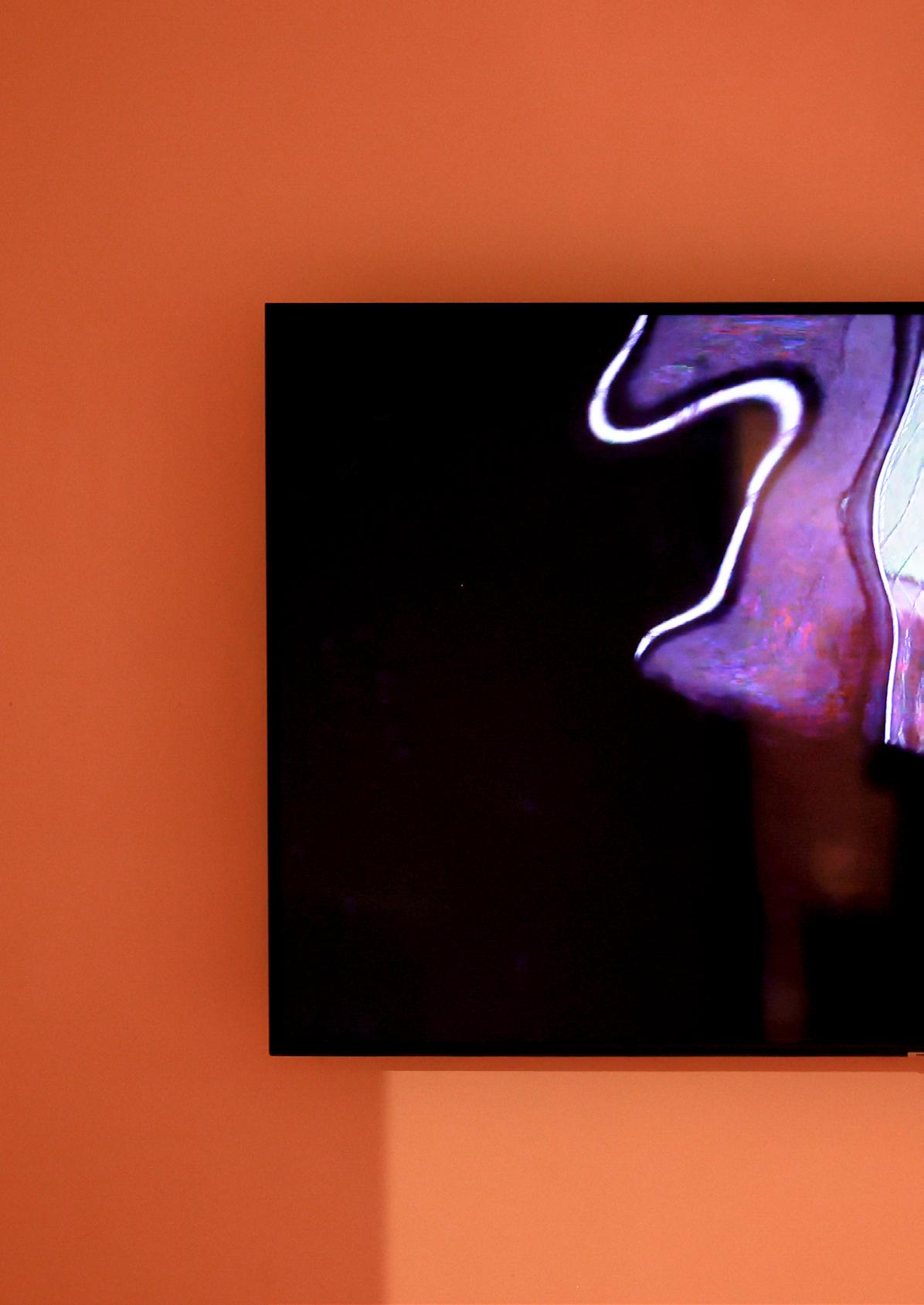
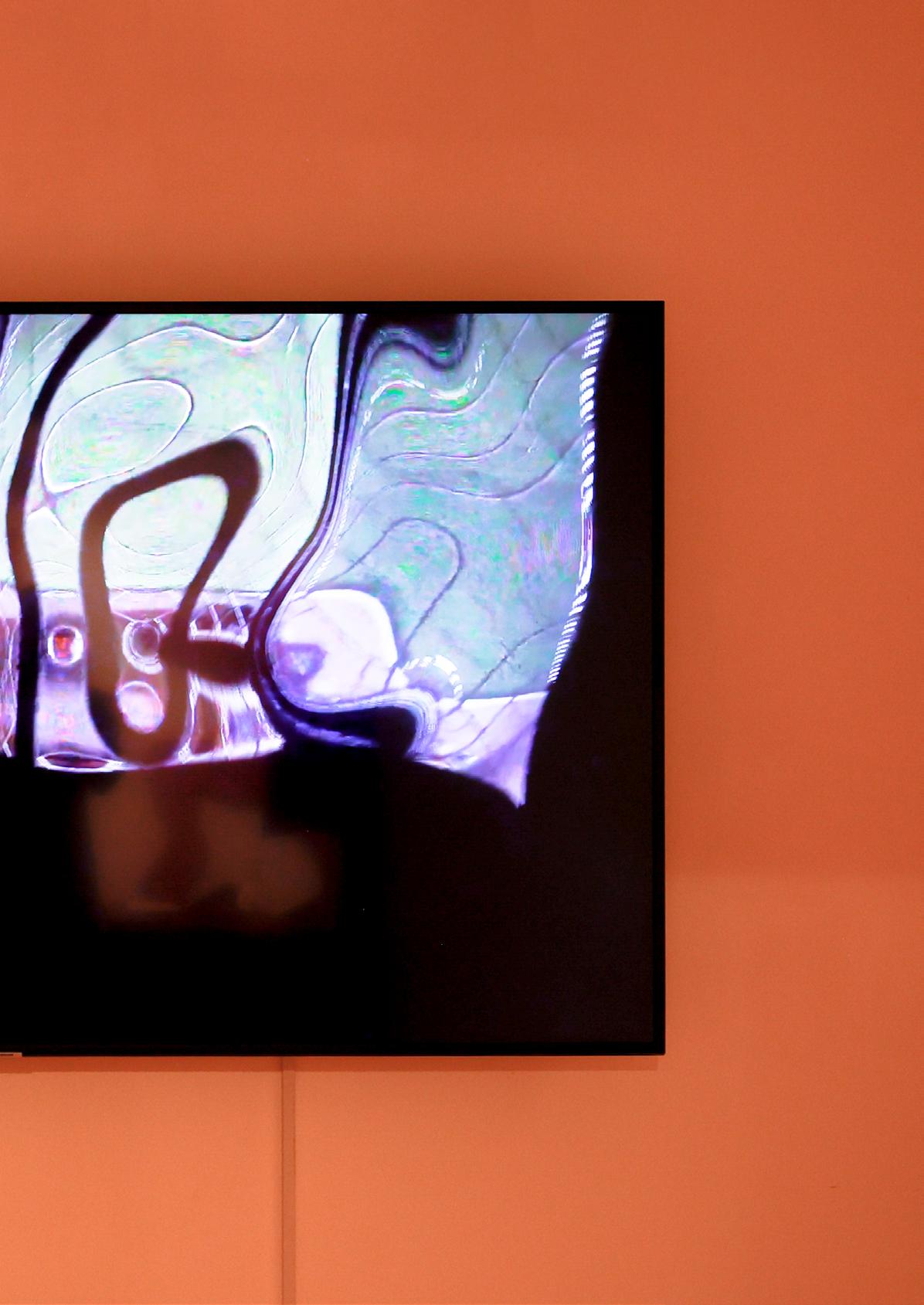
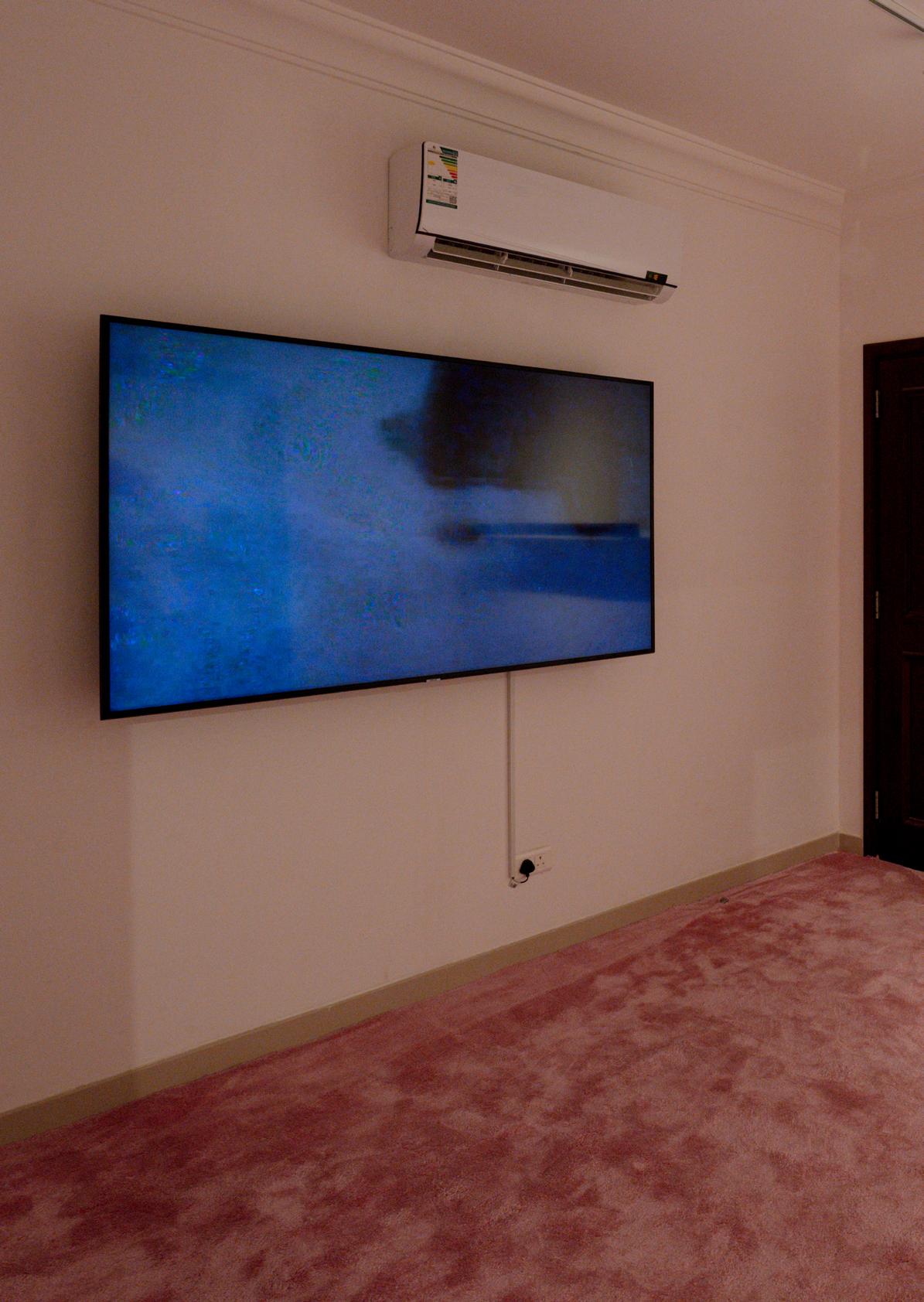
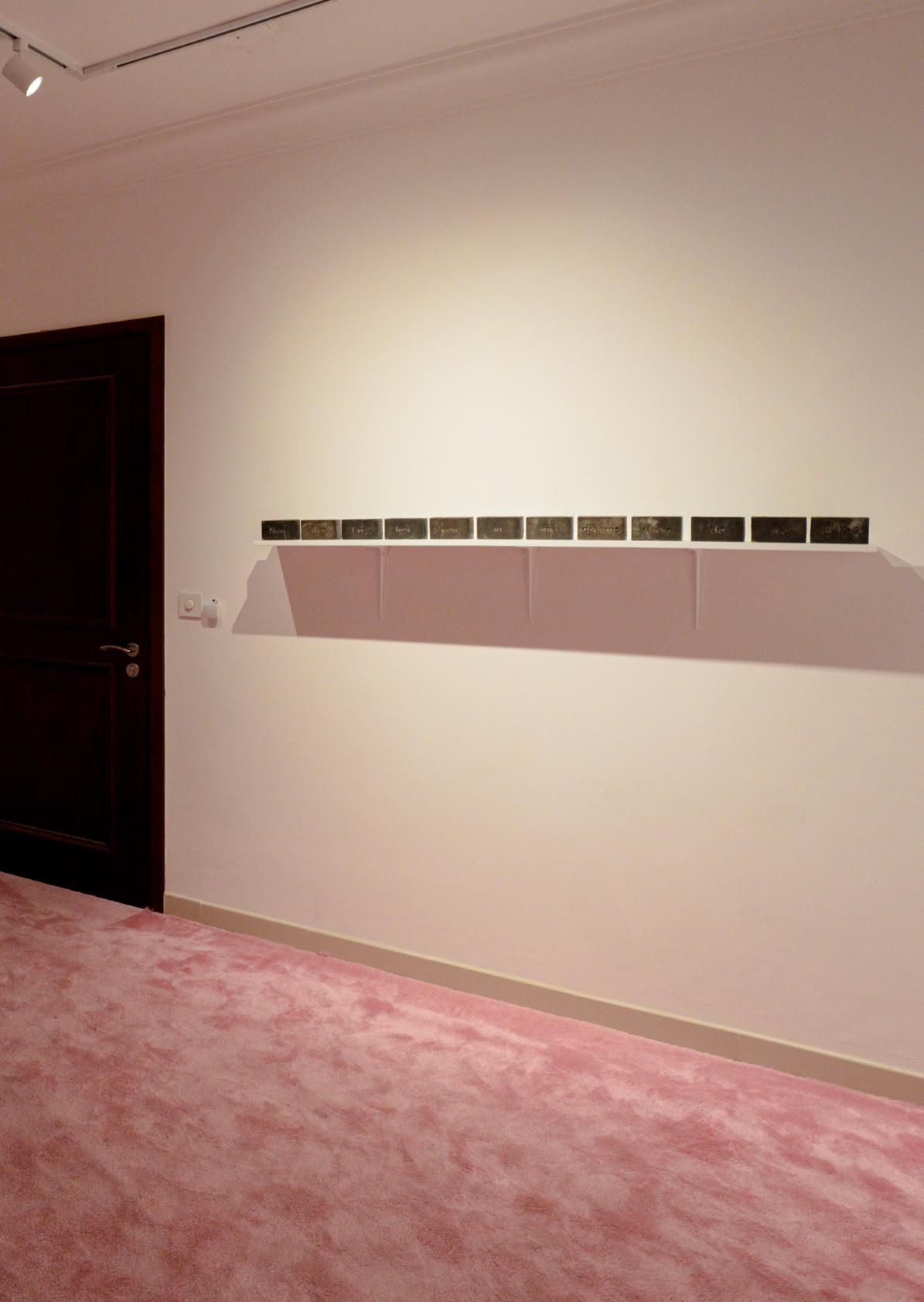
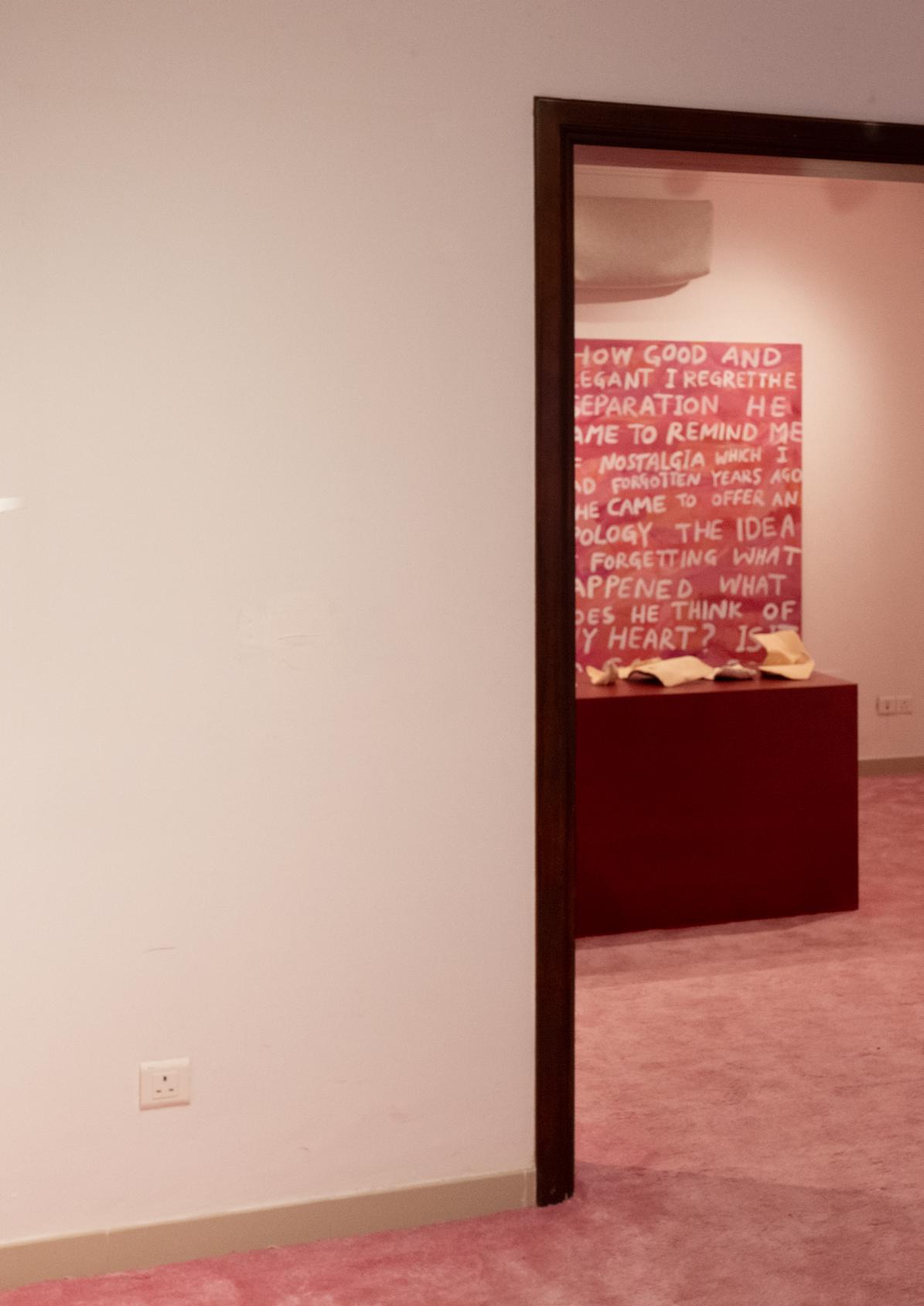
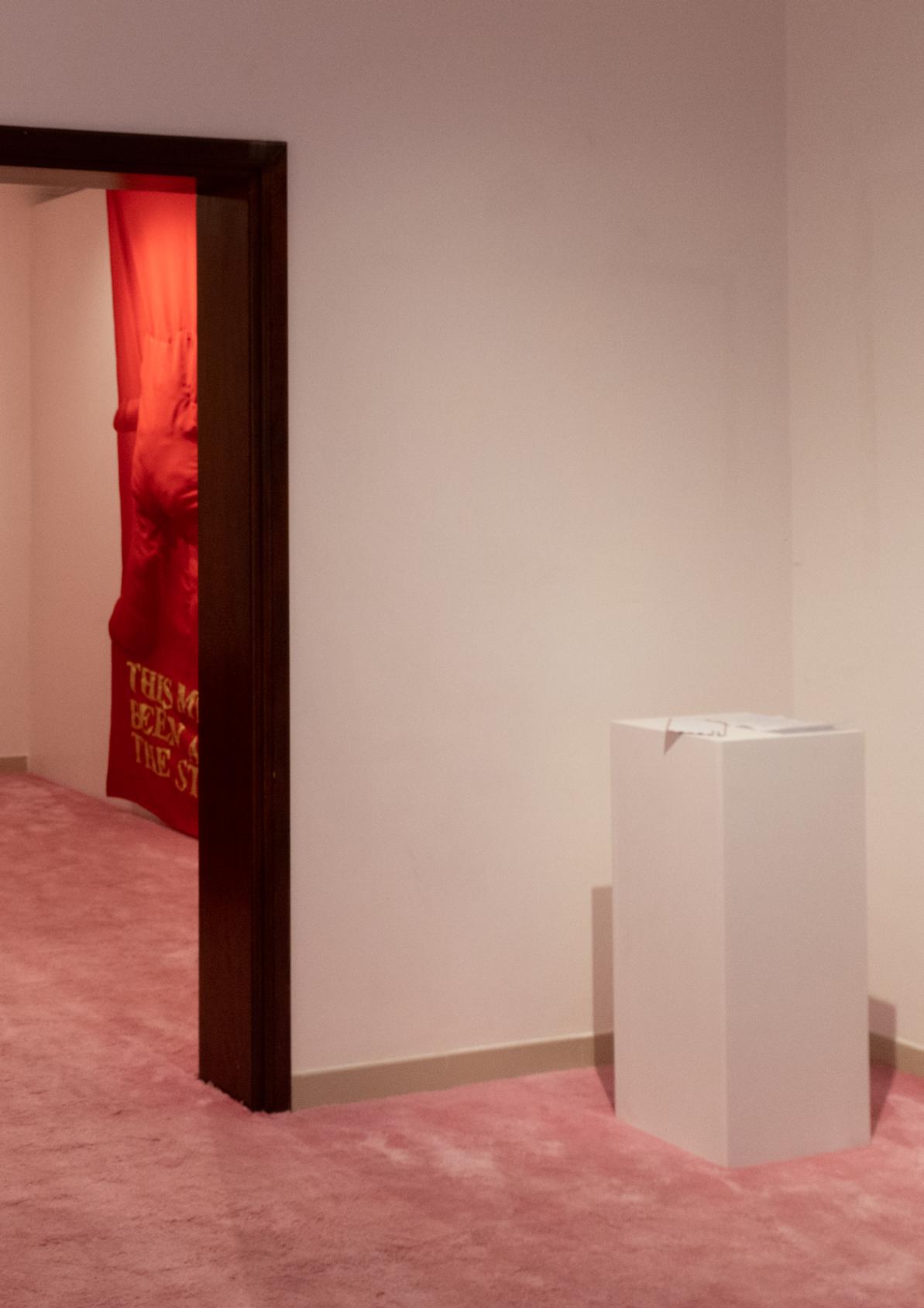
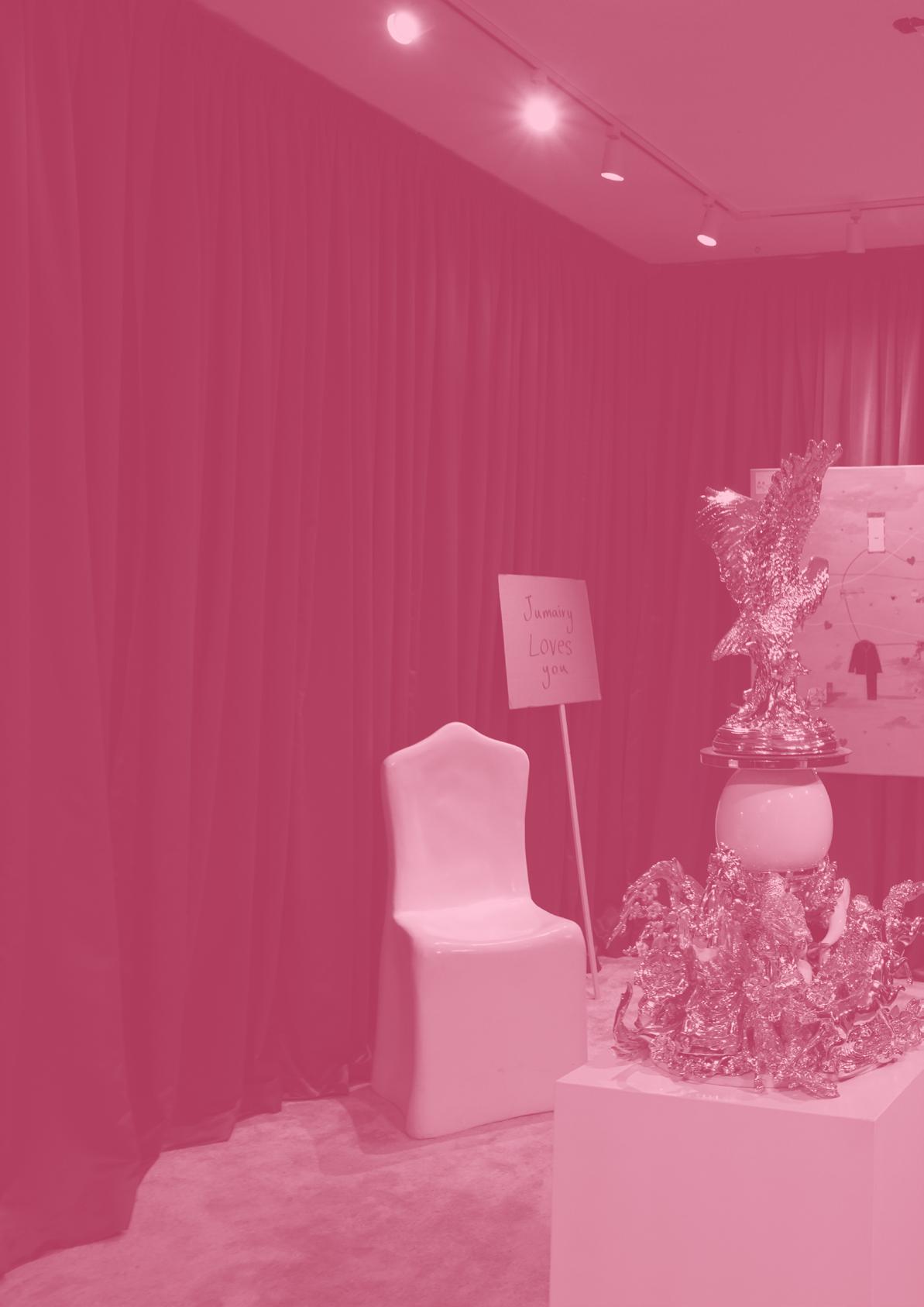
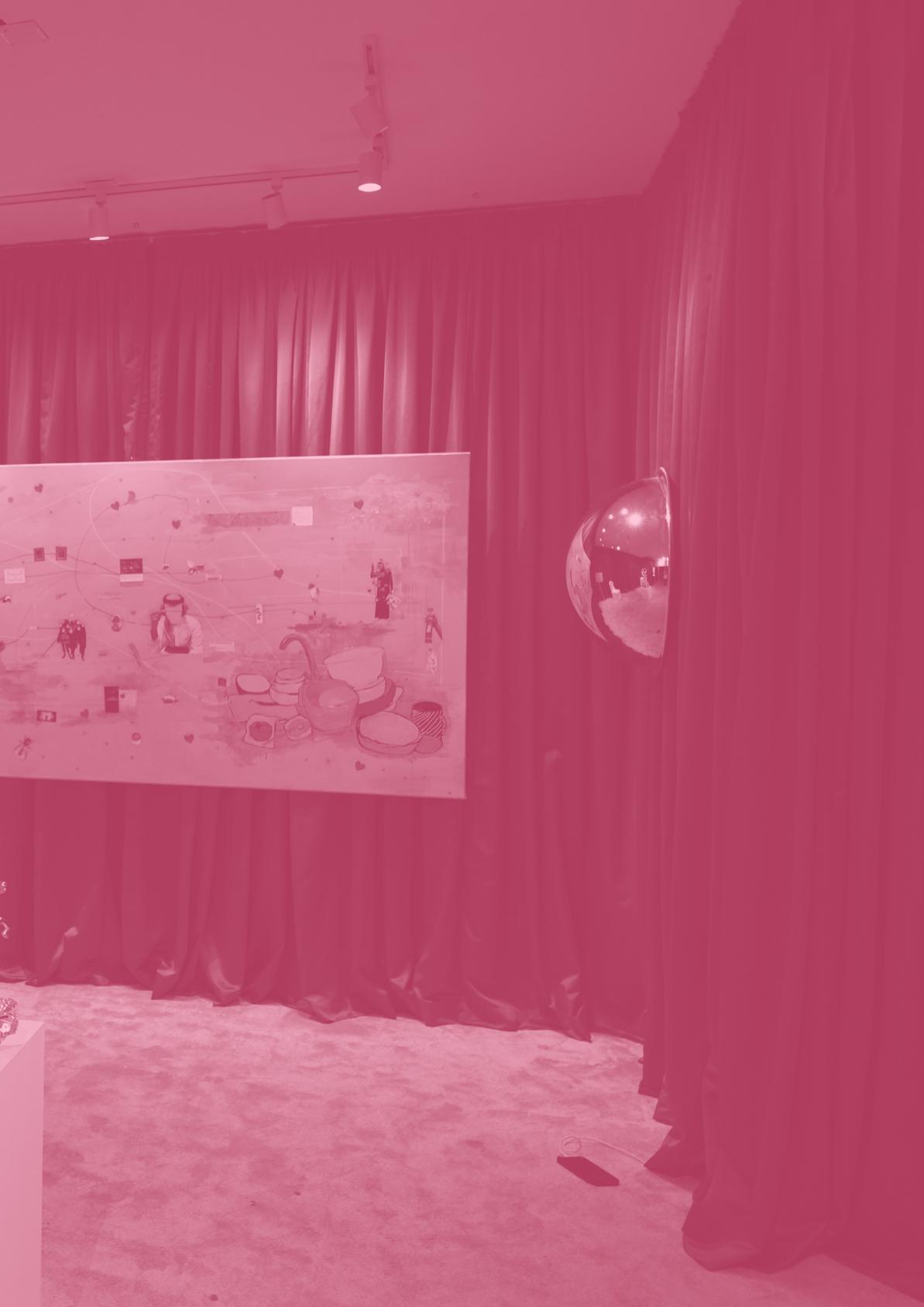
Ayman Daydban Yossri
2023( فقوم Printed t-shirt
65 x 50 cm (T-shirt size Large)
First shown in Mostly Visible (2013) - curated by Ashraf Fayadh. The t-shirt as part of a performance piece.
Courtesy of ATHR Gallery.

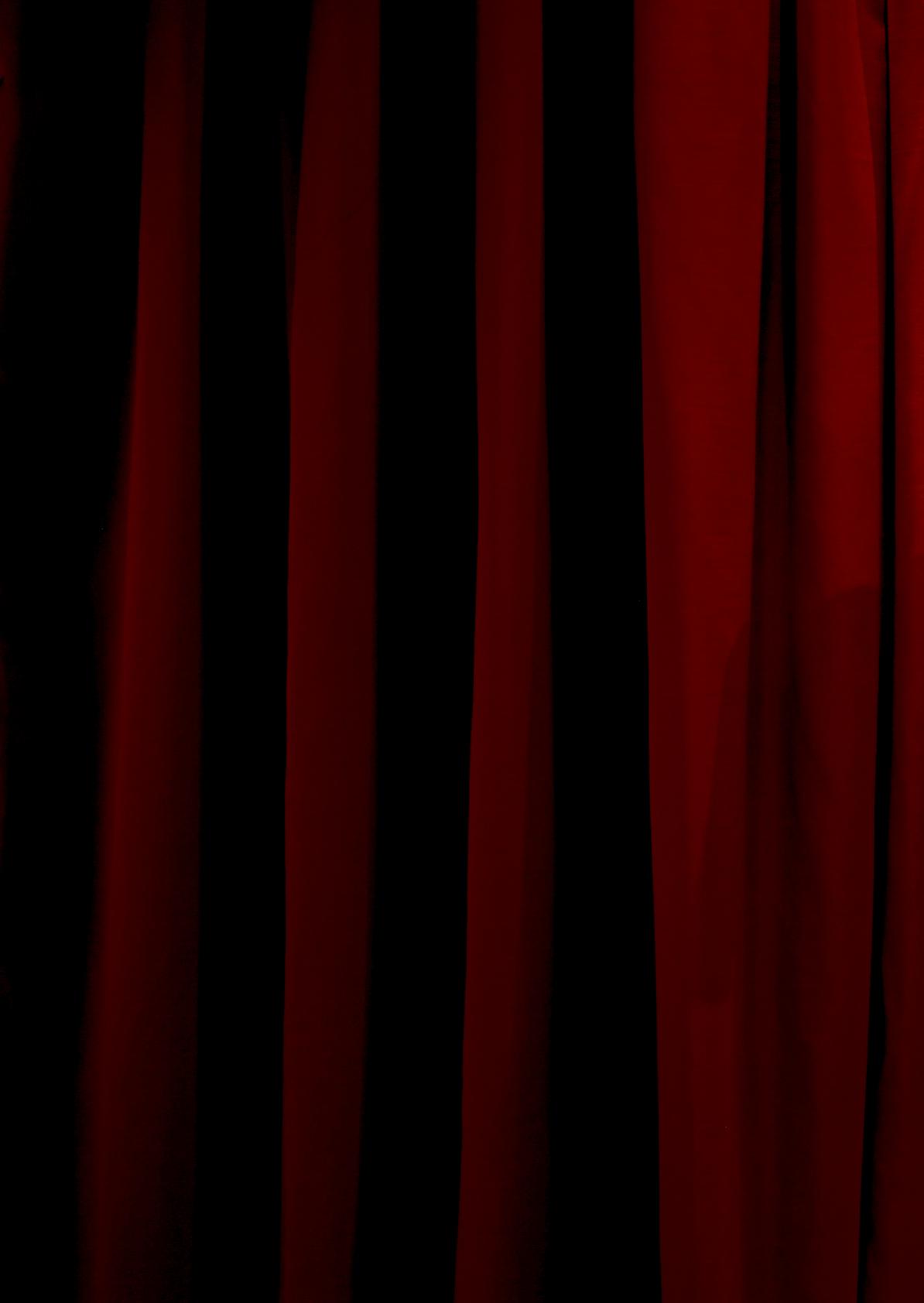
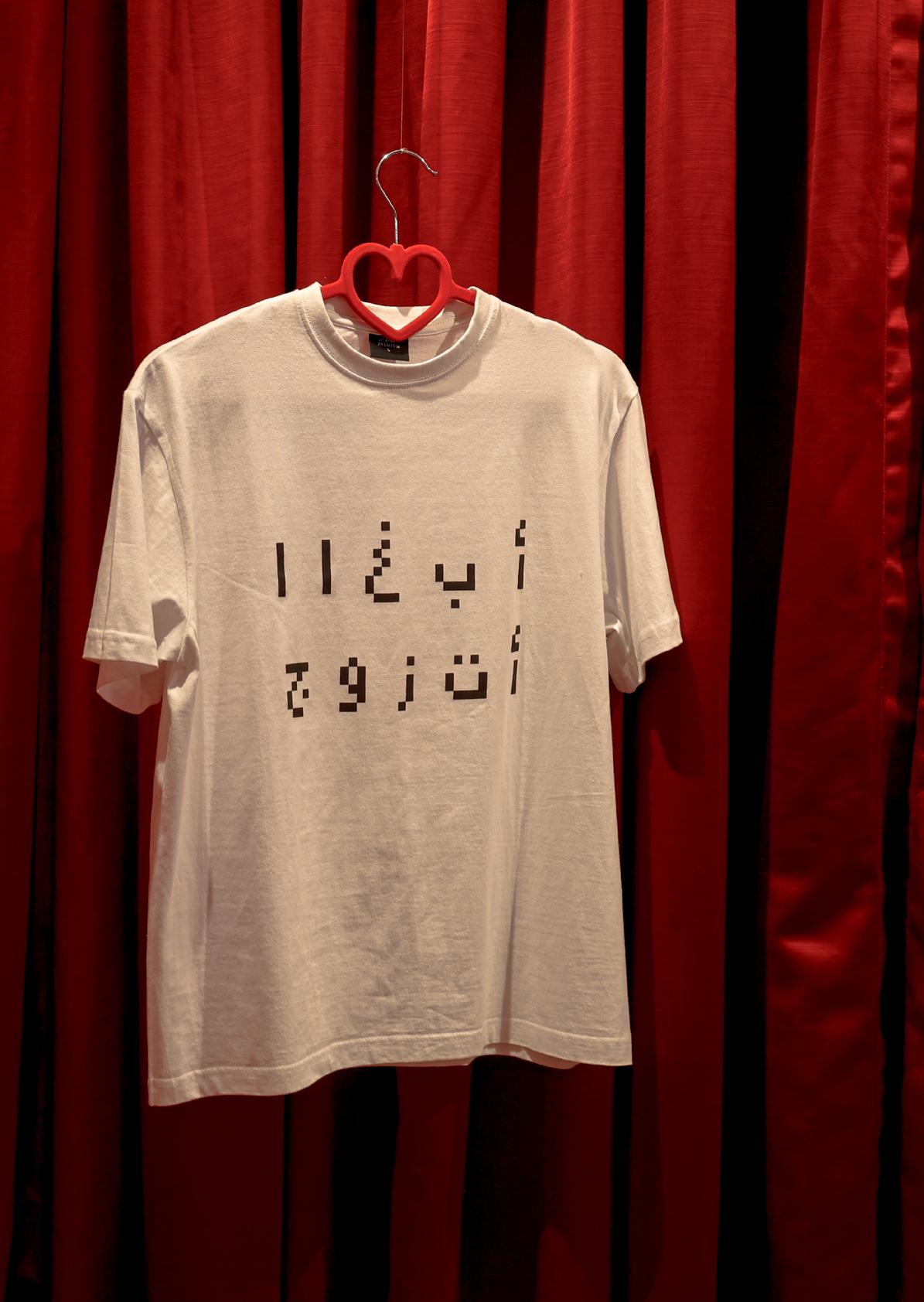 Dur Kattan
Dur Kattan
Cravings (2023)
Interactive installation
Various Dimensions
“It is said that to truly love is to enter the realm of chaos, loss of control and perspective, and that the greater the love the more one loses the ability to protect themselves.
The one thing that seems to be guaranteed with love is that it will hurt, be it by the loss of love itself, disappointment in love and what it should/could have been, or even the loss of a beloved one to death…it all hurts.
To love is to know the loss of love, heartbreak is unavoidable unless one chooses not to truly love at all. David Buss, the author of The Evolution of Desire: Strategies of Human Mating, rated a heart broken from love lost among the most stressful life events a person can experience, it’s exceeded in psychological pain only by horrific events, such as the loss of a child.
…Yet humans crave to experience love and heartache time after time.
Craving is a lighthearted yet profound sensory installation that explores the different tastes of feelings within the realm of love. As love takes us to the land of senses in which logic seizes to exist, the installation uses different ice-cream flavors representing love, passion, and heartache inviting visitors to enter a sensory experience, to taste the feelings they have experienced in their love relationships.
Visitors will select their basic stage in love and add to it a deeper spice by adding toppings that trigger different tastes ranging from bland, unpalatable, sour, spicy, to sweet. Each visitor will have their own unique taste within love based on the flavor and toppings they choose, allowing each visitor to complete their narrative about love and heartache for themselves.
Cravings aims to manifests tasting the different feelings within love in real sensory form, though the work may be viewed as humorous, one would do well to remember that humor is a mature physiological defense mechanism that helps temper our more painful experiences.
Text supplied by artist.

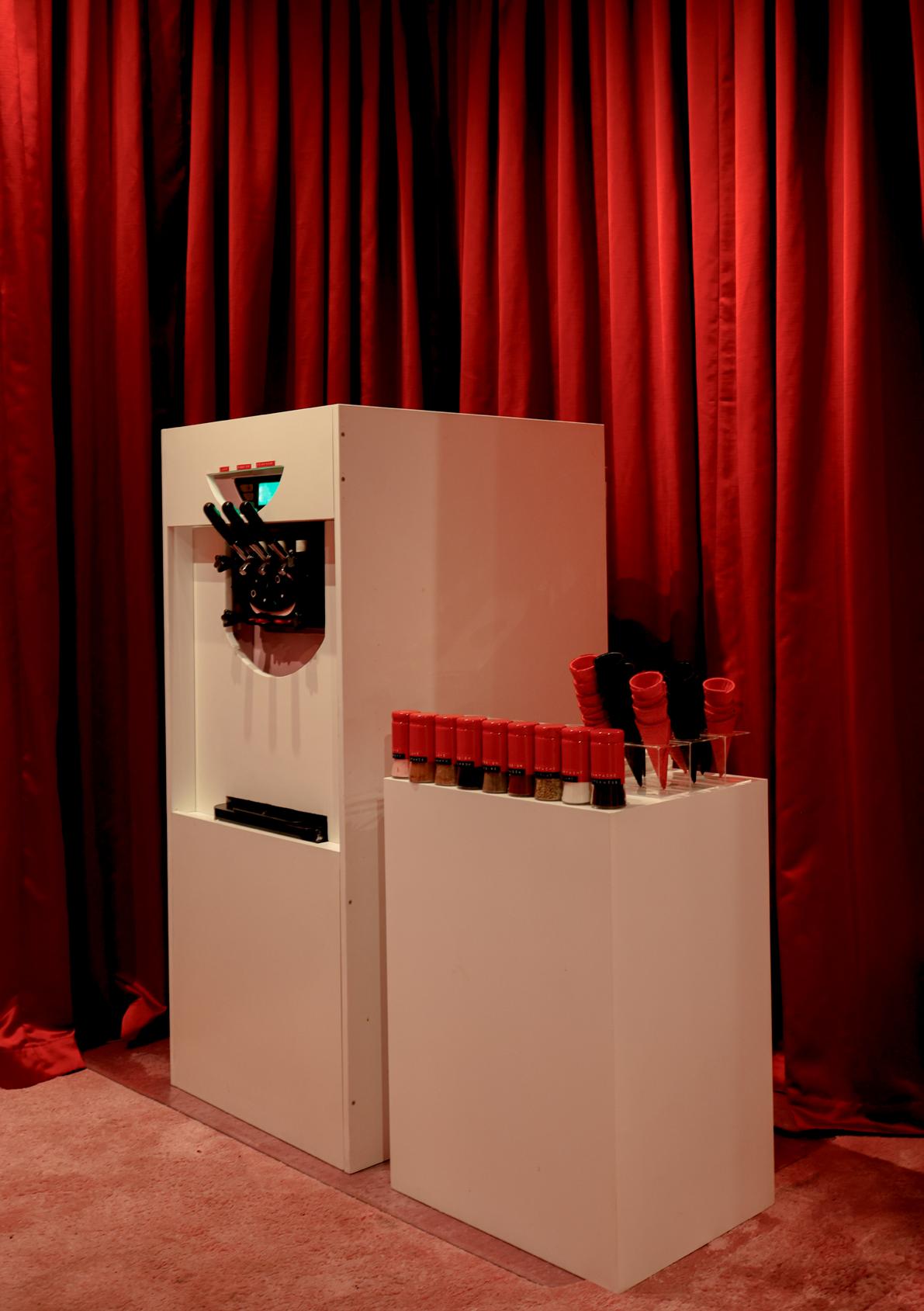
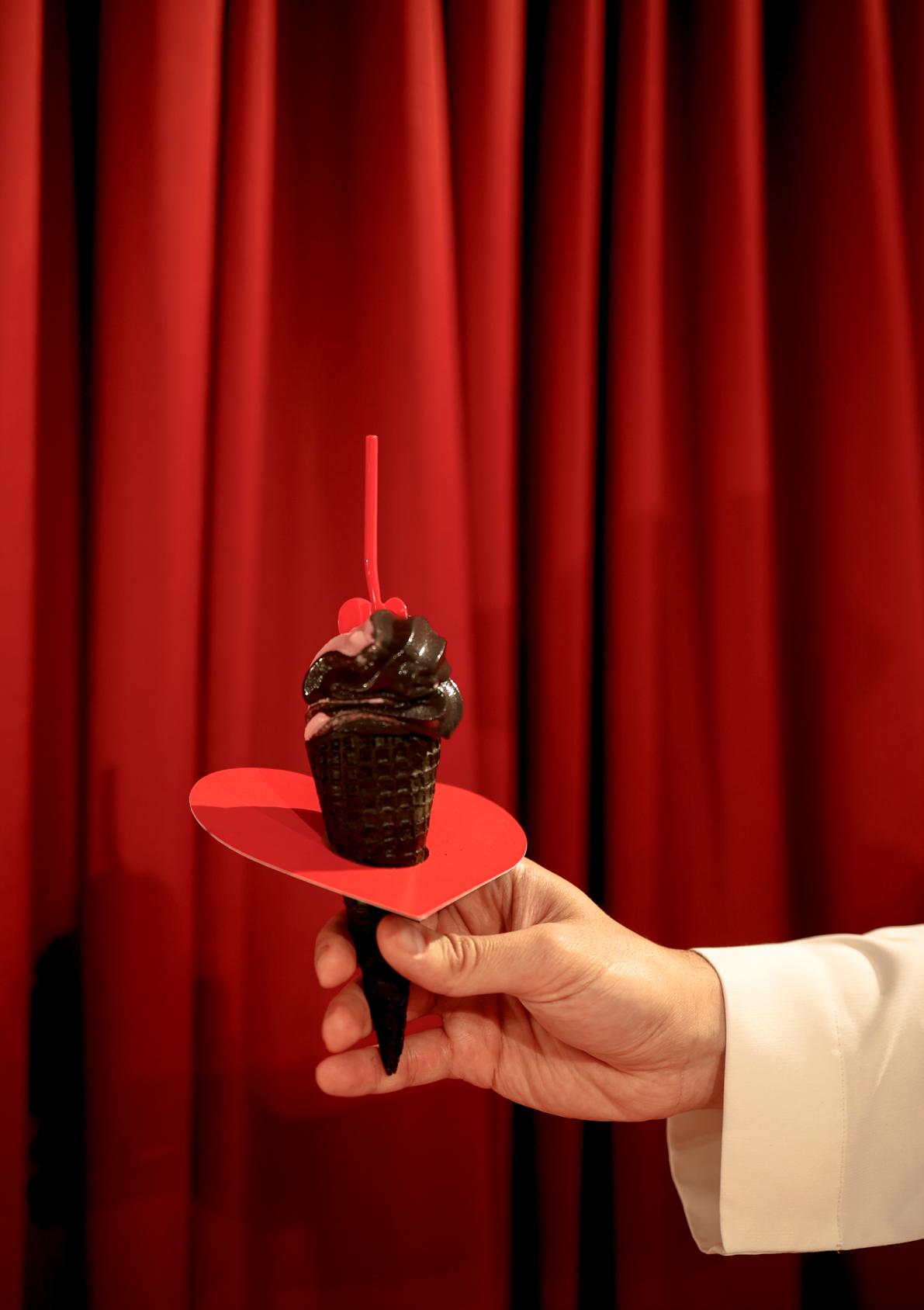 Haitham Alsharif
Haitham Alsharif
Tainted Self (2023)
Convex mirror - found object
60 cm diameter
With Tainted Self, I want to touch on the serious parts of a breakup, the long-lasting effects that change the person you were during the relationship and before that. I have never been a person that agrees with being “emotional” after a breakup, I believe when it is over it is over and a new version of you is born with a new take on life - that could be either positive or negative. When I think about my personal experience and what I have seen with friends and close ones, I am very afraid and saddened by how heartbreak can make you lose part of yourself completely, where you can physically and consciously feel yourself become a different person and you can see that other part of you or version of you locked up away, you’re not crying or upset or going through a breakdown, you are consciously awake and can see that you are now a different person, that you have been affected to your core and in some lost part of yourself.
To reiterate what I want to depict is not emotions, it is the conscious realization of who you will never be again; the notion and understanding that this part of you or this version of yourself is gone. In the site-specific installation, the convex mirror distorts the viewer’s reflection, and especially if two people are standing in front of it, one is always distorted beyond recognition.
The intention of the piece is to have whoever is looking at their reflection in the mir ror to see an unsettling reflection that is a visual representation of the part of them that materializes af ter a serious heartbreak. And to be confronted with the terrifying reality that this might be their new-self and that they need to bid farewell to the person or part of the person that they see distorted in the reflection.
Text supplied by artist.
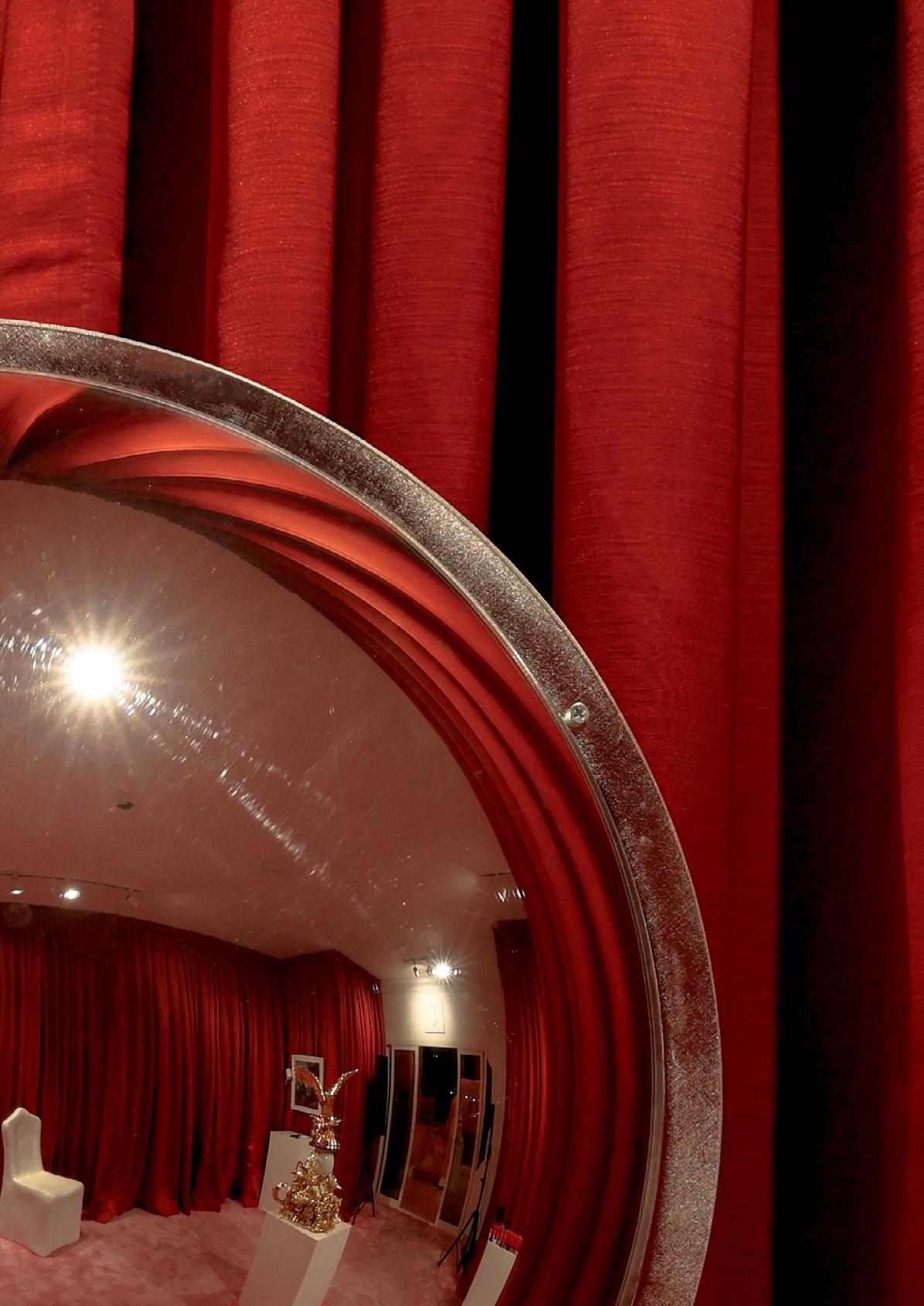
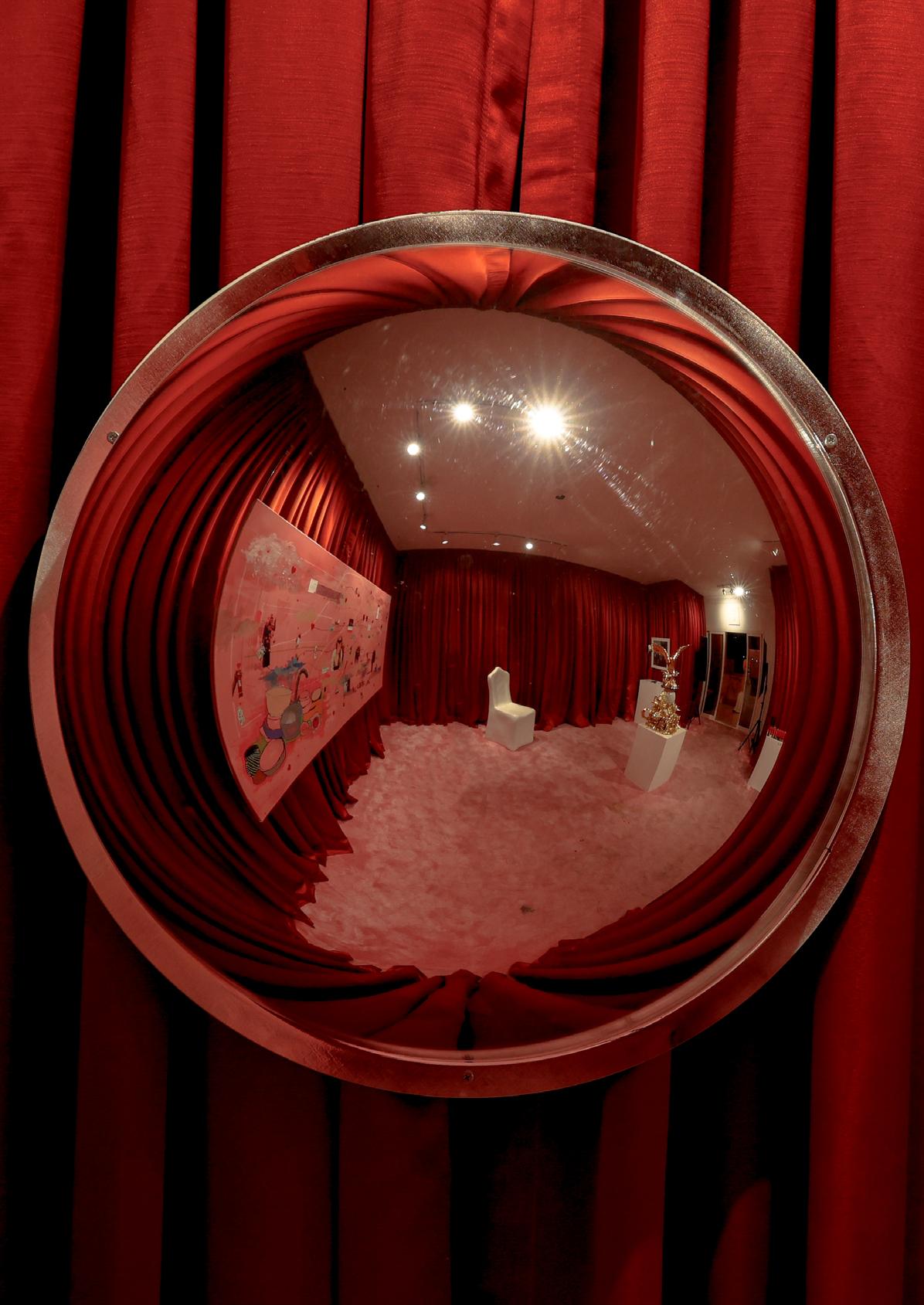
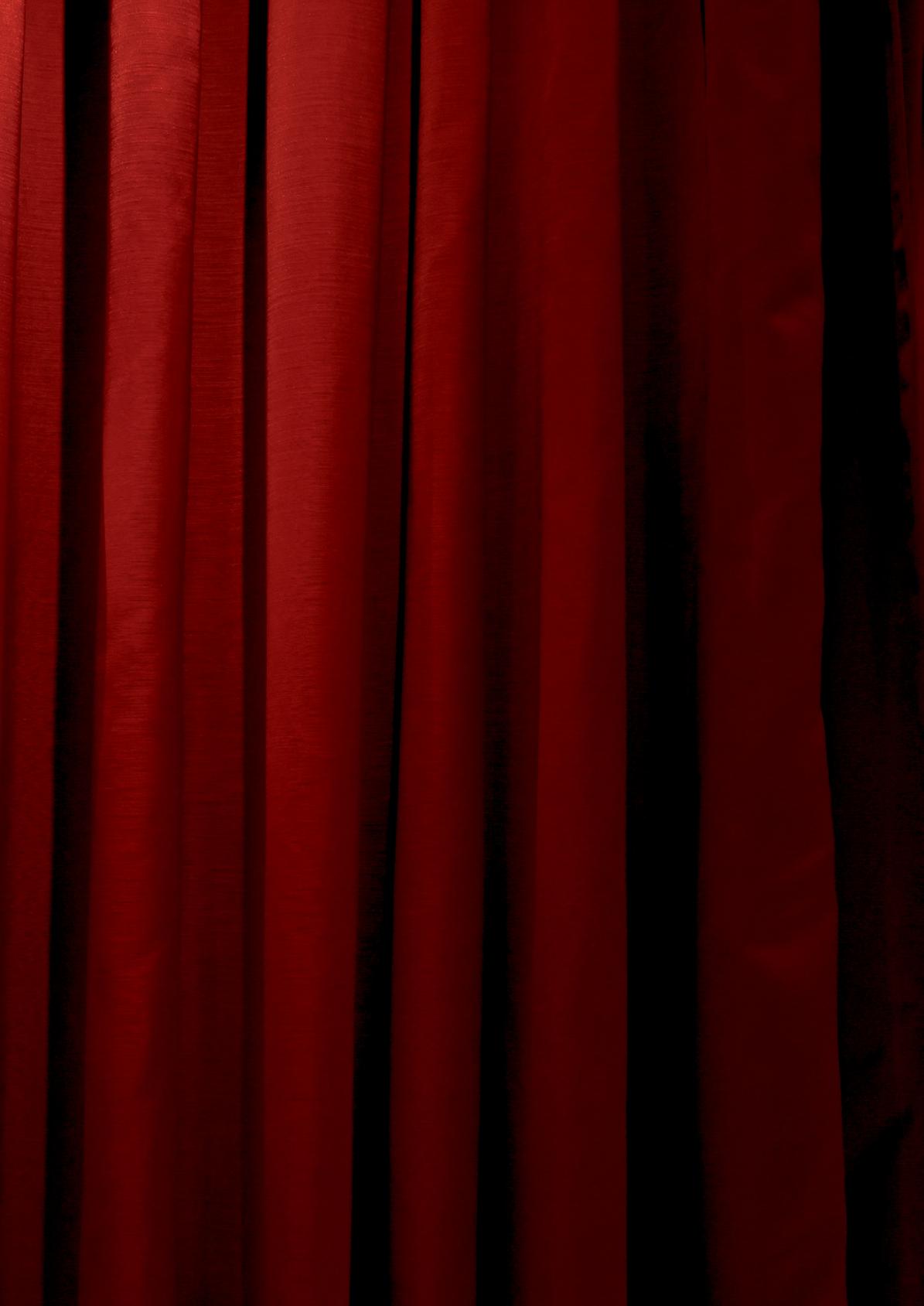 Sarah Abu Abdallah
Sarah Abu Abdallah
33 (2023)
Mixed media on stretched canvas
240 x 120 cm
33 is an extension of Sarah’s diaristic works, where mundane activities, shared public spaces and the architecture of the home are recast as relatable subjects, through which to investigate the subtexts of everyday life. Abu Abdullah’s subjects can be seemingly unrelated on a surface level; however, her approach is one of abstract logic, wherein seemingly abstracted fragments can be understood as outlying expressions of a significant, underlying nar rative that they share. Similar to her other large scale paintings Abu Abdallah introduces collage connected together in a form of mind map. The canvas acts as a space for Sarah to be free with my train of thought to go where it wants and to get translated to collage and painting. The motifs used vary but are a clear product of her environment, they represent different things alone, but when they come together, they make a whole that is totally unique them.
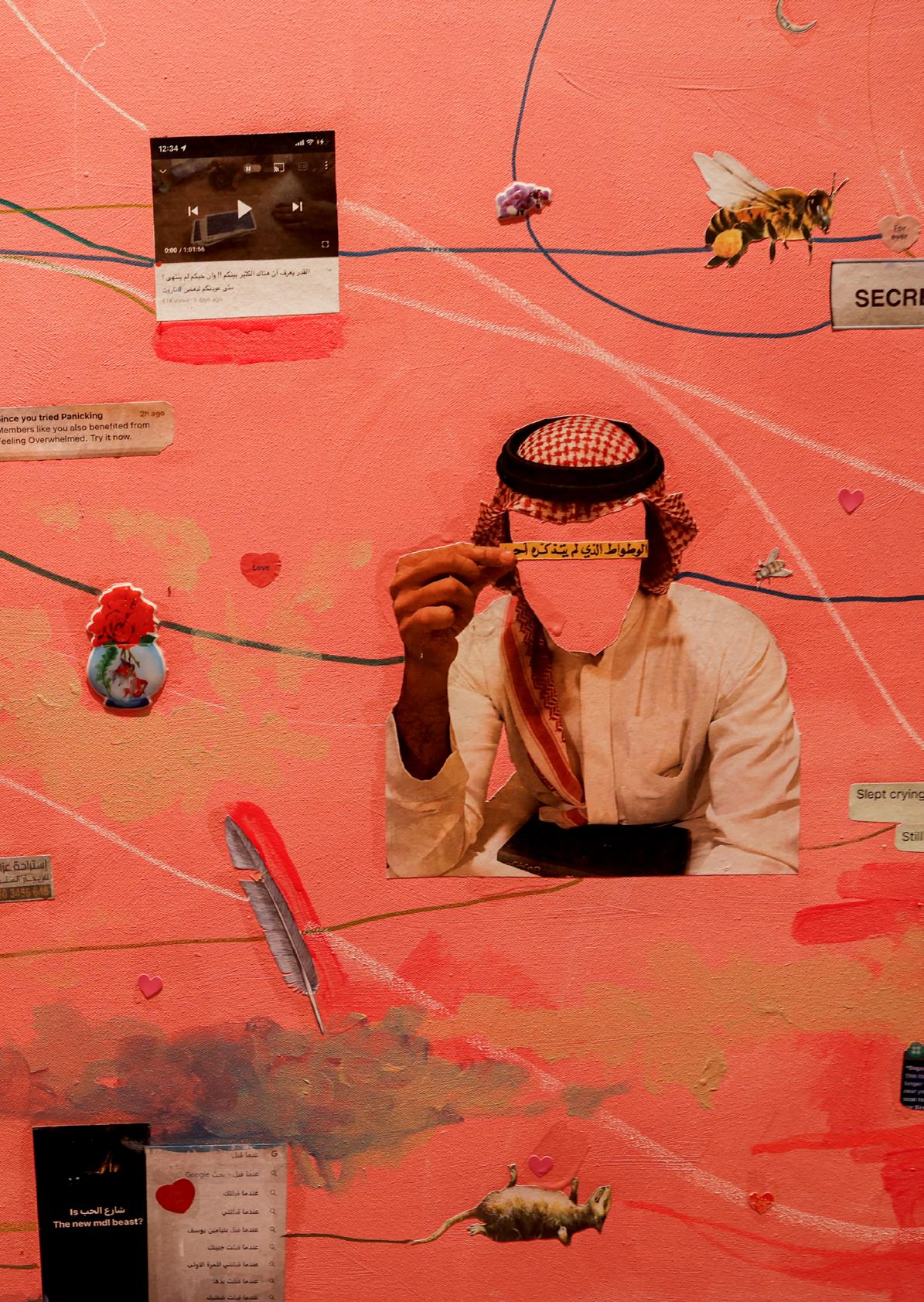

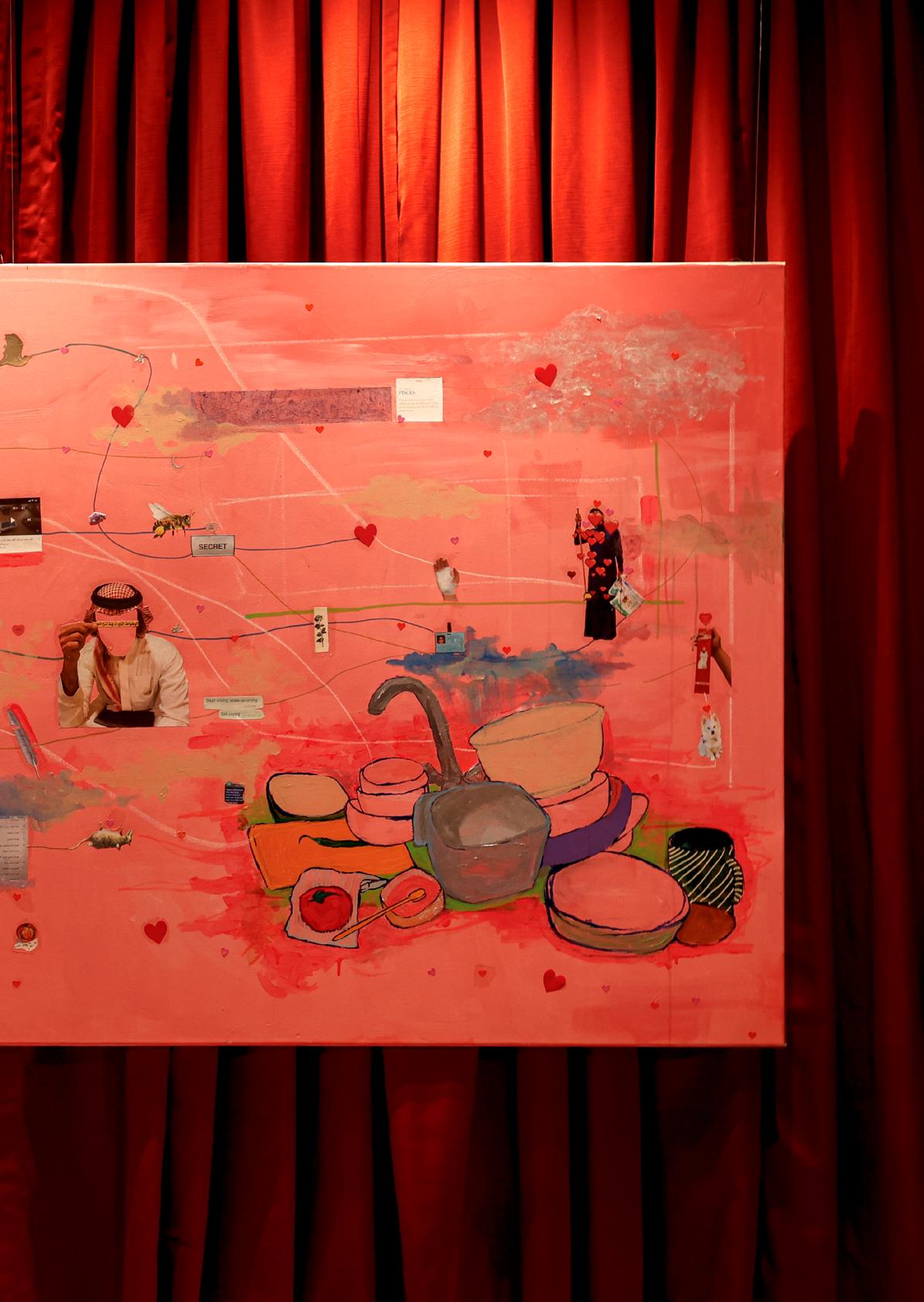
Badiya
Guest Chair Prototype 2.0 (2022)
Fiber Glass and plaster Finish
93 x 52 x 43 cm
“The Guest Chair is common object in all social gatherings. It has the unique ability to be part of both sad and happy occasions by only covering it with a fabric. In this concept we tried to rethink of a new way of remaking the chair from its ordinary production methods, the final object comes in a silhouette materializing its form, weight and material.”
Text supplied by artist.
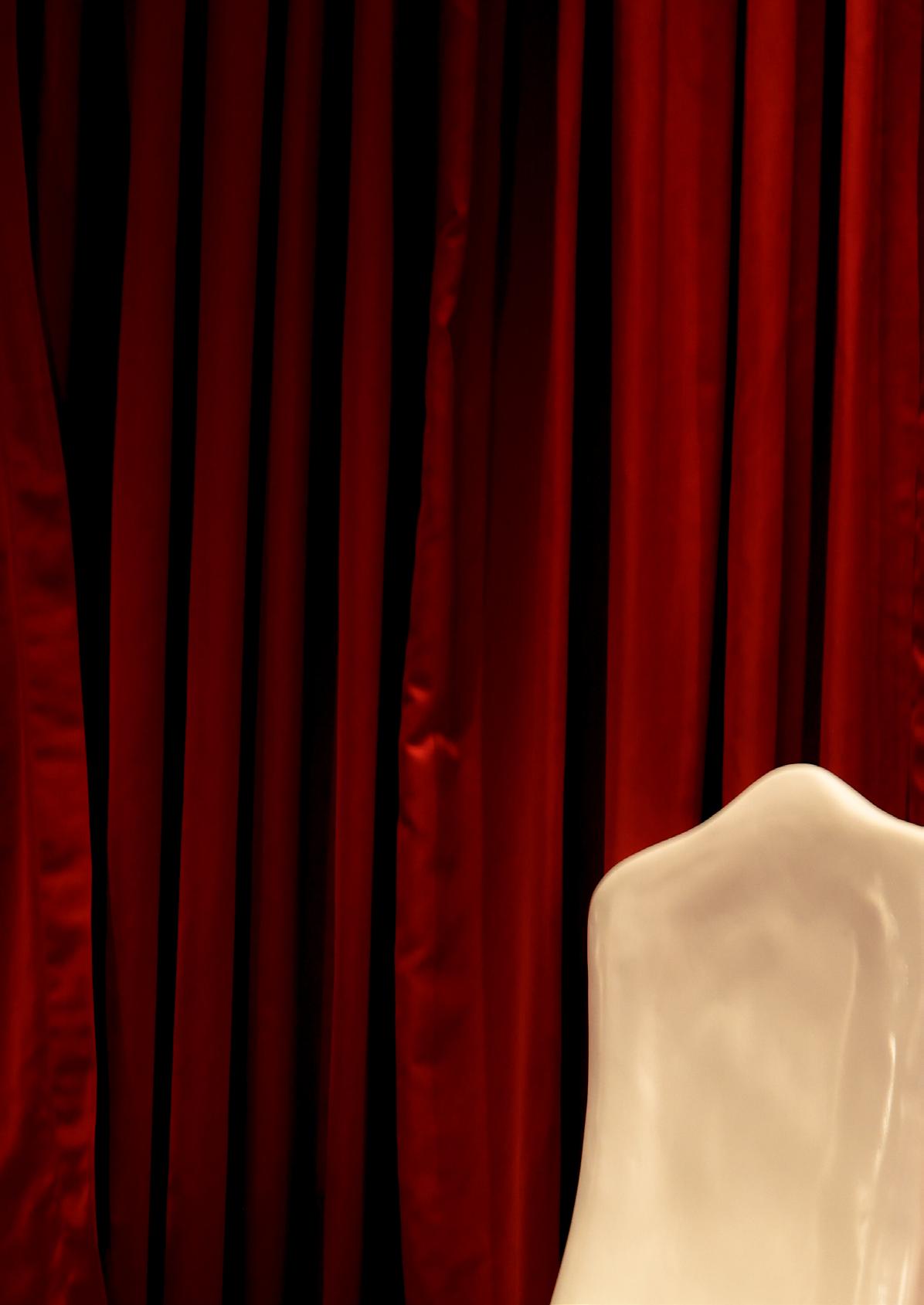

 Ibrahim Romman
Ibrahim Romman
Assemblage (2023)
Installation - Found Object
70 x 50 x 50 cm
In Assemblage, Romman questions the influences between East and West by “reappropriating” found material. He explores Arab cultural identity through semiotics, visual language, and the decisions that lead us to our chosen aesthetics.
As part of his extensive research titled Gharbi Fi Baladi, the artist conducted studies on Arab aesthetics and impressions of opulence, success, and “culture”. This research is particularly focused on notions of Westernized beauty and style standards, as appropriated by Arabs throughout travels and in diaspora.
Here, in Assemblage 1, Romman chooses to compile a collection of found gilded objects, which begs the question, what is Saudi aesthetic identity, and where does it come from?


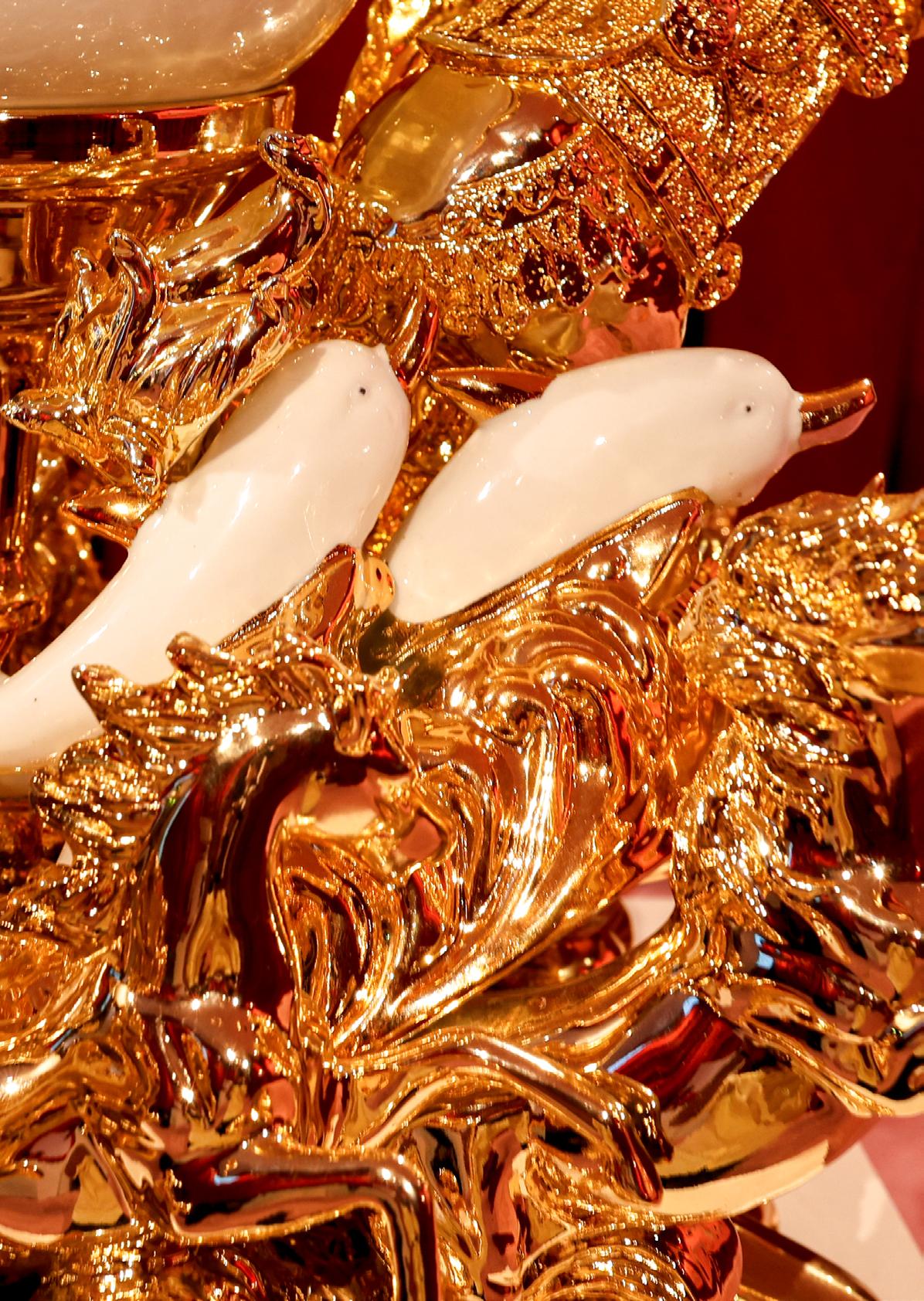


Sultan Mutrad
دهشم - Scene (2023)
Photograph printed on matte photo-paper
A4 booklet
65 x 40 cm
297 x 210 mm
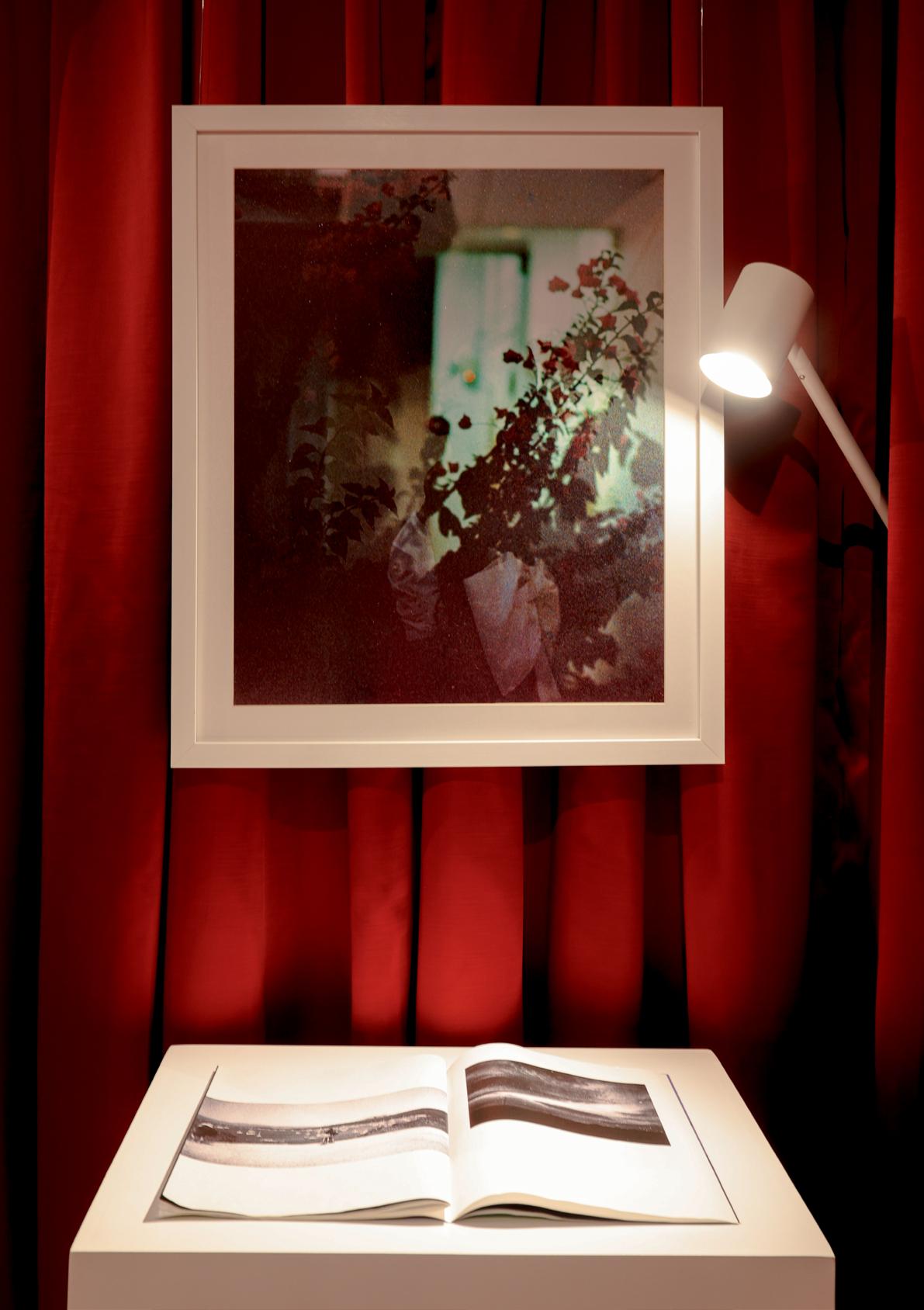
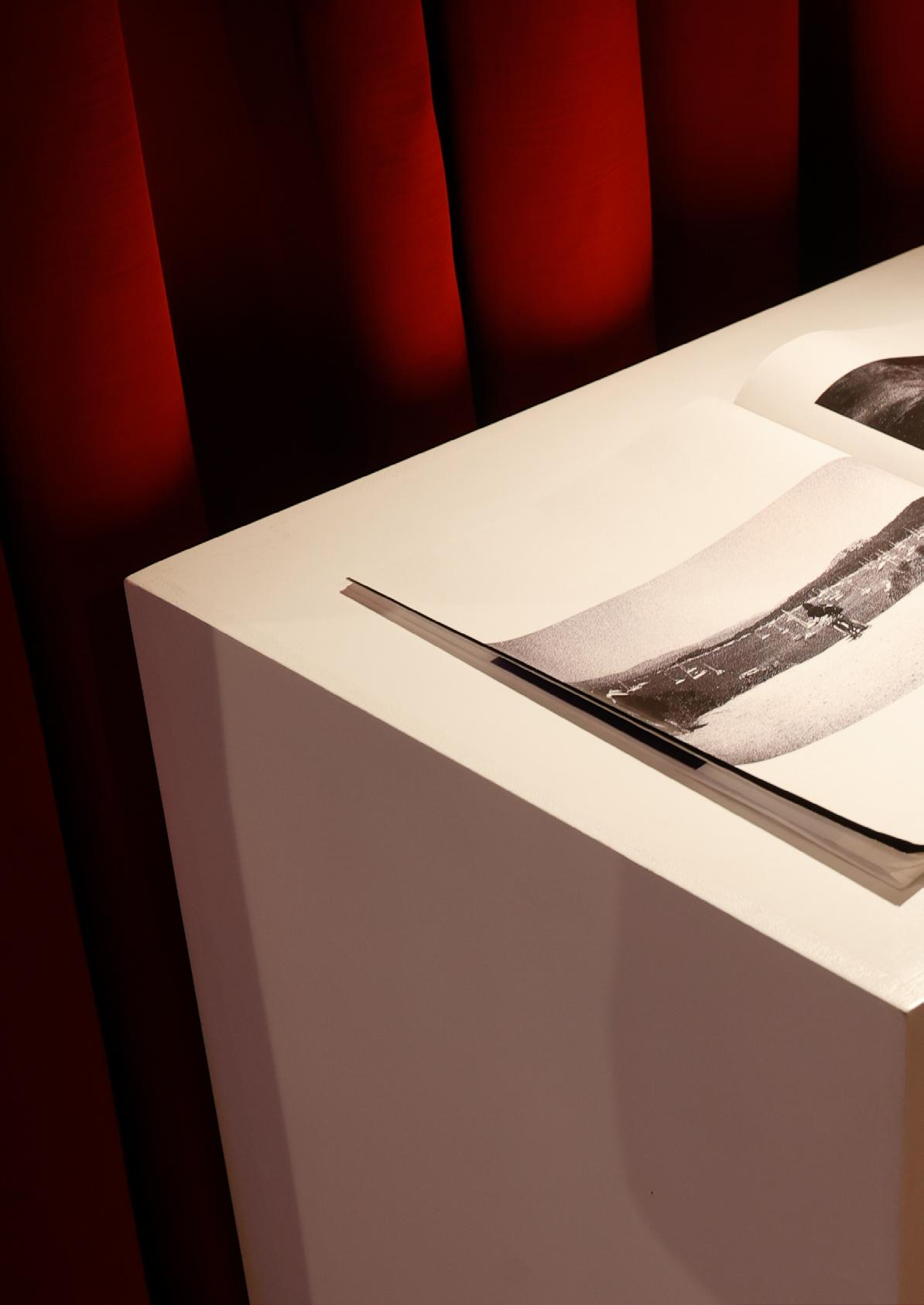
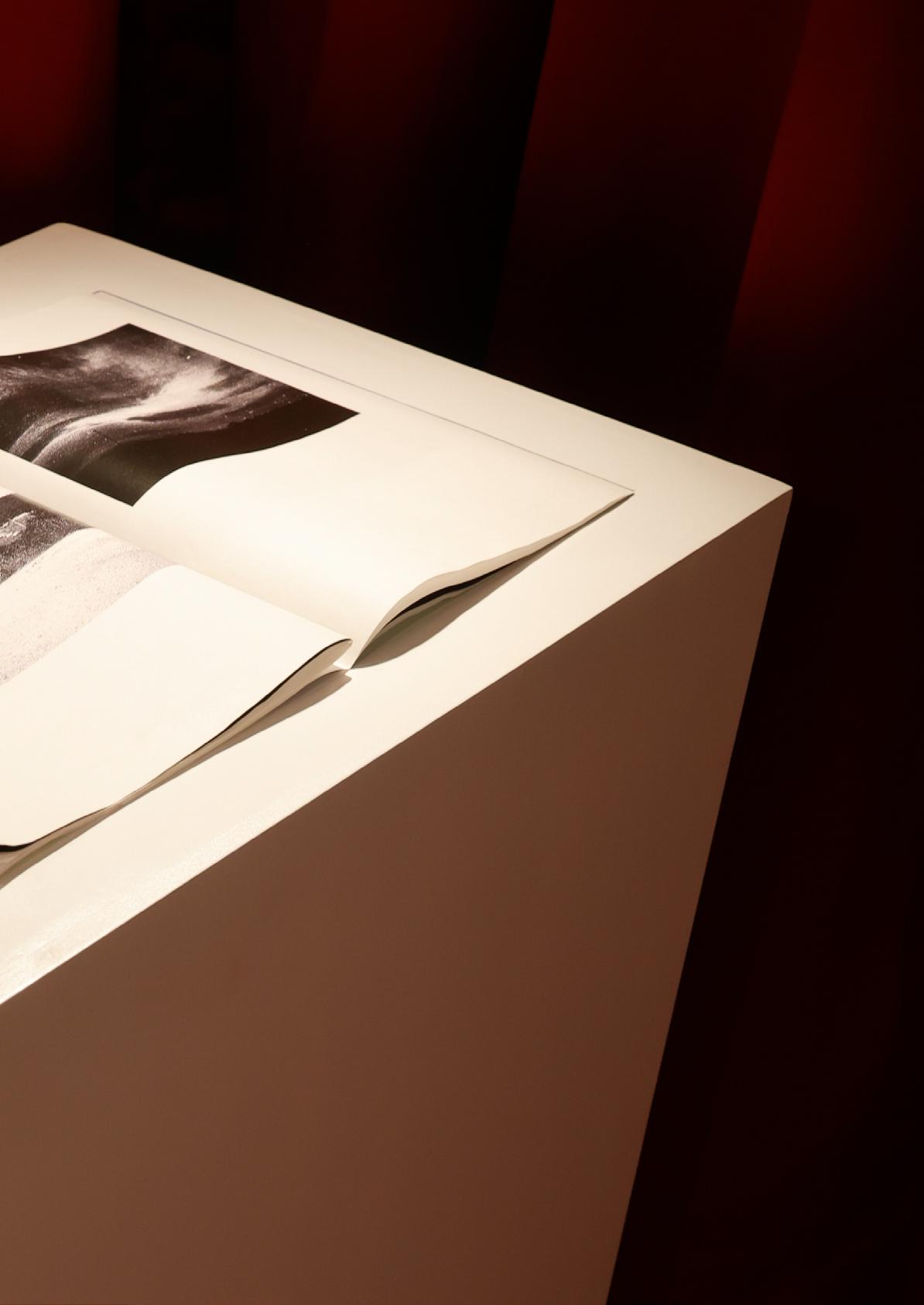 Daniah Al Saleh
Daniah Al Saleh
Love Songs (2022)
Two Channel Video (16:9)
25:24 min
“Love songs have always been a mode of indirect communication between two individuals in love, particularly in conservative societies where open declarations of love are considered taboo despite the proliferation of love songs on radio, TV and film. These songs were – and still are – used to express devotion under cultural constraints and strict rules of behavior. Love Stories by Daniah Al Saleh addresses the phenomena of love songs in society; the hidden stories they contain and the sentimental notions they leave in their wake.
Al Saleh has used machine learning to produce a video of “deep fakes” of ordinary people lip-syncing to a curated list of love songs popular in the MENA (Middle East and Northern Africa) region, which is then projected onto a building. These displays of emotion are created by dynamic use video mapping and music; “love words” taken from the song lyrics cascade down, written in English subtitles.
The intention behind displaying this work in public space, using deep fakes that resemble the everyday person, is to enable the audience to immerse themselves in these projected displays of emotion – as well as the sensations they trigger of longing and devotion. Special Thanks goes to Bader Alhelelat for Music editing with collaboration of Wall of Sound. Attributes: Small section of the following songs have been used only to be exhibited for Noor Riyadh.”
Text courtesy of Noor Riyadh.
Work commissioned by Noor Riyadh.

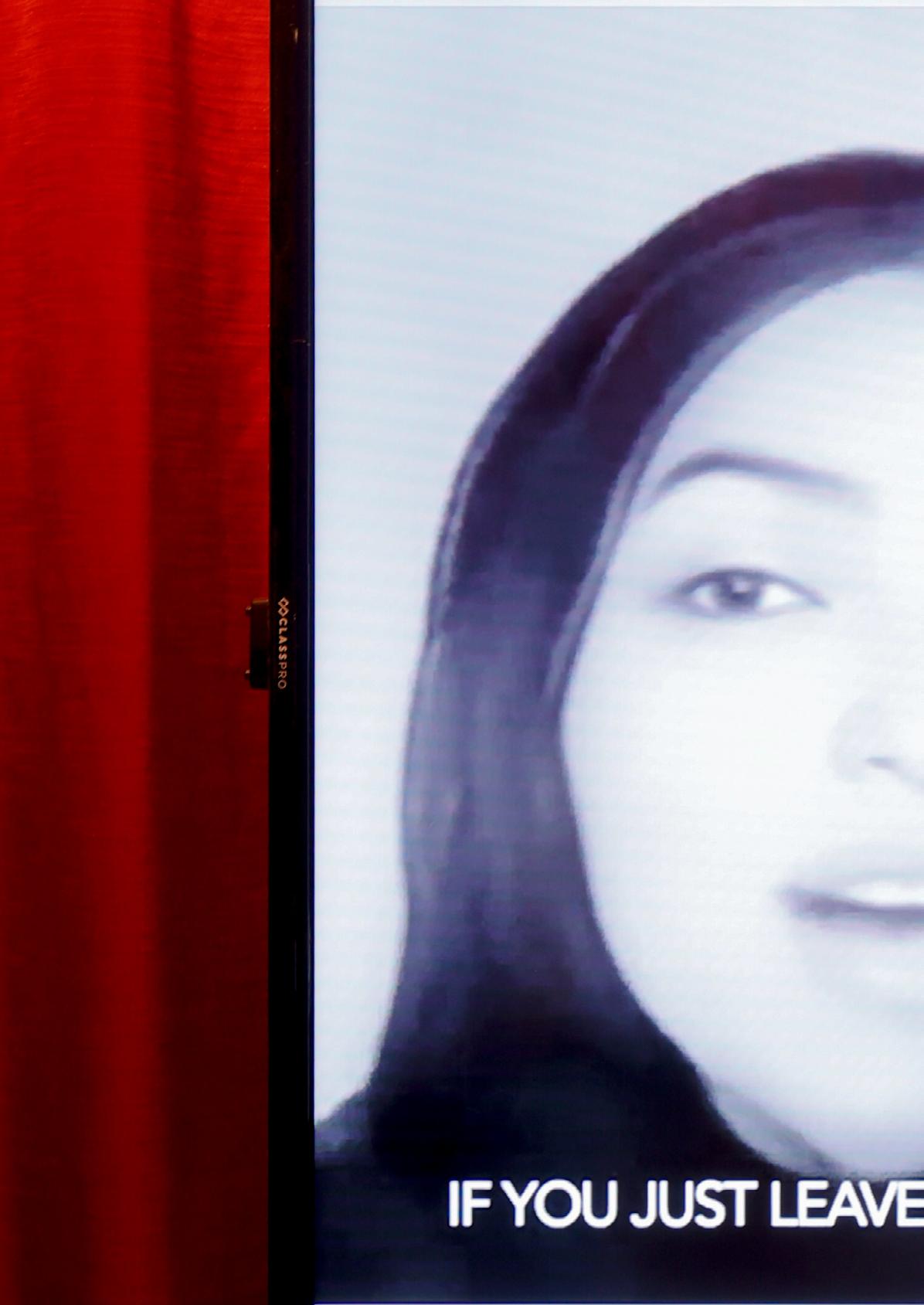
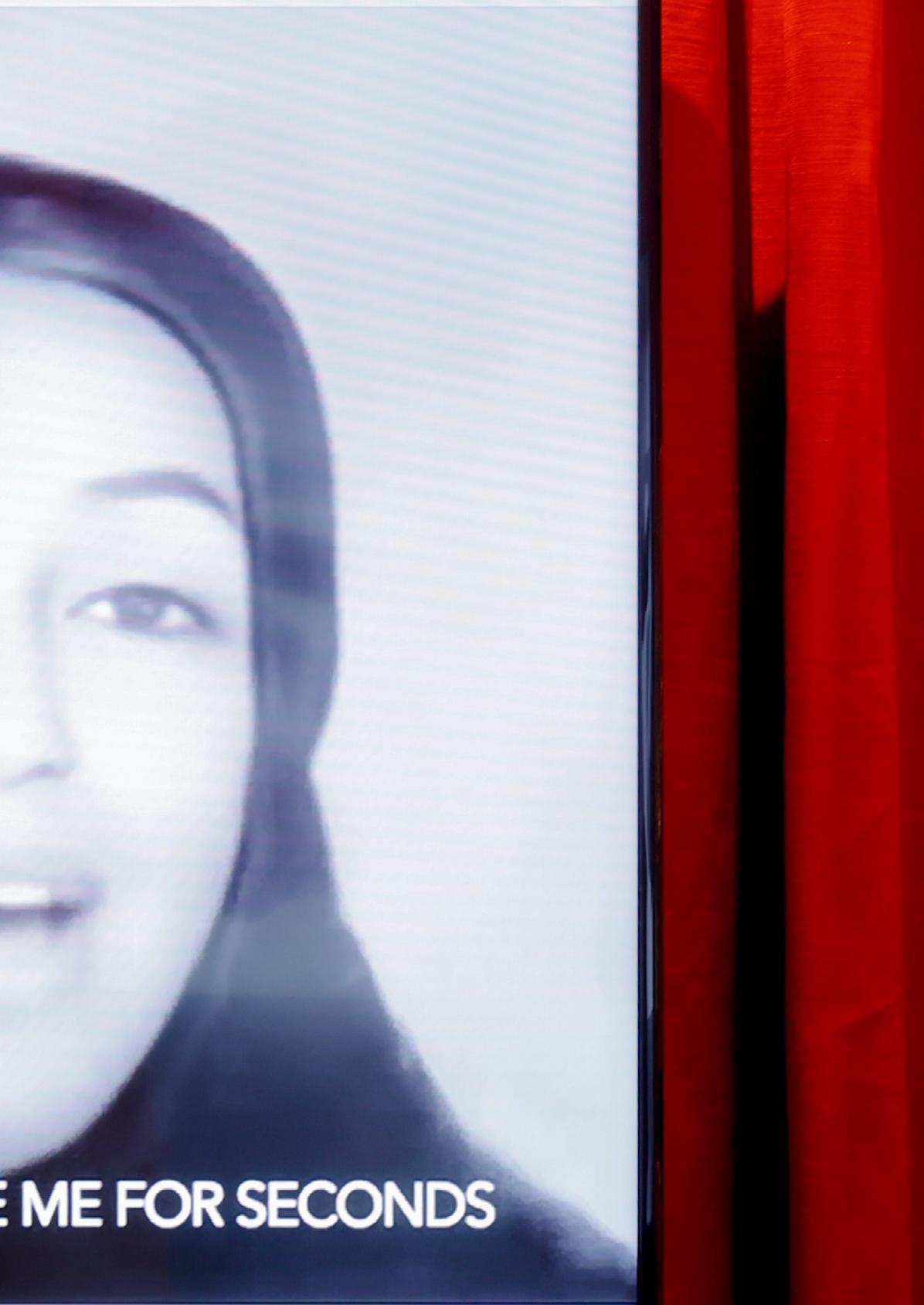 Rami Farook
Rami Farook
ول - If My Heart Was A Balcony (2023)
Site Specific Installation
2.5 x 2.5 x 2.8 meters
on heartache
Learn how to lend your heart
A heart returning ceremony
The stages of grief
Imagining if love didn’t exist
This show is about heartache not love
On sabbatical from heart cake & heart ache
Remembering all my crushes
Drew a lot of hearts for this exhibition
Shout out to very public for this gathering
I want to put my heart next to another for a minute
Taking care of our gut
It felt right at the time
Focusing on the heart here
Shout out to our hearts for everything
Sighs in the shape of a heart
Heart tongue connection
Is the heart cake worth the heart break
The balcony sign is like the title screen
The risk we take when falling in love
Good to give heart a break
Forgetting the heart high when its low
What does love mean?
Text supplied by artist
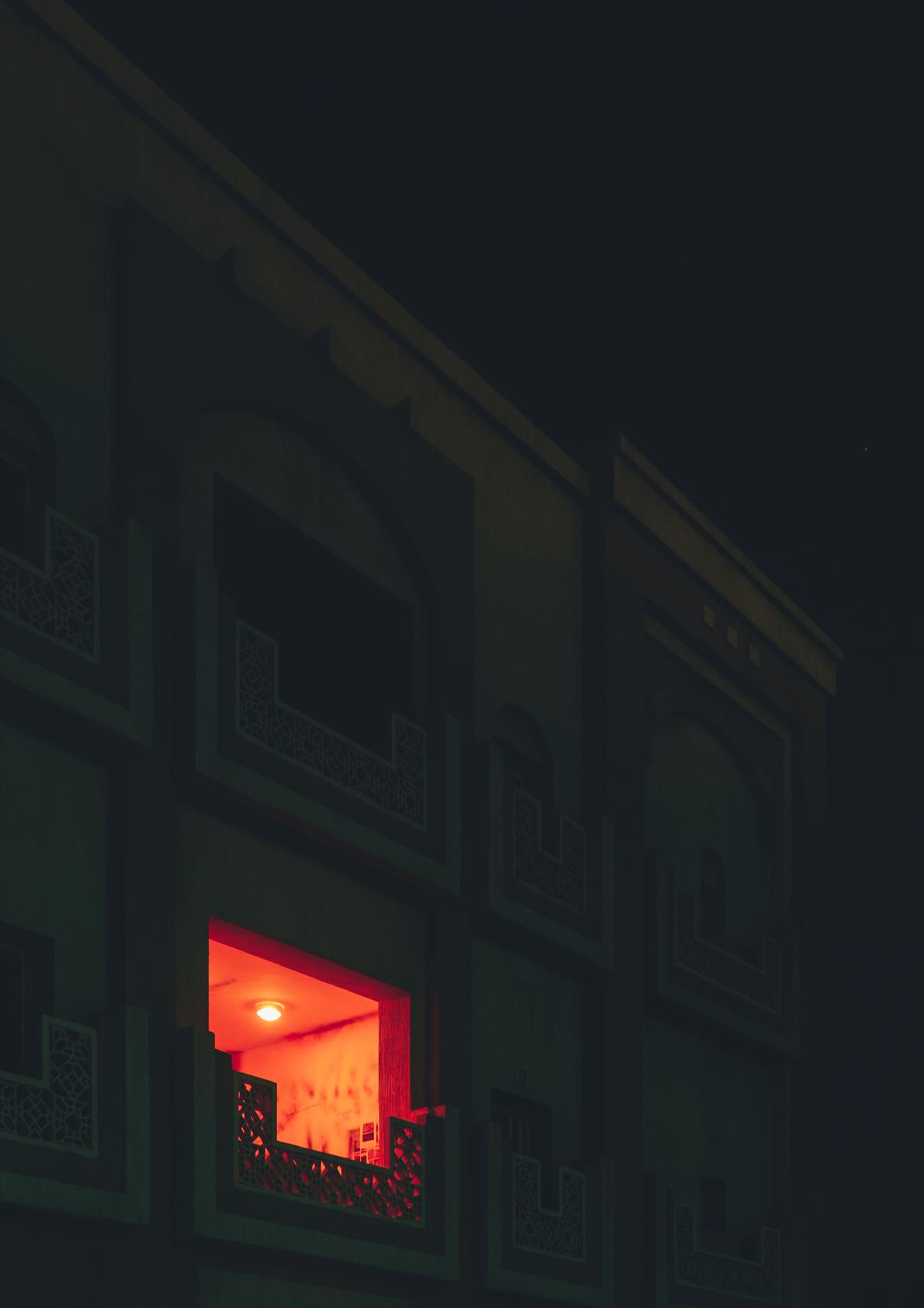
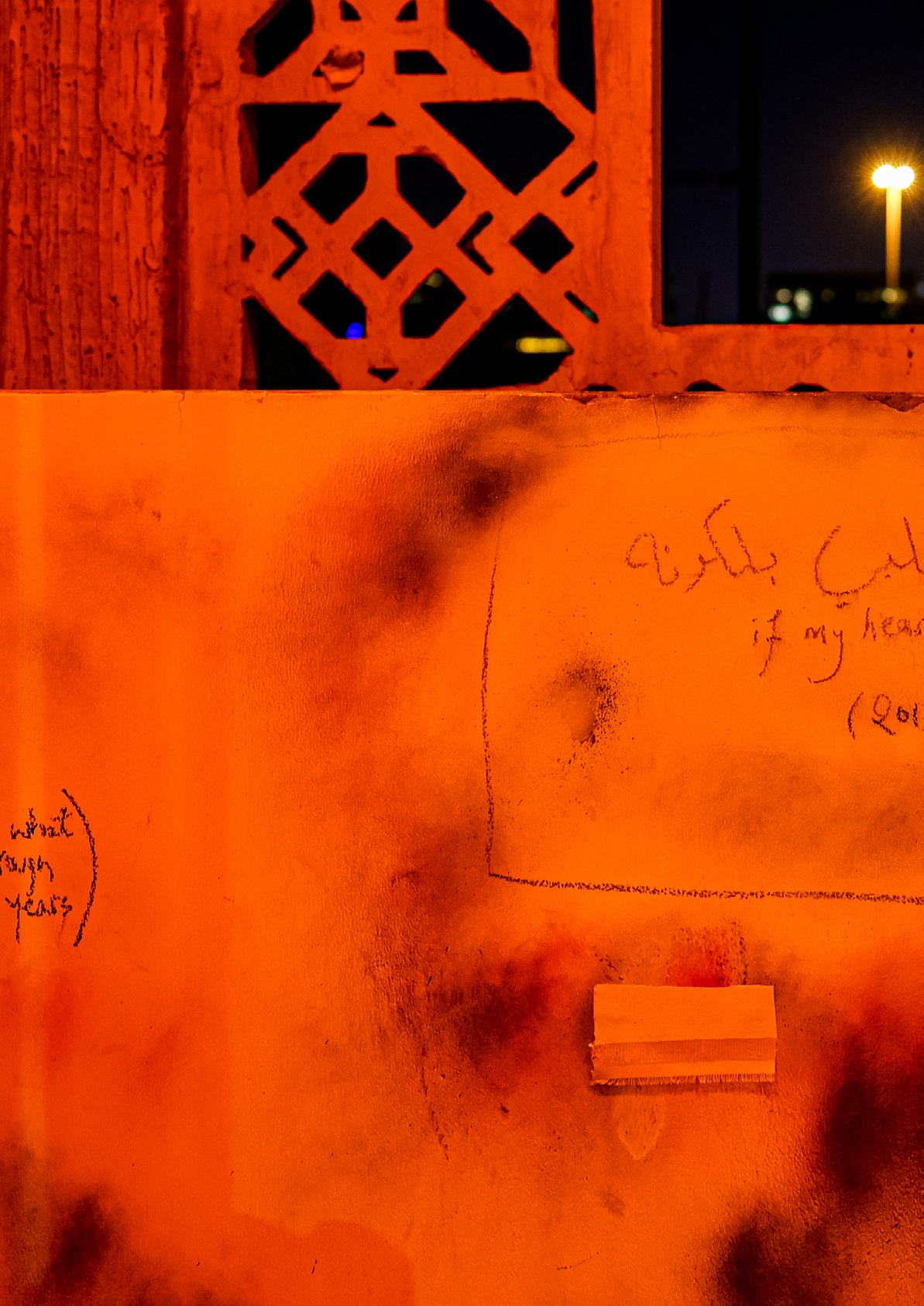
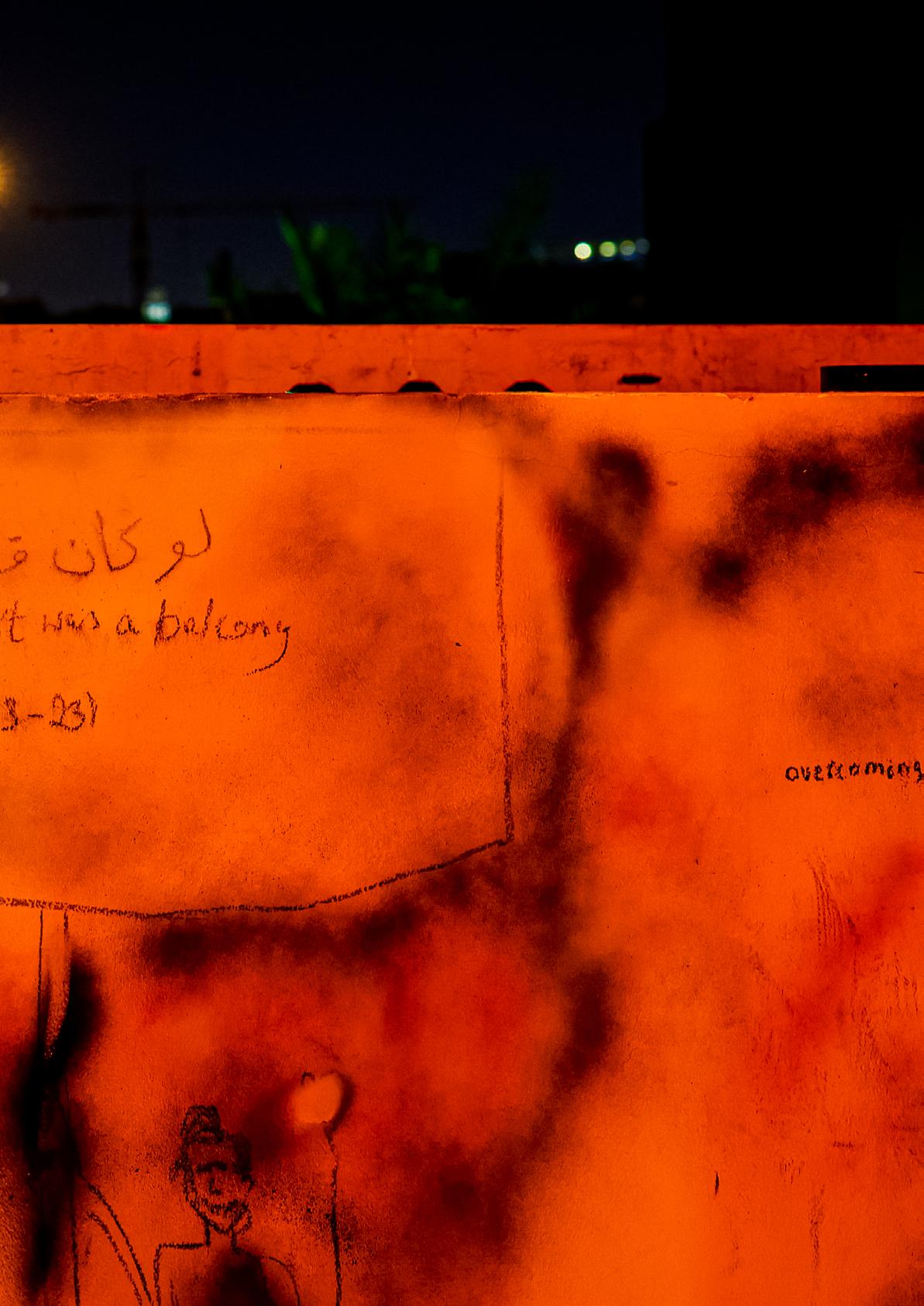
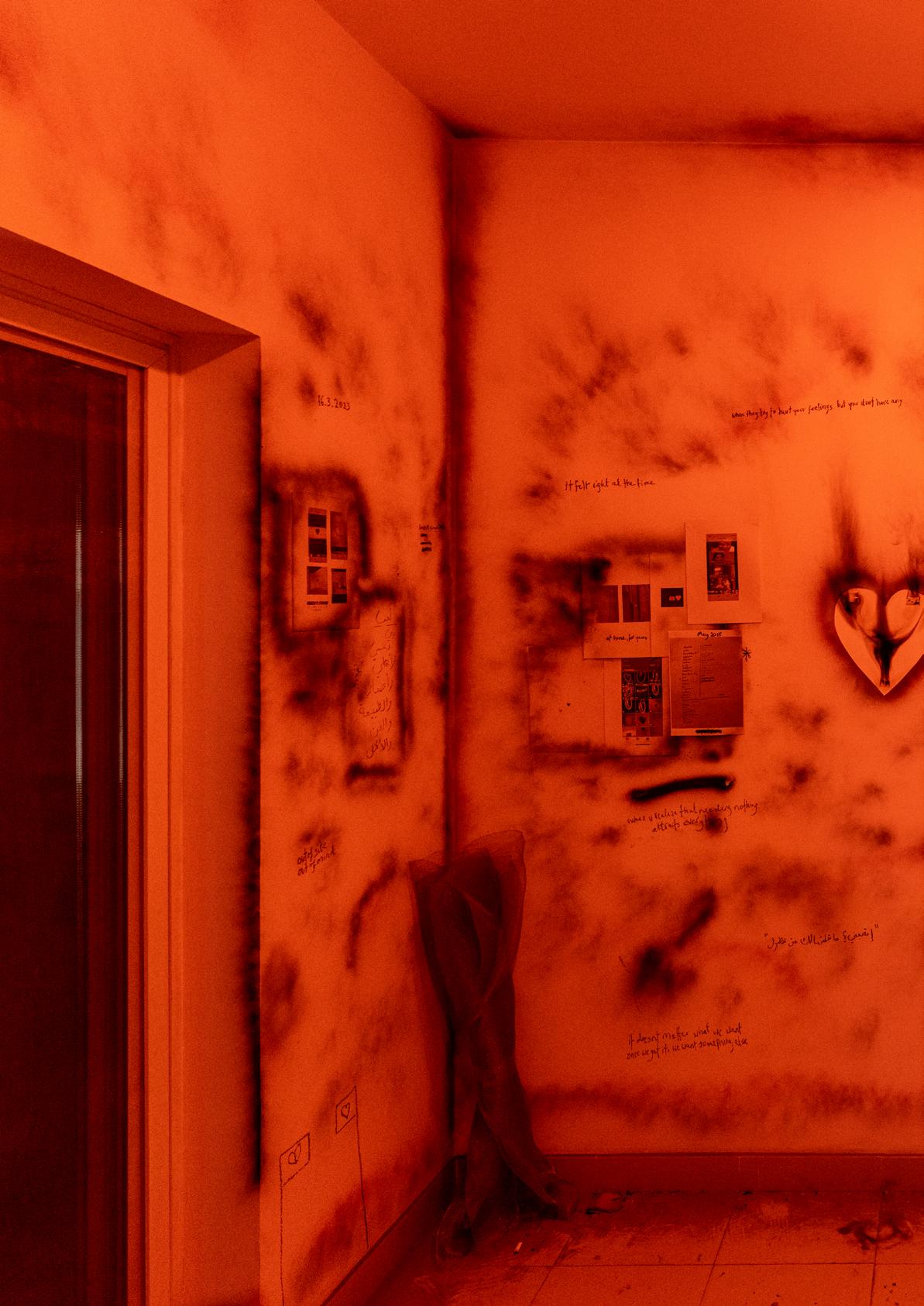
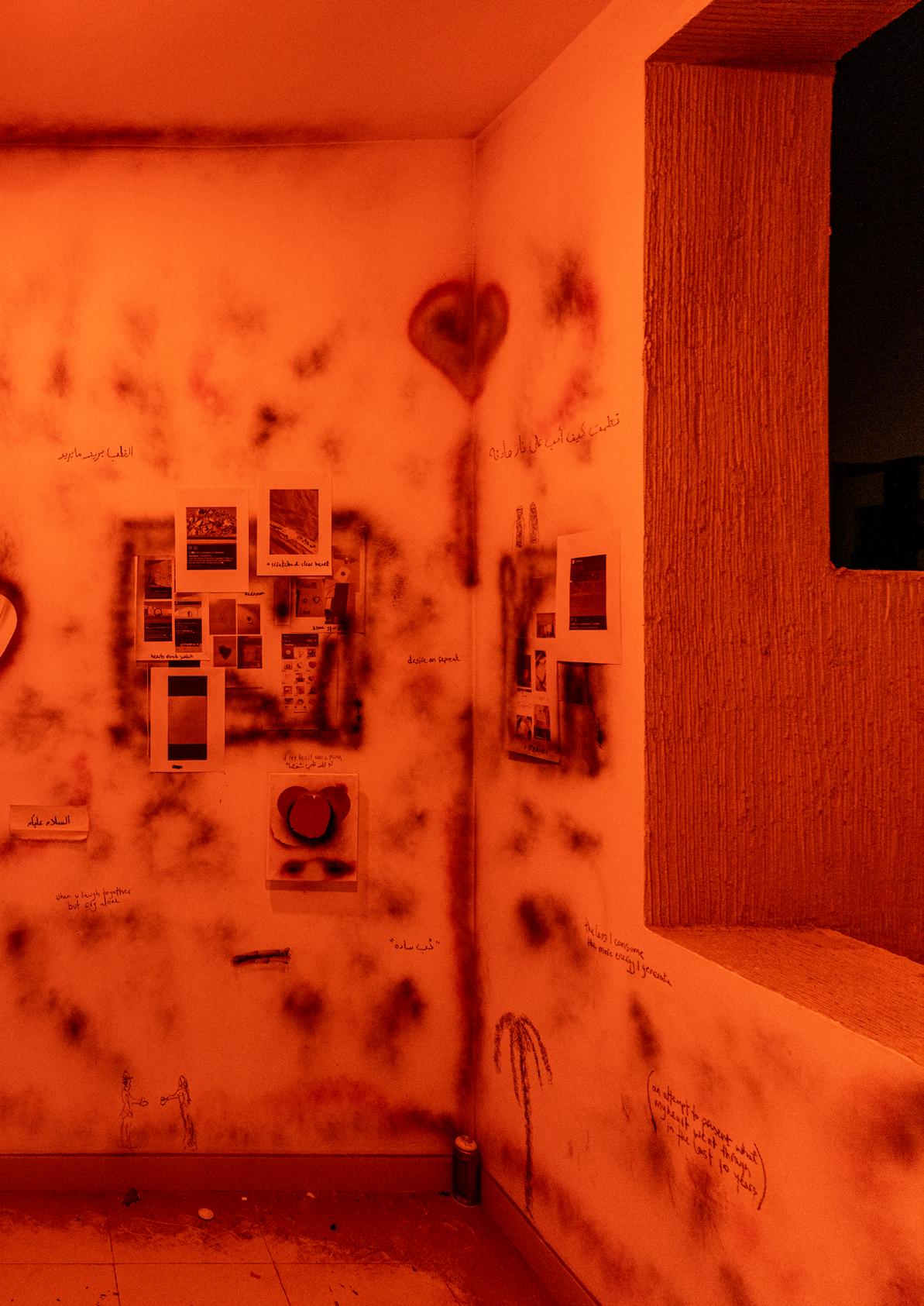
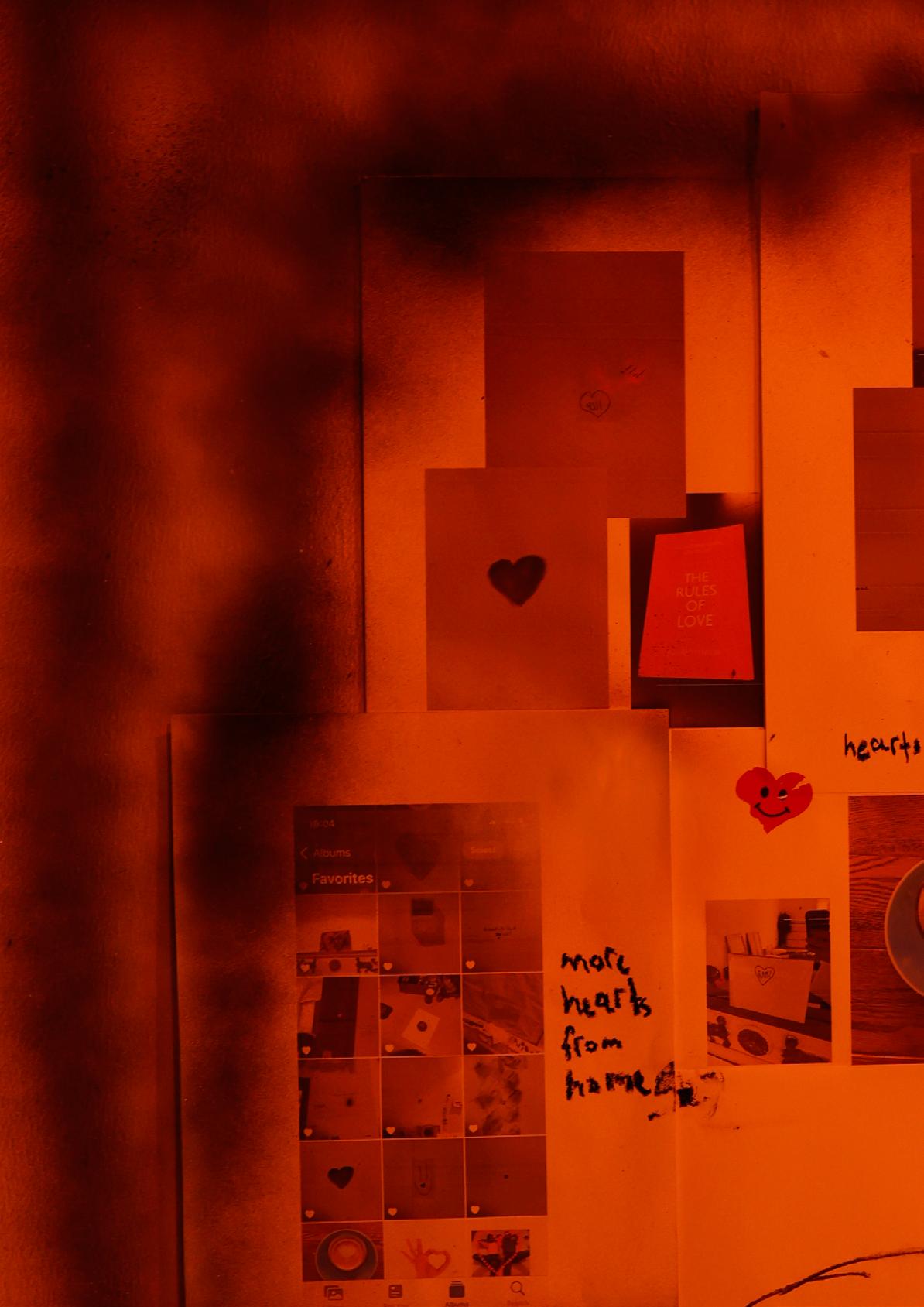
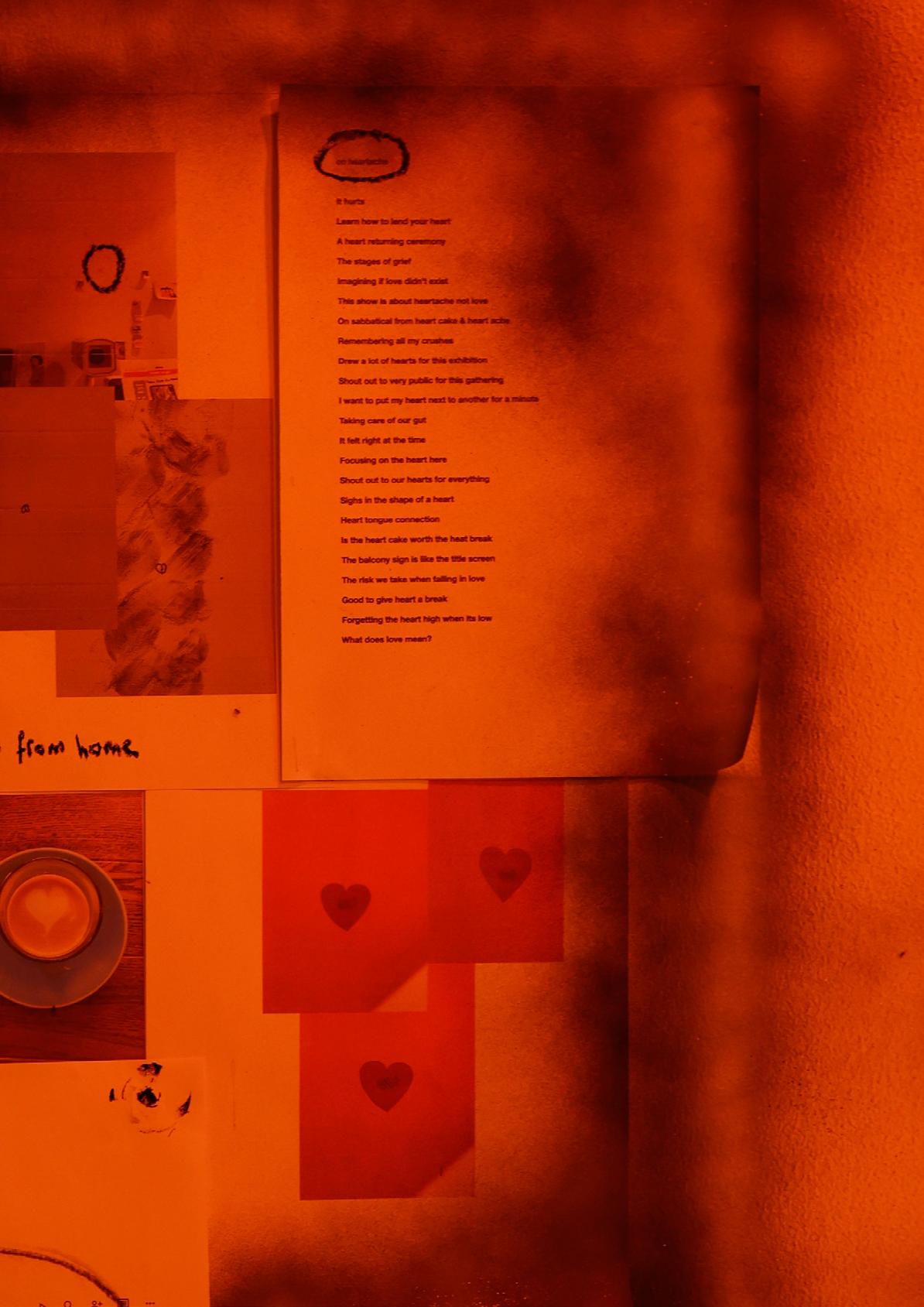
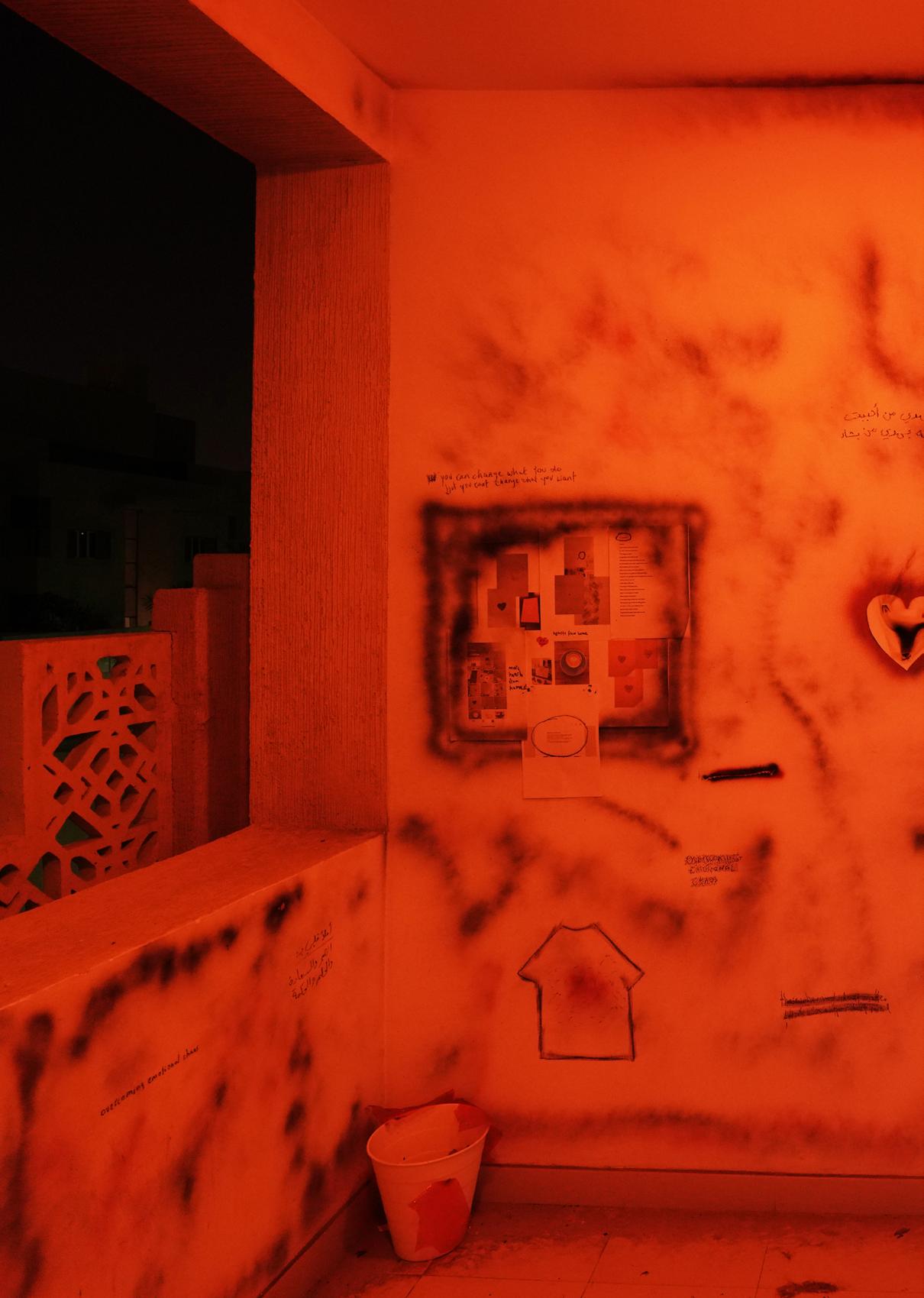
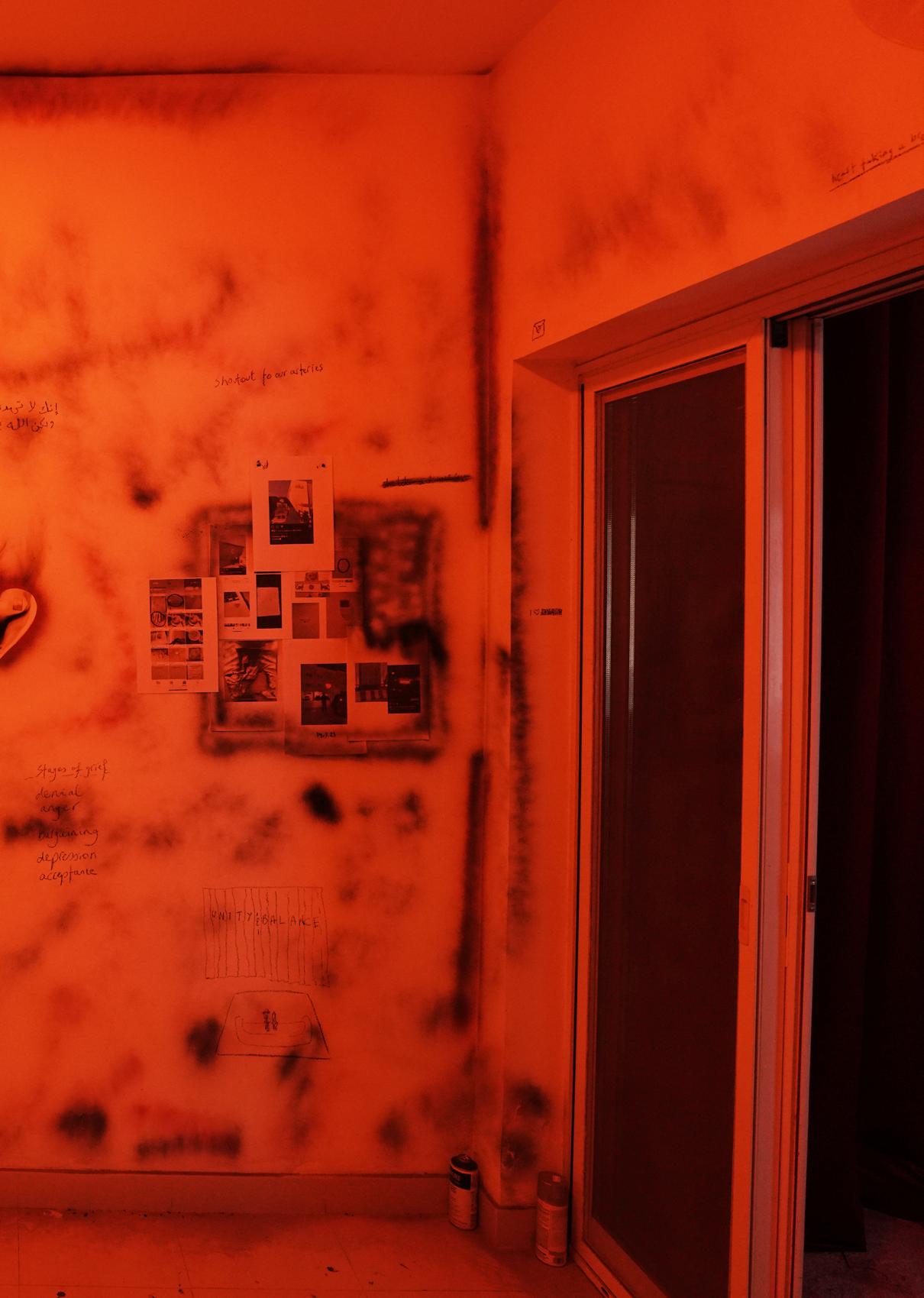
Jumairy
The Mission: Jumairy Loves You (2019)
Performance
As a continuation of The Mission, Jumairy’s cult have now started the second phase of their mission. In the second phase of this mission, the Jumairy cult are forcing a message of love on the audience... continously chanting “Jumairy Loves You”, reminding them of the endless love of Jumairy
Text supplied by artist


